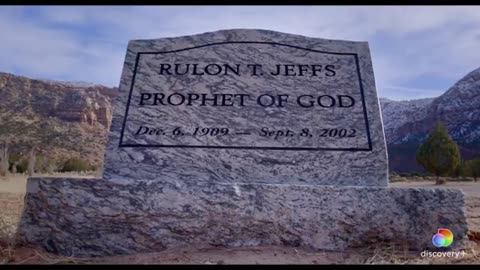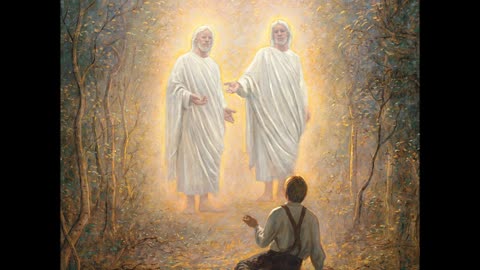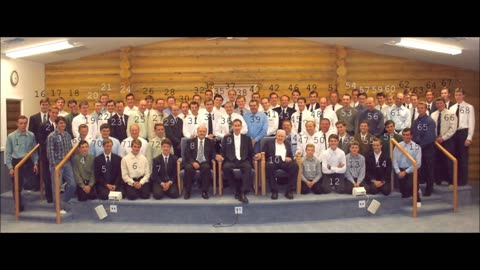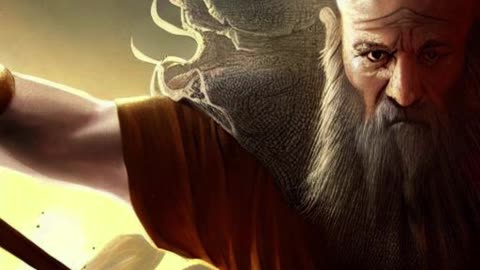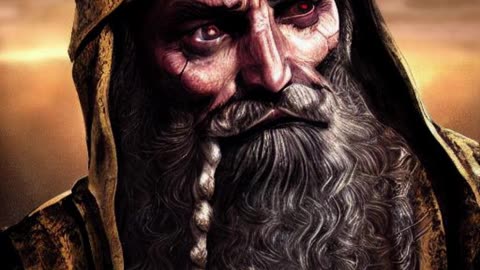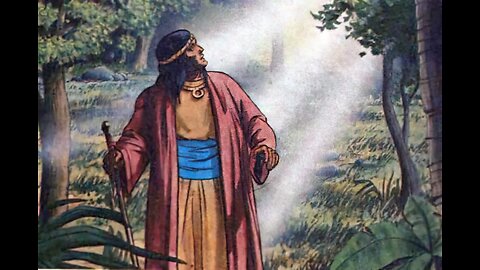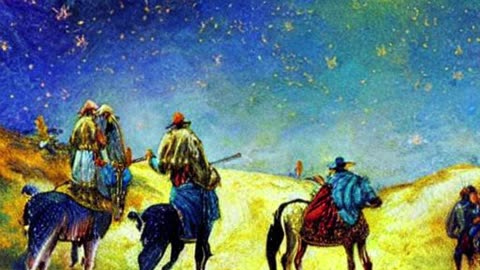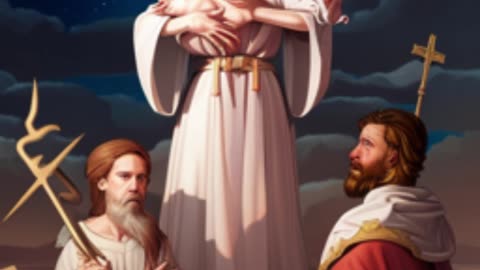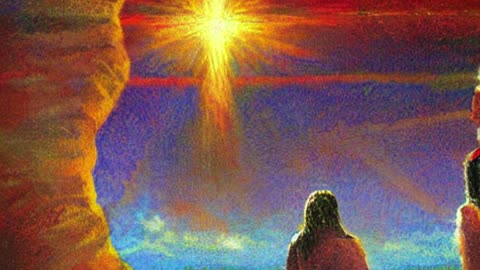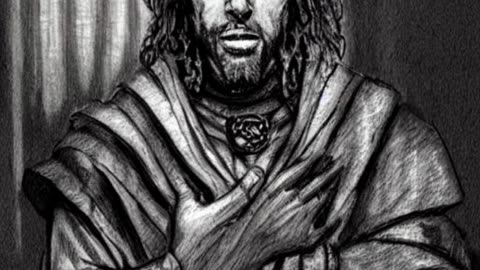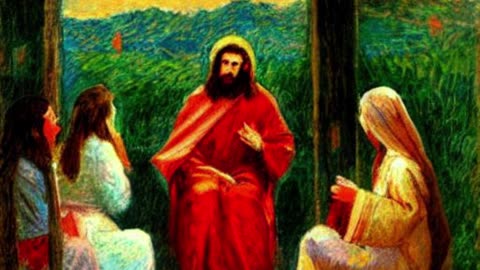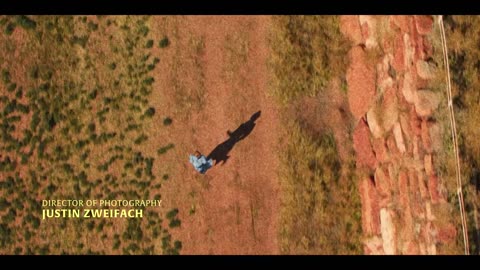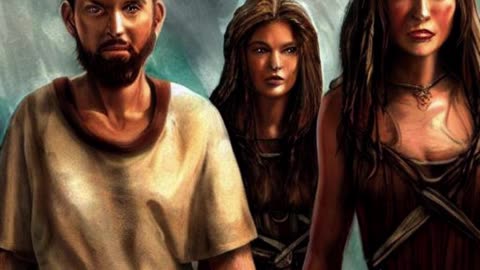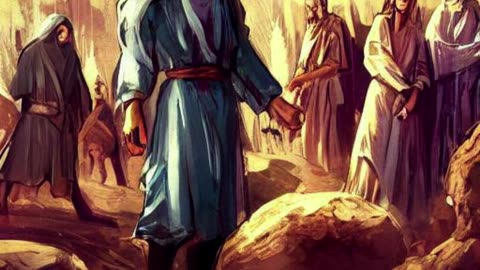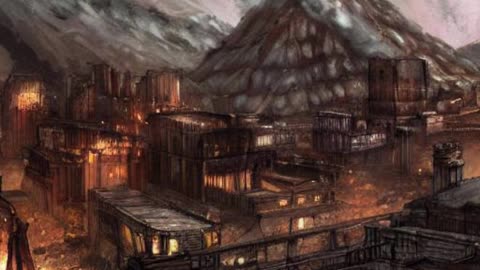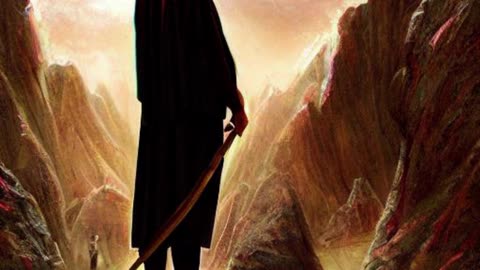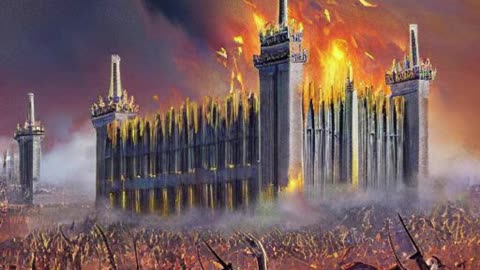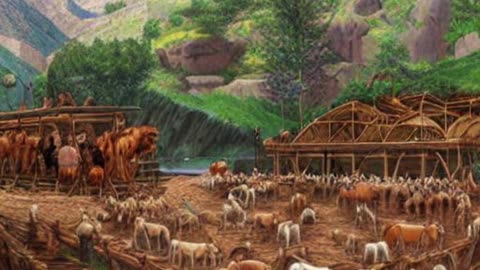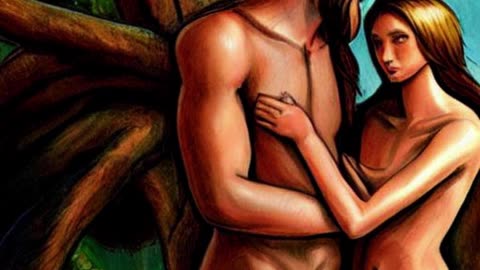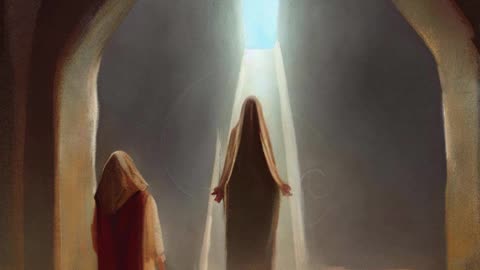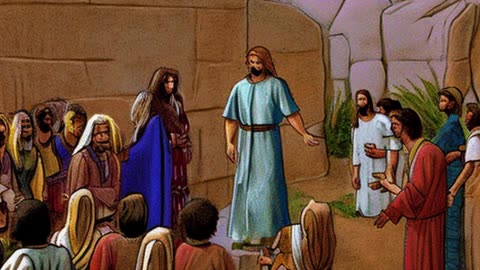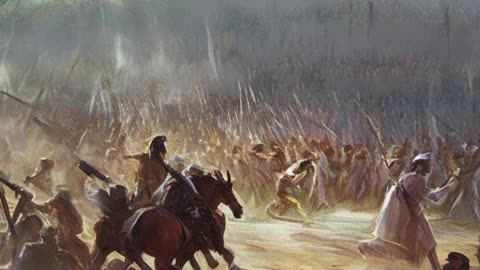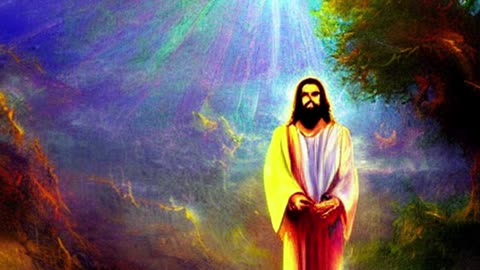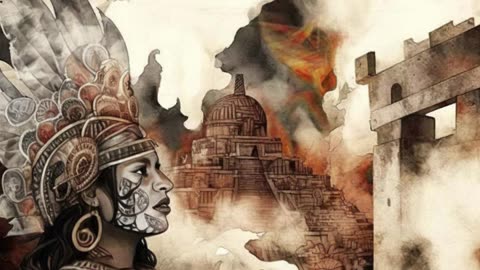Premium Only Content
This video is only available to Rumble Premium subscribers. Subscribe to
enjoy exclusive content and ad-free viewing.

Warren Jeffs
TheAmericanObserver
- 18 / 39
1
Warren Jeffs: FLDS Prophet or Dictator?
T
The Mormon Observer
Dec 26, 2021
A short and very biased documentary about FLDS leader and Prophet Warren Jeffs
2
Warren Jeffs - The Godhead
T
The Mormon Observer
The FLDS Prophet Warren Jeffs teaches us about The Godhead.
3
Warren Jeffs - Qualifying to be Lifted Up
T
The Mormon Observer
Original Source: https://www.youtube.com/watch?v=rAWT_u_xYN8
1,464 views Apr 6, 2015
This is one of the first sermons Warren delivered as leader of the FLDS. (11/21/02) This is such a fine overview of the FLDS beliefs.
4
Warren Jeffs - Nephi & Laban
T
The Mormon Observer
https://en.wikipedia.org/wiki/Warren_Jeffs
Audio Recordings of The FLDS Prophet Warren Jeffs, speaks on the topic of Nephi finding Laban.
Original Source: https://rumble.com/v23724o-flds-beliefs-nephi-kills-laban.html
5
Warren Jeffs - Moses & The Exodus of The Israelites
T
The Mormon Observer
https://en.wikipedia.org/wiki/Warren_Jeffs
Audio Recordings of The FLDS Prophet Warren Jeffs, speaks on the topic of Moses & The Exodus of The Israelites
6
Warren Jeffs - History of The Israelites
T
The Mormon Observer
https://en.wikipedia.org/wiki/Warren_Jeffs
Audio Recordings of The FLDS Prophet Warren Jeffs, speaks on the topic of the history of the Israelites.
Original Source: https://rumble.com/v22of4u-flds-beliefs-history-of-the-isrealites.html
7
Warren Jeffs - Mother Earth & The Sun
T
The Mormon Observer
https://en.wikipedia.org/wiki/Warren_Jeffs
Audio Recordings of The FLDS Prophet Warren Jeffs, speaks on the topic of Mother Earth, The Sun and The Planet Kolob.
Kolob is a star or planet described in the Book of Abraham, a sacred text of the Latter Day Saint movement. Several Latter Day Saint denominations hold the Book of Abraham to have been translated from an Egyptian papyrus scroll (which was actually a copy of the Egyptian funerary texts) by Joseph Smith, the founder of the movement. According to this work, Kolob is the heavenly body nearest to the throne of God. While the Book of Abraham calls Kolob a "star",[1] it also calls planets "stars",[2] and therefore some Latter Day Saint commentators consider Kolob a planet.[3] The body also appears in Latter Day Saint culture, including a reference to Kolob in an LDS hymn.[4]
Doctrine and exegesis
Description in the Book of Abraham
Facsimile No. 2 from the Book of Abraham, which Smith said discusses Kolob. The part Smith said refers to Kolob is numbered by a "1" in the center.
The first published reference to Kolob is in the Book of Abraham, first published in 1842 in Times and Seasons and now included within the Pearl of Great Price as part of the canon of Mormonism. The Book of Abraham 1:1–2:18 were dictated in 1835 and the remaining part in 1842 by Smith after he purchased a set of Egyptian scrolls that accompanied a mummy exhibition. According to Smith, the scrolls described a vision of Abraham, in which Abraham:
saw the stars, that they were very great, and that one of them was nearest unto the throne of God; ... and the name of the great one is Kolob, because it is near unto me, for I am the Lord thy God: I have set this one to govern all those which belong to the same order as that upon which thou standest.[1]
In an explanation of an Egyptian hypocephalus that was part of the Joseph Smith Papyri, Smith interpreted one set of hieroglyphics as representing:
Kolob, signifying the first creation, nearest to the celestial, or the residence of God. First in government, the last pertaining to the measurement of time. The measurement according to celestial time, which celestial time signifies one day to a cubit. One day in Kolob is equal to a thousand years according to the measurement of the Earth, which is called by the Egyptians Jah-oh-eh.[5]
The Book of Abraham describes a hierarchy of heavenly bodies,[6] including the Earth, the Moon, and the Sun, each with different movements and measurements of time, where at the pinnacle, the slowest-rotating body is Kolob, where one Kolob-day corresponds to 1000 Earth-years.[7] The time also applies to other celestial bodies in the vicinity of Kolob, such as Oliblish, and other neighboring objects.[8] This is similar to Psalm 90:4, which says, "For a thousand years in [God's] sight are but as yesterday when it is past" and 2 Peter 3:8, which says, "one day is with the Lord as a thousand years". Additional, similar information about Kolob is found in the Kirtland Egyptian Papers, constituting manuscripts in the handwriting of Smith and his scribes.
Mormon exegesis and speculation
According to the traditional, literal Mormon interpretation of the Book of Abraham, Kolob is an actual star in this universe that is, or is near, the physical throne of God. According to Smith, this star was discovered by Methuselah and Abraham[9] by looking through Urim and Thummim, a set of seer stones bound into a pair of spectacles.[10] LDS Church leader and historian B. H. Roberts (1857–1933) interpreted Smith's statements to mean that the Solar System and its governing "planet" (the Sun) revolved around a star known as Kae-e-vanrash, which itself revolved with its own solar system around a star called Kli-flos-is-es or Hah-ko-kau-beam, which themselves revolve around Kolob, which he characterized as "the great centre of that part of the universe to which our planetary system belongs".[11] Roberts was confident that astronomers would confirm this hierarchy of stars orbiting other stars.[12]
The literal interpretation of Kolob as a star or planet had significant formative impact on Mormon belief and criticism, leading to conceptions such as that the Biblical creation is a creation of the local Earth, Solar System, or galaxy, rather than the entire known physical universe.[citation needed]
Star versus planet
The Book of Abraham is unclear as to whether Kolob is a star or a planet,[2] and Mormon writings have taken both positions. One part of the Book of Abraham states that Abraham "saw the stars ... and that one of them was nearest unto the throne of God; ... and the name of the great one is Kolob."[1] But the book defines the word Kokaubeam (a transliteration of the Hebrew "כּוֹכָבִים" [c.f., Gen. 15:5]) as meaning "all the great lights, which were in the firmament of heaven".[13] This would appear to include planets as among the "stars",[14] and the Book of Abraham calls Earth a star.[15] In addition, it appears to classify Kolob among a hierarchy of "planets".[16] On the other hand, in the Egyptian Alphabet and Grammar paper, Kolob is classified as one of 12 "fixed stars", as distinct from 15 "moving planets".[17] The term "fixed stars" generally refers to the background of celestial objects that do not appear to move relative to each other in the night sky, including all stars other than the Sun, nebulae and other starlike objects. Though "fixed", such objects were proven to have proper motion by Edmund Halley in 1718. Apparently referring to proper motion, Smith said that Kolob moves "swifter than the rest of the twelve fixed stars".[18] Also, the Book of Abraham refers to "fixed planets",[19] thereby including planets in the set of celestial objects that may be "fixed". It also calls the Sun a "governing planet",[20] further complicating the terminology. So it is unclear whether Smith understood Kolob to be a planet or a star.
Writers in the Latter Day Saint movement have taken both positions on the issue. Brigham Young, second president of the Church of Jesus Christ of Latter-day Saints (LDS Church), spoke of Kolob as a planet,[21] as did LDS Church apostles John Taylor,[22] Orson Pratt (a mathematician with an interest in astronomy),[23] Orson F. Whitney,[24] and Alvin R. Dyer.[25] Other Mormon theologians have also viewed Kolob as a planet,[26] but several Mormon writers have called Kolob a star, including B. H. Roberts[27] and LDS Church president David O. McKay.[28]
Birthplace for the Earth
According to several Mormon writers (such as W. Cleon Skousen in his book The First 2000 Years), the Earth was created near Kolob over a period of 6,000 years, then moved to its present position in the Solar System.[29][30][31] This hypothesis is based on oral comments attributed to Smith.[26] The hypothesis is also based on a passage from the Book of Abraham stating that in the Garden of Eden, time was measured "after the Lord's time, which was after the time of Kolob; for as yet the Gods had not appointed to Adam his reckoning".[32] According to the hypothesis, the reason that Earth time was measured in Kolob time was that the Earth was near Kolob. As a corollary, some Mormon writers argue that at the end times, the Earth will be plucked from the Solar System and returned to its original orbit near Kolob.[33]
LDS Church apostle Bruce R. McConkie came to a different conclusion, arguing that during the first "day" of creation (not necessarily a 1,000-year "day" in Kolob time, a "day" meaning a phase of creation), Earth was formed and placed in orbit around the Sun.[34]
The idea that the Earth was formed elsewhere and then migrated to orbit around the Sun does not accord with the scientific understanding of Earth's formation, which is that the Earth formed in orbit around the Sun about 4.5 billion years ago by accretion from a protoplanetary disk, and has remained near its original orbit until the present.[35]
Speculative astronomy
Several Mormon authors have attempted to situate Kolob within modern astronomy. Skousen speculated that Kolob is a star at the Galactic Center, Sagittarius A*, of our own galaxy.[36] This view also had the support of several former general authorities of the LDS Church, including J. Reuben Clark[37] and George Reynolds (with Janne M. Sjödahl).[38] In the mid-19th century, early efforts to find a single "central sun" in the galaxy failed.[39]
Another Mormon author has hypothesized that Kolob exists outside the Milky Way at a place called the "metagalactic center", and that this galaxy and other galaxies rotate around it.[40] Within mainstream astronomy, the idea of a metagalactic center was once assumed,[41] but has been abandoned because on large scales, the expanding universe has no gravitational center.
Another Mormon author has speculated that Kolob is Polaris.[42]
Metaphorical exegesis
In addition to the literal interpretation of Kolob as an actual heavenly body, the LDS Church has proposed that Kolob is also "a symbol of Jesus Christ", in that like Kolob, Jesus "governs" all the stars and planets similar to the Earth.[43]
A metaphorical interpretation suggests that Kolob may be construed as a metaphor for Jesus.[citation needed]
Analysis and criticism
Origin
See also: Criticism of the Book of Abraham § Thomas Dick's A_Philosophy of a Future_State
Some Mormon scholars have sought to link the Kolob doctrine to ancient astronomy. Gee, Hamblin & Peterson (2006) have sought to show that this astronomy is more consistent with ancient geocentrism than with 19th-century Copernican and Newtonian astronomy, and thus carries with it the misconceptions of ancient astronomy.[44] For example, in their interpretation, Kolob is the highest and slowest moving of a series of concentric heavenly spheres, which are centered on Earth.[44] These authors believe that Smith, in the 19th century, would not have made this geocentric mistake about Kolob, and therefore, they argue that the Book of Abraham is of ancient origin.[44] John Tvedtnes suggested that "Another possible Hebrew etymology is the Hebrew KLB 'dog' originally pronounced kalb just as it is in Arabic. This is used to denote the star Regulus in Arabic while the Syriac, which is also kalb denotes the star Sirius, the brightest star in the heavens." He also suggested that the Hebraic use of "KLB" as both the word dog and an astronomical term refers to the universality of Sirius as the "Dog Star".[45]
According to Fawn Brodie, Smith's idea of Kolob may have been derived from the "throne of God" idea found in Thomas Dick's The Philosophy of a Future State,[46] which Brodie said Smith "had recently been reading" before dictating the Book of Abraham, and which "made a lasting impression" on him.[47]
In popular culture
"If You Could Hie to Kolob"
"If You Could Hie to Kolob"[48] (hie, hurry) is a Latter-day Saint hymn by early Mormon W. W. Phelps. The music is taken from a well-known folk tune known as "Dives and Lazarus". It was originally published in 1842 in Times and Seasons and is hymn number 284 in the LDS Church's current hymnal.[4] The hymn makes only one reference to Kolob, in its first line (from which the hymn's title is derived). It is the only hymn in the current hymnal that mentions Kolob.
The hymn reflects doctrines unique to Mormonism, such as the eternal nature of spirit (including man's spirit) and matter. It also conveys doctrines elaborated by Smith, the first Latter-day Saint prophet, about the plurality of gods and eternal progression.
The tune was arranged by Ralph Vaughan Williams (1906) for the English Hymnal and can be found in today's hymnals under the name "Kingsfold". The tune is also used in other hymns: "O Sing a Song of Bethlehem", "I Heard the Voice of Jesus", and "We Sing the Mighty Power of God".
The tune was also arranged for use in the film Plan 10 from Outer Space.
Kolob as the inspiration for Kobol in Battlestar Galactica
Some of the elements of the two Battlestar Galactica science-fiction television shows seem to be derived from the Mormon beliefs of its creator and chief producer, Glen A. Larson. In both the original series from 1978, and the 2003 new series, the planet Kobol is the ancient and distant mother world of the entire human race and the planet where life began, and the "Lords of Kobol" are sacred figures to the human race. They are treated as elders or patriarchs in the old series, and versions of the Twelve Olympians in the new series. According to academic Jana Riess, this is one of many plot points Larson has borrowed from Mormonism.[49][50]
Original Source: https://rumble.com/v22onme-flds-beliefs-mother-earth-kolob-and-the-sun-inhabitants.html
8
Warren Jeffs - The Plural Marriage of The Nephites
T
The Mormon Observer
https://en.wikipedia.org/wiki/Warren_Jeffs
Audio Recordings of The FLDS Prophet Warren Jeffs, speaks on the topic of
9
Warren Jeffs - Alma The Younger
T
The Mormon Observer
https://en.wikipedia.org/wiki/Warren_Jeffs
Audio Recordings of The FLDS Prophet Warren Jeffs, speaks on the topic of Alma The Younger.
In the Book of Mormon, Alma, the son of Alma (/ˈælmə/) is a Nephite prophet often referred to as Alma the Younger to distinguish him from his father, who is often referred to as Alma the Elder. These appellations, "the Younger" and "the Elder," are not used in the Book of Mormon; they are distinctions made by scholars, useful because both individuals were prominent during the same time period in the Book of Mormon's story and filled a similar cultural and religious role. Alma is the namesake of the Book of Alma.
Conversion
Part of a series on
People in the Book of Mormon
Lehi (far right, bearded) bestowing a blessing on his family. At least 21 different figures are visible (inclusive of infants and children). There is a mix of men, women, and children. A man in blue appears to be writing, perhaps transcribing what Lehi is saying. One infant is nursing. Several men have beards. All but the children wear hats or scarf-like head coverings. The fashion and style is reminiscent of nineteenth-century Christian art of Old Testament scenes. There is a vibrancy of color, with clothing in blues, greens, whites, and reds. The family gather in something like a circle, on a green, grassy field. There are tents visible in the background. This is cropped from a full version of the scene.
Lehi Blessing His Posterity, C. C. A. Christensen (1890)
Prophets and priests
Rulers
Judges
Military leaders
Other leaders
Others
List of Book of Mormon people
vte
Alma the Younger lived in Zarahemla during the end of the reign of the Nephite King Mosiah. Adherents of Mormonism believe that he was born in 126 BC. As a young man, he, the four sons of Mosiah, and others wanted to destroy the church and actively persecuted its members. After they were visited personally by an angel and rebuked for their actions, Alma fell into an unconscious state where for three days and three nights he lay unable to move until he felt within that he had been forgiven of his sins. He later recounted that he had experienced a vision during unconsciousness, in which he renounced his behavior against the church and subsequently received a glimpse of God sitting on his throne (Alma 36:12–22). He and those who persecuted church members with him abdicated their role as persecutors and became followers of Christ.[1]
Chief judge and high priest
Alma the Younger subsequently became the first elected chief judge of the Nephites as well as their religious leader.
When Amlici leads his followers in an insurrection against Nephite government, Alma as chief judge serves also as military commander and suppresses the Amlicites in the Amlicite Civil War.[2]
Ministry
He observed that the Nephites of the church were becoming increasingly wicked, proud, disdainful of outsiders and neglectful toward the poor and needy (Alma 4:11–12). When the "unbelievers" began to follow their example, Alma feared the entire people were on the path to self-destruction (Alma 4:11). He resigned his post as chief judge and began traveling from city to city to preach to the Nephites. He began in Zarahemla, where his efforts were successful. A thorough purge of the church leadership and membership took place, with those former insiders and leaders who refused to relinquish their pride being "rejected, and their names blotted out" (Alma 6:3).
Alma moved on to the cities of Gideon and Melek, where his call to humility was also well received. From Melek he traveled three days journey north to Ammonihah, whose inhabitants proved much more hardened than those of the previous three cities.[3]
In Ammonihah the people were very wicked. They considered themselves superior to outsiders, especially the Lamanites, and gloried in the strength of their city, which they considered indestructible. According to Alma chapter 9, Satan held such control over them that they would not listen to Alma. While trying to speak to them he was abused and thrown out of the city. Commanded by an angel to return, Alma slipped back into the city through a different route from the south. There he met Amulek, a lapsed believer (Alma 10:5-6) of some social prominence who fed Alma and housed him for a time. In the city streets, the two of them joined up and preached to the people, where they were challenged by a lawyer named Zeezrom. After Amulek had silenced Zeezrom through his teaching and aroused his conscience, Alma took his turn, preaching to the people with similar results. When finished, Alma and Amulek were cast into prison and delivered by a miracle.[4] A repentant Zeezrom eventually joined Alma in his missionary work.
Several years later, Alma met up with a man named Korihor, whom the Book of Mormon describes as an anti-Christ. This Korihor tried to lead the Nephites astray. Alma confronted him, confounding his arguments and miraculously removing Korihor's power of speech. The stricken Korihor signaled acknowledgement that he had acted maliciously, knowing all along that he was wrong and bringing destruction upon others. He was reduced to begging and was eventually run down and killed in a city of Nephite dissenters called Zoramites.[5]
These same Zoramites were found to practice things that perverted the ways of the Lord. This led Alma to extend his missionary work to these people. While among them, he was most successful with the poor.[6]
Alma's final instruction was to his sons, Helaman, Shiblon, and Corianton. He gave each separate lessons, and finally gave the records of the church to Helaman. He then departed, in the 19th year of the reign of the judges (or 73 BC) as if to go to Melek, but was never heard from again. Both Mormon and Helaman believed that he was taken up like Moses of old, and buried by the Lord.[7]
Descendants
The Book of Mormon narrative describes several of Alma's notable descendants as shown in the following family tree:
Alma the Elder
Alma the Younger
Helaman Shiblon Corianton
Helaman
Son of Helaman
Nephi
Son of Helaman Lehi
Son of Helaman
Nephi the Disciple Timothy
Son of Nephi
Nephi
Son of Nephi the Disciple
Amos
Son of Nephi
Amos
Son of Amos Ammaron
Son of Amos
Intertextuality
Alma's conversion is reminiscent of that of Saul of Tarsus, or Paul the Apostle, in the New Testament.[8] Both persecute the Christian church, abruptly encounter divine figures (Jesus appears to Saul; an angel confronts Alma) that physically incapacitate them, and open physically recovering subsequently convert and commit to Christianity.[9] Literary critic Michael Austin explains that by coexisting, these stories "encourage [readers] to universalize the possibility of conversion" and focus on the role of grace in Christian life.[10]
Original Source: https://rumble.com/v25849e-flds-beliefs-alma-the-younger.html
10
Warren Jeffs - Samuel & The Lamanites
T
The Mormon Observer
The FLDS Prophet and Leader Warren Jeffs, speaks on the topic of Samuel the Lamanite.
Original Source: https://rumble.com/v26dhpo-flds-beliefs-samuel-the-lamanite.html
https://en.wikipedia.org/wiki/Warren_Jeffs
11
Warren Jeffs - The Signs of Jesus
T
The Mormon Observer
https://en.wikipedia.org/wiki/Warren_Jeffs
Audio Recordings of The FLDS Prophet Warren Jeffs, speaks on the topic of the signs ahead of Jesus birth.
Original Source: https://rumble.com/v26zqas-flds-beliefs-signs-of-christ-birth.html
12
Warren Jeffs - Christ Birth
T
The Mormon Observer
https://en.wikipedia.org/wiki/Warren_Jeffs
Audio Recordings of The FLDS Prophet Warren Jeffs, speaks on the topic of Christ and his birth.
Original Source: https://rumble.com/v27rxik-flds-beliefs-birth-of-the-savior.html
13
Warren Jeffs - Signs of Christ In The Americas
T
The Mormon Observer
https://en.wikipedia.org/wiki/Warren_Jeffs
Audio Recordings of The FLDS Prophet Warren Jeffs, speaks on the topic of Christ in the Americas.
Original Source: https://rumble.com/v28wlay-flds-beliefs-signs-of-christ-death-in-america.html
14
Warren Jeffs - Judas Iscariot & Lazarus of Bethany
T
The Mormon Observer
https://en.wikipedia.org/wiki/Warren_Jeffs
Audio Recordings of The FLDS Prophet Warren Jeffs, speaks on the topic of Judas Iscariot and Lazarus of Bethany.
https://en.wikipedia.org/wiki/Lazarus_of_Bethany
Judas Iscariot (/ˈdʒuːdəs ɪˈskæriət/; Biblical Greek: Ἰούδας Ἰσκαριώτης Ioúdas Iskariṓtēs; Hebrew: יהודה איש קריות Yəhūda ʾĪš Qǝrīyyōṯ; died c. 30 – c. 33 AD) was—according to Christianity's four canonical gospels—a first-century Jewish man[1] who became a disciple and one of the original Twelve Apostles of Jesus Christ. Judas betrayed Jesus to the Sanhedrin in the Garden of Gethsemane by kissing him on the cheek and addressing him as "master" to reveal his identity in the darkness to the crowd who had come to arrest him in exchange for 30 pieces of silver.[2] Like Brutus, his name is often used synonymously with betrayal or treason.
The Gospel of Mark gives no motive for Judas's betrayal but does present Jesus predicting it at the Last Supper, an event also described in all the other gospels. The Gospel of Matthew 26:15 states that Judas committed the betrayal in exchange for thirty pieces of silver. The Gospel of Luke 22:3 and the Gospel of John 13:27 suggest that he was possessed by Satan. According to Matthew 27:1–10, after learning that Jesus was to be crucified, Judas attempted to return the money he had been paid for his betrayal to the chief priests and hanged himself.[3] The priests used the money to buy a field to bury strangers in, which was called the "Field of Blood" because it had been bought with blood money. The Book of Acts 1:18 quotes Peter as saying that Judas used the money to buy the field himself and, he "[fell] headlong... burst asunder in the midst, and all his bowels gushed out." His place among the Twelve Apostles was later filled by Matthias.
Due to his notorious role in all the gospel narratives, Judas remains a controversial figure in Christian history. His betrayal is seen as setting in motion the events that led to Jesus's crucifixion and resurrection, which, according to traditional Christian theology brought salvation to humanity. The Gnostic Gospel of Judas—rejected by the proto-orthodox Church as heretical—portrays Judas's actions as done in obedience to instructions given to him by Jesus, and that he alone amongst the disciples knew Jesus's true teachings. Since the Middle Ages, Judas has sometimes been portrayed as a personification of the Jewish people, and his betrayal has been used to justify Christian antisemitism.[4]
Historicity
Although Judas Iscariot's historical existence is generally widely accepted among secular historians,[5][6][7][8] this relative consensus has not gone entirely unchallenged.[6] The earliest possible allusion to Judas comes from the First Epistle to the Corinthians 11:23–24, in which Paul the Apostle does not mention Judas by name[9][10] but uses the passive voice of the Greek word paradídōmi (παραδίδωμι), which most Bible translations render as "was betrayed":[9][10] "...the Lord Jesus on the night when he was betrayed took a loaf of bread..."[9] Nonetheless, some biblical scholars argue that the word paradídōmi should be translated as "was handed over".[9][10] This translation could still refer to Judas,[9][10] but it could also instead refer to God metaphorically "handing Jesus over" to the Romans.[9]
In his book Antisemitism and Modernity (2006), the Jewish scholar Hyam Maccoby suggests that, in the New Testament, the name "Judas" was constructed as an attack on the Judaeans or on the Judaean religious establishment held responsible for executing Jesus.[11][12] In his book The Sins of Scripture (2009), John Shelby Spong concurs with this argument,[13][14] insisting, "The whole story of Judas has the feeling of being contrived ... The act of betrayal by a member of the twelve disciples is not found in the earliest Christian writings. Judas is first placed into the Christian story by the Gospel of Mark (3:19), who wrote in the early 70s CE."[13]
Most scholars reject these arguments for non-historicity,[7][15][16][17] noting that there is nothing in the gospels to associate Judas with Judeans except his name, which was an extremely common one for Jewish men during the first century,[15][18][10] and that numerous other figures named "Judas" are mentioned throughout the New Testament, none of whom are portrayed negatively.[15][18][10] Positive figures named Judas mentioned in the New Testament include the prophet Judas Barsabbas (Acts 15:22–33), Jesus's brother Jude (Mark 6:3; Matt 13:55; Jude 1), and the apostle Judas the son of James (Luke 6:14–16; Acts 1:13; John 14:22).[15]
Life
Name and background
Judas Iscariot (between 1886 and 1894) by James Tissot
The name "Judas" (Ὶούδας) is a Greek rendering of the Hebrew name Judah (יהודה, Yehûdâh, Hebrew for "praise or praised"), which was an extremely common name for Jewish men during the first century AD, due to the renowned hero Judas Maccabeus.[18][10] Consequently, numerous other figures with this name are mentioned throughout the New Testament.[15][18][10] In the Gospel of Mark 3:13–19, which was written in the mid-60s or early 70s AD, Judas Iscariot is the only apostle named "Judas".[10] Matthew 10:2–4 shares this portrayal.[10] The Gospel of Luke 6:12–19, however, replaces the apostle whom Mark and Matthew call "Thaddeus" with "Judas son of James".[10] Peter Stanford suggests that this renaming may represent an effort by the author of the Gospel of Luke to create a "good Judas" in contrast to the betrayer Judas Iscariot.[10]
Judas's epithet "Iscariot" (Ὶσκάριωθ or Ὶσκαριώτης), which distinguishes him from the other people named "Judas" in the gospels, is usually thought to be a Greek rendering of the Hebrew phrase איש־קריות, (Κ-Qrîyôt), meaning "the man from Kerioth".[18][10][19] This interpretation is supported by the statement in the Gospel of John 6:71 that Judas was "the son of Simon Iscariot".[10] Nonetheless, this interpretation of the name is not fully accepted by all scholars.[18][10] One of the most popular alternative explanations holds that "Iscariot" (ܣܟܪܝܘܛܐ, 'Skaryota' in Syriac Aramaic, per the Peshitta text) may be a corruption of the Latin word sicarius, meaning "dagger man",[18][10][20][21] which referred to a member of the Sicarii (סיקריים in Aramaic), a group of Jewish rebels who were known for committing acts of terrorism in the 40s and 50s AD by assassinating people in crowds using long knives hidden under their cloaks.[18][10] This interpretation is problematic, however, because there is nothing in the gospels to associate Judas with the Sicarii,[10] and there is no evidence that the cadre existed during the 30s AD when Judas was alive.[22][10]
A possibility advanced by Ernst Wilhelm Hengstenberg is that "Iscariot" means "the liar" or "the false one", from the Hebrew איש-שקרים. C. C. Torrey suggests instead the Aramaic form שְׁקַרְיָא or אִשְׁקַרְיָא, with the same meaning.[23][24] Stanford rejects this, arguing that the gospel writers follow Judas's name with the statement that he betrayed Jesus, so it would be redundant for them to call him "the false one" before immediately stating that he was a traitor.[10] Some have proposed that the word derives from an Aramaic word meaning "red color", from the root סקר.[25] Another hypothesis holds that the word derives from one of the Aramaic roots סכר or סגר. This would mean "to deliver", based on the Septuagint rendering of Isaiah 19:4—a theory advanced by J. Alfred Morin.[24] The epithet could also be associated with the manner of Judas's death, hanging. This would mean Iscariot derives from a kind of Greek-Aramaic hybrid: אִסְכַּרְיוּתָא, Iskarioutha, meaning "chokiness" or "constriction". This might indicate that the epithet was applied posthumously by the remaining disciples, but Joan E. Taylor has argued that it was a descriptive name given to Judas by Jesus, since other disciples such as Simon Peter/Cephas (Kephas "rock") were also given such names.[24]
Role as an apostle
Calling of the Apostles (1481) by Domenico Ghirlandaio
Although the canonical gospels frequently disagree on the names of some of the minor apostles,[26] all four of them list Judas Iscariot as one of them.[26][10] The Synoptic Gospels state that Jesus sent out "the twelve" (including Judas) with power over unclean spirits and with a ministry of preaching and healing: Judas clearly played an active part in this apostolic ministry alongside the other eleven.[27] However, in the Gospel of John, Judas's outlook was differentiated—many of Jesus's disciples abandoned him because of the difficulty of accepting his teachings, and Jesus asked the twelve if they would also leave him. Simon Peter spoke for the twelve: "Lord, to whom shall we go? You have the words of eternal life," but Jesus observed then that despite the fact that he himself had chosen the twelve, one of them (unnamed by Jesus, but identified by the narrator) was "a devil" who would betray him.[28]
One of the best-attested and most reliable statements made by Jesus in the gospels comes from the Gospel of Matthew 19:28, in which Jesus tells his apostles: "in the new world, when the Son of Man shall sit on his glorious throne, you will also sit on twelve thrones, judging the Twelve Tribes of Israel."[26] New Testament scholar Bart D. Ehrman concludes, "This is not a tradition that was likely to have been made up by a Christian later, after Jesus's death—since one of these twelve had abandoned his cause and betrayed him. No one thought that Judas Iscariot would be seated on a glorious throne in the Kingdom of God. That saying, therefore appears to go back to Jesus, and indicates, then, that he had twelve close disciples, whom he predicted would reign in the coming Kingdom."[26]
A 16th century fresco depicting Judas being paid the 30 pieces of silver
Matthew directly states that Judas betrayed Jesus for a bribe of "thirty pieces of silver"[29][30] by identifying him with a kiss—"the kiss of Judas"—to arresting soldiers of the High Priest Caiaphas, who then turned Jesus over to Pontius Pilate's soldiers. Mark's Gospel states that the chief priests were looking for a way to arrest Jesus. They decided not to do so during the feast [of the Passover], since they were afraid that people would riot;[31] instead, they chose the night before the feast to arrest him. According to Luke's account, Satan entered Judas at this time.[32]
According to the account in the Gospel of John, Judas carried the disciples' money bag or box (γλωσσόκομον, glōssokomon),[33] but the Gospel of John makes no mention of the thirty pieces of silver as a fee for betrayal. The evangelist comments in John 12:5–6 that Judas spoke fine words about giving money to the poor, but the reality was "not that he cared for the poor, but [that] he was a thief, and had the money box; and he used to take what was put in it." However, in John 13:27–30, when Judas left the gathering of Jesus and his disciples with betrayal in mind,[34] some [of the disciples] thought that Judas might have been leaving to buy supplies or on a charitable errand.
Ehrman argues that Judas's betrayal "is about as historically certain as anything else in the tradition",[5][18] pointing out that the betrayal is independently attested in the Gospel of Mark, in the Gospel of John, and in the Book of Acts.[5][18] Ehrman also contends that it is highly unlikely that early Christians would have made up the story of Judas's betrayal, since it reflects poorly on Jesus's judgment in choosing him as an apostle.[5][35] Nonetheless, Ehrman argues that what Judas actually told the authorities was not Jesus's location, but rather Jesus's secret teaching that he was the Messiah.[5] This, he holds, explains why the authorities did not try to arrest Jesus prior to Judas's betrayal.[5] John P. Meier sums up the historical consensus, stating, "We only know two basic facts about [Judas]: (1) Jesus chose him as one of the Twelve, and (2) he handed over Jesus to the Jerusalem authorities, thus precipitating Jesus's execution."[36]
Death
16th-century fresco from Tarzhishte Monastery, Strupets, Bulgaria, showing Judas hanging himself as described in Matthew 27:1–10
Many different accounts of Judas's death have survived from antiquity, both within and outside the New Testament.[37][38] Matthew 27:1–10 states that after learning that Jesus was to be crucified, Judas was overcome by remorse and attempted to return the 30 pieces of silver to the priests, but they would not accept them because they were blood money, so he threw them on the ground and left. Afterwards, he committed suicide by hanging himself[39] according to Mosaic law (Deuteronomy 21:22–23[40]). The priests then used the money to buy a potter's field, which became known as Akeldama (חקל דמא – khakel dama) – the Field of Blood – because it had been bought with blood money.[39] Acts 1:18 states that Judas used the money to buy a field,[39][41] and "[fell] headlong... burst asunder in the midst, and all his bowels gushed out."[39] In this account, Judas's death is apparently by accident,[39] and he shows no signs of remorse.[39]
The early Church Father Papias of Hierapolis records in his Expositions of the Sayings of the Lord (which was probably written around 100 AD) that Judas was afflicted by God's wrath;[42][43] his body became so enormously bloated that he could not pass through a street with buildings on either side.[42][43] His face became so swollen that a doctor could not even identify the location of his eyes using an optical instrument.[42] Judas's genitals became enormously swollen and oozed with pus and worms.[42] Finally, he killed himself on his own land by pouring out his innards onto the ground,[42][43] which stank so horribly that, even in Papias's own time a century later, people still could not pass the site without holding their noses.[42][43] This story was well known among Christians in antiquity[43] and was often told in competition with the two conflicting stories from the New Testament.[43]
According to the apocryphal Gospel of Nicodemus, which was probably written in the fourth century AD, Judas was overcome with remorse[44] and went home to tell his wife, who was roasting a chicken on a spit over a charcoal fire, that he was going to kill himself, because he knew Jesus would rise from the dead and, when he did, he would punish him.[44] Judas's wife laughed and told him that Jesus could no more rise from the dead than he could resurrect the chicken she was cooking.[37] Immediately, the chicken was restored to life and began to crow.[42] Judas then ran away and hanged himself.[42] In the apocryphal Gospel of Judas, Judas has a vision of the disciples stoning and persecuting him.[45]
The discrepancy between the two different accounts of Judas's death in Matthew 27:1–10 and Acts 1:18 has proven to be a serious challenge to those who support the idea of Biblical inerrancy.[44][43] This problem was one of the points leading C. S. Lewis, for example, to reject the view "that every statement in Scripture must be historical truth".[46] Nonetheless, various attempts at harmonization have been suggested.[43] Generally they have followed literal interpretations such as that of Augustine of Hippo, which suggest that these simply describe different aspects of the same event—that Judas hanged himself in the field, and the rope eventually snapped and the fall burst his body open,[47][48] or that the accounts of Acts and Matthew refer to two different transactions.[49] Some have taken the descriptions as figurative: that the "falling prostrate" was Judas in anguish,[a] and the "bursting out of the bowels" is pouring out emotion.[b]
Modern scholars reject these approaches.[50][51][52] Arie W. Zwiep states "neither story was meant to be read in light of the other"[43] and "the integrity of both stories as complete narratives in themselves is seriously disrespected when the two separate stories are being conflated into a third, harmonized version."[43] David A. Reed argues that the Matthew account is a midrashic exposition that allows the author to present the event as a fulfillment of prophetic passages from the Old Testament. They argue that the author adds imaginative details such as the thirty pieces of silver, and the fact that Judas hangs himself, to an earlier tradition about Judas's death.[53]
Matthew's description of the death as fulfilment of a prophecy "spoken through Jeremiah the prophet" has caused difficulties, since it does not clearly correspond to any known version of the Book of Jeremiah but does appear to refer to a story from the Book of Zechariah[54] which describes the return of a payment of thirty pieces of silver.[55] Even writers such as Jerome and John Calvin conclude that this was obviously an error.[c] Evangelical theologian James R. White has suggested the misattribution arises from a supposed Jewish practice of using the name of a major prophet to refer to the whole content of the scroll group, including books written by minor prophets placed in the same grouping.[56]
Some scholars have suggested that the writer may also have had a passage from Jeremiah in mind,[57] such as chapters 18:1–4 and 19:1–13 which refer to a potter's jar and a burial place, and chapter 32:6–15 which refers to a burial place and an earthenware jar.[58] Raymond Brown suggests "the most plausible [explanation] is that Matthew 27:9–10 is presenting a mixed citation with words taken both from Zechariah and Jeremiah, and ... he refers to that combination by one name. Jeremiah 18–9 concerns a potter (18:2–; 19:1), a purchase (19:1), the Valley of Hinnom (where the Field of Blood is traditionally located, 19:2), 'innocent blood' (19:4), and the renaming of a place for burial (19:6, 11); and Jer 32:6–5 tells of the purchase of a field with silver."[59]
Classicist Glenn W. Most suggests that Judas's death in Acts can be interpreted figuratively, writing that πρηνὴς γενόμενος should be translated as saying his body went prone, rather than falling headlong, and the spilling of the entrails is meant to invoke the imagery of dead snakes and their burst-open bellies. Hence Luke was stating that Judas took the body posture of a snake and died like one.[60] However, the Catholic biblical scholar John L. McKenzie states "This passage probably echoes the fate of the wicked in..." the Deuterocanonical book Wisdom of Solomon 4:19:[61] "... [the Lord] will dash them speechless to the ground, and shake them from the foundations; they will be left utterly dry and barren, and they will suffer anguish, and the memory of them will perish."[62]
Betrayal of Jesus
The Betrayal: Peter raises his sword; the soldiers seize Jesus after Judas has given the kiss of betrayal – note the bag slung behind his back (containing 30 pieces of silver?). Illumination from a western manuscript, c. 1504
The Kiss of Judas Iscariot, coloured engraving, 15th century.
There are several explanations as to why Judas betrayed Jesus.[63] In the earliest account, in the Gospel of Mark, when he goes to the chief priests to betray Jesus, he is offered money as a reward, but it is not clear that money is his motivation.[64] In the Gospel of Matthew account, on the other hand, he asks what they will pay him for handing Jesus over.[65] In the Gospel of Luke[66] and the Gospel of John,[67] the devil enters into Judas, causing him to offer to betray Jesus. The Gospel of John account has Judas complaining that money has been spent on expensive perfumes to anoint Jesus which could have been spent on the poor, but adds that he was the keeper of the apostles' purse and used to steal from it.[68] According to some[who?], Judas thought he could get the money for betraying Jesus without Jesus being killed as he would escape like he had done many times before.[69][70][71][72]
One suggestion has been that Judas expected Jesus to overthrow Roman rule of Judea. In this view, Judas is a disillusioned disciple betraying Jesus not so much because he loved money, but because he loved his country and thought Jesus had failed it.[63] Another is that Jesus was causing unrest likely to increase tensions with the Roman authorities and they thought he should be restrained until after the Passover, when everyone had gone back home and the commotion had died down.[73][verification needed]
The gospels suggest that Jesus foresaw (John 6:64, Matthew 26:25) and allowed Judas's betrayal (John 13:27–28).[74] One explanation is that Jesus allowed the betrayal because it would allow God's plan to be fulfilled. Another is that regardless of the betrayal, Jesus was ultimately destined for crucifixion.[75] In April 2006, a Coptic papyrus manuscript titled the Gospel of Judas from 200 AD was translated, suggesting that Jesus told Judas to betray him,[76] although some scholars question the translation.[77][78] Nevertheless, the Gospel of Judas is an apocryphal Gnostic gospel composed in the 2nd century, and some scholars agree that it contains no real historical information.[79]
Judas is the subject of philosophical writings. Origen of Alexandria, in his Commentary on John's Gospel, reflects on Judas's interactions with the other apostles and Jesus's confidence in him prior to his betrayal.[80] Other philosophical reflections on Judas include The Problem of Natural Evil by Bertrand Russell and "Three Versions of Judas", a short story by Jorge Luis Borges. They allege various problematic ideological contradictions with the discrepancy between Judas's actions and his eternal punishment. Bruce Reichenbach argues that if Jesus foresees Judas's betrayal, then the betrayal is not an act of free will[81] and therefore should not be punishable. Conversely, it is argued that just because the betrayal was foretold, it does not prevent Judas from exercising his own free will in this matter.[82] Other scholars argue that Judas acted in obedience to God's will.[83] The gospels suggest that Judas is apparently bound up with the fulfillment of God's purposes (John 13:18, John 17:12, Matthew 26:23–25, Luke 22:21–22, Matt 27:9–10, Acts 1:16, Acts 1:20),[74] yet "woe is upon him", and he would "have been better unborn" (Matthew 26:23–25). The difficulty inherent in the saying is its paradox: if Judas had not been born, the Son of Man would apparently no longer do "as it is written of him." The consequence of this apologetic approach is that Judas's actions come to be seen as necessary and unavoidable, yet leading to condemnation.[84] Another explanation is that Judas's birth and betrayal did not necessitate the only way the Son of Man could have suffered and been crucified. The earliest churches believed "as it is written of him" to be prophetic, fulfilling Scriptures such as that of the suffering servant in Isaiah 52–53 and the righteous one in Psalm 22, which do not require betrayal (at least by Judas) as the means to the suffering. Regardless of any necessity, Judas is held responsible for his act (Mark 14:21; Luke 22:22; Matt 26:24).[85]
In his 1965 book The Passover Plot, British New Testament scholar Hugh J. Schonfield suggests that the crucifixion of Christ was a conscious re-enactment of Biblical prophecy and that Judas acted with the full knowledge and consent of Jesus in "betraying" him to the authorities. The book has been variously described as "factually groundless",[86] based on "little data" and "wild suppositions",[87] "disturbing", and "tawdry".[88]
Judas's Eternal Destination
The nature of Judas's eternal destination has been a matter of debate within Christian theology. Some have argued that Judas was damned due to the despair which caused him to subsequently commit suicide.[89] This is confirmed in Cornelius à Lapide's famous commentary, in which he writes that, by hanging himself, "Judas then added to his former sin the further sin of despair. It was not a more heinous sin, but one more fatal to himself, as thrusting him down to the very depths of hell. He might, on his repentance, have asked (and surely have obtained) pardon of Christ. But, like Cain, he despaired of forgiveness."[90] The concept that Judas despaired of God's forgiveness is reiterated by Rev. A. Jones in his contribution to a mid-20th century Catholic commentary: "Filled with remorse (not true 'repentance' because empty of hope) [Judas] sought to dissociate himself from the affair..." before committing suicide (cf. Matthew 27:3–5).[91] However, some believed that Judas "hanged himself thinking to precede Jesus into hades and there to plead for his own salvation."[69]
Protestant theologians
Erasmus believed that Judas was free to change his intention, but Martin Luther argued in rebuttal that Judas's will was immutable. John Calvin states that Judas was predestined to damnation but writes on the question of Judas's guilt: "surely in Judas's betrayal, it will be no more right, because God himself willed that his son be delivered up and delivered him up to death, to ascribe the guilt of the crime to God than to transfer the credit for redemption to Judas."[92] Karl Daub, in his book Judas Ischariot, writes that Judas should be considered "an incarnation of the devil" for whom "mercy and blessedness are alike impossible."[93]
The Geneva Bible contains several additional notes concerning Judas Iscariot within its commentaries. In the Gospel of Matthew, after the Sanhedrin condemns Jesus Christ to death, are added the comments concerning Judas: "...late repentance brings desperation" (cf. Mat. 27:3), and "Although he abhor his sins, yet is he not displeased there with, but despairs in God's mercies, and seeks his own destruction" (cf. Mat. 27:4). Furthermore, within Acts of the Apostles is the comment, "Perpetual infamy is the reward of all such as by unlawfully gotten goods buy anything" when Judas purchased the "Field of Blood" with the 30 pieces of silver (cf Acts 1:18).[94] Obviously, the commentator had no doubt about the fate of Judas.
Catholic doctrine
The Catholic Church took no specific view concerning the damnation of Judas during Vatican II; speaking in generalities, that Council stated, "[We] must be constantly vigilant so that ... we may not be ordered to go into the eternal fire (cf. Mk. 25, 41) like wicked and slothful servants (cf. Mk. 25, 26), into the exterior darkness where 'there will be the weeping and the gnashing of teeth' (Mt. 22, 13 and 25, 30)."[95] The Vatican only proclaims individuals' Eternal Salvation through the Canon of Saints. There is no 'Canon of the Damned.'
Thus, there is a school of thought within the Catholic Church that it is unknown whether Judas Iscariot is in Hell; for example, David Endres, writing in The Catholic Telegraph, cites Catechism of the Catholic Church §597 for the inability to make any determination whether Judas is in Hell.[96] However, while that section of the catechism does instruct Catholics that the personal sin of Judas is unknown but to God, that statement is within the context that the Jewish people have no collective responsibility for Jesus's death: "... the Jews should not be spoken of as rejected or accursed as if this followed from holy Scripture."[97] This seems to be defining a different doctrinal point (i.e., the relationship of Catholics with Jewish people), rather than making any sort of decision concerning Judas's particular judgment.
However, Vatican II was a pastoral rather than dogmatic council [dubious] and Christopher J. Malloy (assistant professor of theology at the Constantin College of Liberal Arts at University of Dallas) states that Ludwig Ott's reference book Fundamentals of Catholic Dogma should be regarded, "... as being current on the infallible teachings of the Church taught by the extraordinary Magisterium."[98] That reference book identifies Judas Iscariot as an example of a person receiving punishment as a particular judgment.[99]
The Catechism of the Council of Trent, which mentions Judas Iscariot several times, wrote that he possessed "motive unworthy" when he entered the priesthood and was thus sentenced to "eternal perdition."[100] Furthermore, Judas is given as an example of a sinner that will "despair of mercy" because he looked "...on God as an avenger of crime and not, also, as a God of clemency and mercy."[101] All of the council's decrees were confirmed by Pope Pius IV on 28 January 1564.[102] Thus, an ecumenical council, confirmed by the Magisterium of a Pope, affirmed that Judas Iscariot was condemned to Hell. The Council of Trent continued the tradition of the early Church fathers, such as Pope Leo I ("...had [Judas] not thus denied His omnipotence, he would have obtained His mercy..."[103]), and Pope Gregory I ("The godless betrayer, shutting his mind to all these things, turned upon himself, not with a mind to repent, but in a madness of self destruction: ... even in the act of dying sinned unto the increase of his own eternal punishment."[104])
Also, the Decree of Justification, promulgated during Session VI of the Council of Trent, states in Cannon 6, "If anyone shall say that it is not in the power of man to make his ways evil, but that God produces evil as well as the good works, not only by permission, but also properly and of Himself, so that the betrayal of Judas is not less His own proper work than the vocation of Paul; let him be anathema."[105] Here, the Council is making it clear that Judas exercised his own free will to commit the betrayal of Jesus Christ, rather than being predestined by God. Also, by contrasting the actions of Judas to those of Paul, the implication is that Judas is the opposite of a saint (i.e., damned).
Liturgical institutions are part of the expressions of Sacred Tradition of the Catholic Church.[106] Within the 1962 Roman Missal for the Tridentine Latin Mass, the Collect for Holy Thursday states: "O God, from whom Judas received the punishment of his guilt, and the thief the reward of his confession ... our Lord Jesus Christ gave to each a different recompense according to his merits..."[107] In his commentary on the Liturgical Year, Abbot Gueranger, O.S.B. states that the Collect reminds Catholics that both Judas and the good thief are guilty, "...and yet, the one is condemned, the other pardoned."[108] Thus, the Tridentine Latin Mass, as currently celebrated, continues to foster the tradition within the Catholic Church that Judas was punished.
Other
In the Divine Comedy of Dante Alighieri, Judas is punished for all eternity in the ninth circle of Hell: in it, he is devoured by Lucifer, alongside Marcus Junius Brutus and Gaius Cassius Longinus (leaders of the group of senators that assassinated Julius Caesar). The innermost region of the ninth circle is reserved for traitors of masters and benefactors and is named Judecca, after Judas.
In his 1969 book Theologie der Drei Tage (English translation: Mysterium Paschale), Hans Urs von Balthasar emphasizes that Jesus was not betrayed but surrendered and delivered up by himself, since the meaning of the Greek word used by the New Testament, paradidonai (παραδιδόναι, Latin: tradere), is unequivocally "handing over of self".[109][110] In the "Preface to the Second Edition", Balthasar takes a cue from Revelation 13:8[111] (Vulgate: agni qui occisus est ab origine mundi, NIV: "the Lamb who was slain from the creation of the world") to extrapolate the idea that God as "immanent Trinity" can endure and conquer godlessness, abandonment, and death in an "eternal super-kenosis".[112][113] ). A Catholic priest, Richard Neuhaus, an admitted student of Balthasar, argues that it is unknown if Judas is in Hell, and it is also possible that Hell could be empty.[114] However, French monsignor Léon Cristiani considers that Balthasar and Neuhaus are merely recycling the error of Origenism which includes denying the eternity of Hell "...by a general rehabilitation of the damned, including, apparently, Satan."[115] This error, while not considered a formal heresy, was condemned at a synod in 548 AD, which was subsequently confirmed by Pope Vigilius.[116]
Role in apocrypha
Judas has been a figure of great interest to esoteric groups, such as many Gnostic sects. Irenaeus records the beliefs of one Gnostic sect, the Cainites, who believed that Judas was an instrument of the Sophia, Divine Wisdom, thus earning the hatred of the Demiurge. His betrayal of Jesus thus was a victory over the materialist world. The Cainites later split into two groups, disagreeing over the ultimate significance of Jesus in their cosmology.
Syriac Infancy Gospel
The Syriac Infancy Gospel[117] borrows from some of the different versions of the Infancy Gospel of Thomas.[118] However, it adds many of its own tales, probably from local legends, including one of Judas. This pseudepigraphic work tells how Judas, as a boy, was possessed by Satan, who caused him to bite himself or anyone else present. In one of these attacks, Judas bit the young Jesus in the side; and, by touching Him, Satan was exorcised. It further states that the side which Judas supposedly bit was the same side that was pierced by the Holy Lance at the Crucifixion.[119]
Gospel of Judas
First page of the Gospel of Judas (Page 33 of Codex Tchacos)
During the 1970s, a Coptic papyrus codex (book) was discovered near Beni Masah, Egypt. It appeared to be a 3rd- or 4th-century-AD copy of a 2nd-century original,[120][121] relating a series of conversations in which Jesus and Judas interact and discuss the nature of the universe from a Gnostic viewpoint. The discovery was given dramatic international exposure in April 2006 when the US National Geographic magazine published a feature article entitled "The Gospel of Judas" with images of the fragile codex and analytical commentary by relevant experts and interested observers (but not a comprehensive translation). The article's introduction stated: "An ancient text lost for 1,700 years says Christ's betrayer was his truest disciple."[122] The article points to some evidence that the original document was extant in the 2nd century: "Around A.D. 180, Irenaeus, Bishop of Lyon in what was then Roman Gaul, wrote a massive treatise called Against Heresies [in which he attacked] a 'fictitious history,' which 'they style the Gospel of Judas.'"[123]
Before the magazine's edition was circulated, other news media gave exposure to the story, abridging and selectively reporting it.[76]
In December 2007, April DeConick asserted that the National Geographic's translation is badly flawed: "For example, in one instance the National Geographic transcription refers to Judas as a 'daimon,' which the society's experts have translated as 'spirit.' However, the universally accepted word for 'spirit' is 'pneuma'—in Gnostic literature "daimon" is always taken to mean 'demon.'"[124] The National Geographic Society responded that "Virtually all issues April D. DeConick raises about translation choices are addressed in footnotes in both the popular and critical editions."[125] In a later review of the issues and relevant publications, critic Joan Acocella questioned whether ulterior intentions had not begun to supersede historical analysis, e.g., whether publication of The Gospel of Judas could be an attempt to roll back ancient anti-semitic imputations. She concluded that the ongoing clash between scriptural fundamentalism and attempts at revision were childish because of the unreliability of the sources. Therefore, she argued, "People interpret, and cheat. The answer is not to fix the Bible but to fix ourselves."[126] Other scholars have questioned the initial translation and interpretation of the Gospel of Judas by the National Geographic team of experts.[77]
Gospel of Barnabas
See also: Islamic view of Jesus' death
According to medieval copies (the earliest copies from the 15th century) of the Gospel of Barnabas it was Judas, not Jesus, who was crucified on the cross. This work states that Judas's appearance was transformed to that of Jesus, when the former, out of betrayal, led the Roman soldiers to arrest Jesus who by then was ascended to the heavens. This transformation of appearance was so identical that the masses, followers of Christ, and even the Mother of Jesus, Mary, initially thought that the one arrested and crucified was Jesus himself. The gospel then mentions that after three days since burial, Judas's body was stolen from his grave, and then the rumors spread of Jesus being risen from the dead. When Jesus was informed in the third heaven about what happened, he prayed to God to be sent back to the earth, and descended and gathered his mother, disciples, and followers, and told them the truth of what happened. He then ascended back to the heavens, and will come back at the end of times as a just king.
This gospel is considered by the majority of Christians to be late and pseudepigraphical; however, some academics suggest that it may contain some remnants of an earlier apocryphal work (perhaps Gnostic, Ebionite, or Diatessaronic), redacted to bring it more in line with Islamic doctrine. Some Muslims consider the surviving versions as transmitting a suppressed apostolic original. Some Islamic organizations cite it in support of the Islamic view of Jesus.
Representations and symbolism
A red-haired Judas betrays Jesus with a kiss in a Spanish paso figure.
Although the sanctification of the instruments of the Passion of Jesus (the so-called Arma Christi), that slowly accrued over the course of the Middle Ages in Christian symbolism and art, also included the head and lips of Judas,[127] the term Judas has entered many languages as a synonym for betrayer, and Judas has become the archetype of the traitor in Western art and literature. Judas is given some role in virtually all literature telling the Passion story and appears in numerous modern novels and movies.
In the Eastern Orthodox hymns of Holy Wednesday (the Wednesday before Pascha), Judas is contrasted with the woman who anointed Jesus with expensive perfume and washed his feet with her tears. The hymns of Holy Wednesday contrast these two figures, encouraging believers to avoid the example of the fallen disciple and instead to imitate Mary's example of repentance. Also, Wednesday is observed as a day of fasting from meat, dairy products, and olive oil throughout the year in memory of the betrayal of Judas. The prayers of preparation for receiving the Eucharist also make mention of Judas's betrayal: "I will not reveal your mysteries to your enemies, neither like Judas will I betray you with a kiss, but like the thief on the cross I will confess you."
Judas Iscariot is often shown with red hair in Spanish culture[128][129][130] and by William Shakespeare.[130][131] The practice is comparable to the Renaissance portrayal of Jews with red hair, which was then regarded as a negative trait and which may have been used to correlate Judas Iscariot with contemporary Jews.[132]
In the Church of St. John the Baptist, Yeovil, one stained glass window depicts Judas with a black halo.
In paintings depicting the Last Supper, Judas is occasionally depicted with a dark-colored halo (contrasting with the lighter halos of the other apostles) to signify his former status as an apostle. More commonly, however, he is the only one at the table without one. Some church stained-glass windows show him with a dark halo such as in one of the windows of the Church of St John the Baptist, Yeovil.
Art and literature
Cathédrale Saint-Lazare, Autun. Judas hangs himself
Judas is the subject of one of the oldest surviving English ballads, which dates from the 13th century. In the ballad "Judas", the blame for the betrayal of Christ is placed on Judas's sister.[133]
One of the most famous depictions of Judas Iscariot and his kiss of betrayal of Jesus is The Taking of Christ by Italian Baroque artist Caravaggio, painted in 1602.[134]
Edward Elgar's oratorio, The Apostles, depicts Judas as wanting to force Jesus to declare his divinity and establish the kingdom on earth.[135]
In Trial of Christ in Seven Stages (1909) by John Brayshaw Kaye, the author did not accept the idea that Judas intended to betray Christ, and the poem is a defence of Judas, in which he adds his own vision to the biblical account of the story of the trial before the Sanhedrin and Caiaphas.[136]
In Mikhail Bulgakov's novel The Master and Margarita, Judas is paid by the high priest to testify against Jesus, who had been inciting trouble among the people of Jerusalem. After authorizing the crucifixion, Pilate suffers an agony of regret and turns his anger on Judas, ordering him assassinated.
"Tres versiones de Judas" (English title: "Three Versions of Judas") is a short story by Argentine writer and poet Jorge Luis Borges; it was included in Borges's anthology Ficciones, published in 1944, and revolves around the main character's doubts about the canonical story of Judas who instead creates three alternative versions.[137]
In The Last Days of Judas Iscariot (2005), a critically acclaimed play by Stephen Adly Guirgis, Judas is given a trial in Purgatory.[138]
Original Source: https://rumble.com/v28ogmk-flds-beliefs-lazarus-and-judas-iscariot.html
15
Warren Jeffs - The Death of Christ
T
The Mormon Observer
https://en.wikipedia.org/wiki/Warren_Jeffs
Audio Recordings of The FLDS Prophet Warren Jeffs, speaks on the topic on The Death of Christ.
Original Source: https://rumble.com/v28teue-flds-beliefs-christ-death.html
16
Warren Jeffs - Jesus Apostles & His Wives
T
The Mormon Observer
https://en.wikipedia.org/wiki/Warren_Jeffs
Audio Recordings of The FLDS Prophet Warren Jeffs, speaks on the topic of Jesus and his Wives.
Not to be confused with Disciple (Christianity).
"Twelve Apostles" redirects here. For other uses, see Twelve Apostles (disambiguation).
For apostles in general, see Apostle. For other uses, see Apostle (disambiguation).
The Last Supper, a late 1490s mural painting by Leonardo da Vinci, is a depiction of the last supper of Jesus and his Twelve Apostles on the eve of his crucifixion. Santa Maria delle Grazie, Milan
Jesus and his Twelve Apostles, fresco with the Chi-Rho symbol ☧, Catacombs of Domitilla, Rome
Part of a series on
Christianity
Principal symbol of Christianity
JesusChrist
BibleFoundations
Theology
HistoryTradition
Denominations(full list)
Related topics
GlossaryIndexOutline
Christian cross Christianity portal
vte
In Christian theology and ecclesiology, the apostles, particularly the Twelve Apostles (also known as the Twelve Disciples or simply the Twelve), were the primary disciples of Jesus according to the New Testament. During the life and ministry of Jesus in the 1st century AD, the apostles were his closest followers and became the primary teachers of the gospel message of Jesus.[1] There is also an Eastern Christian tradition derived from the Gospel of Luke that there were seventy apostles during the time of Jesus' ministry.[2]
The commissioning of the Twelve Apostles during the ministry of Jesus is described in the Synoptic Gospels. After his resurrection, Jesus sent eleven of them (as Judas Iscariot by then had died) by the Great Commission to spread his teachings to all nations.
In the Pauline epistles, Paul, although not one of the original twelve, described himself as an apostle,[3] saying he was called by the resurrected Jesus himself during his road to Damascus event. He later describes himself as "an apostle to the Gentiles".[4] The period and associated events in timeline of early Christianity during the lifetimes of the twelve apostles is called the Apostolic Age.[5]
Names of the 12 disciples of Jesus Christ
Simon (also known as Peter)
Andrew (Peter's brother)
Jacob/James (son of Zebedee and John's brother)
John (son of Zebedee and Jacob's brother)
Philip (friend of Bartholomew/Nathanael)
Bartholomew (friend of Philip, the Gospel of John refers him as Nathanael)
Matthew (the publican, or Levi)
Thomas (also called Didymus (twin), the translation of his Hebrew name in the Greek Language)[6]
Jacob/James (son of Alphaeus to distinguish him from Jacob/James (son of Zebedee))
Simon (the Canaanite)
Judas Iscariot (son of Simon Iscariot;[7] the characterization Iscariot is used to distinguish him from Jude, also known as Judas of Jacob)
Jude (also Thaddaeus (or Lebbaeus); called "Judas the Zealot" in some translations[8])
Etymology
Further information: Apostle § Terminology
The Synaxis of the Twelve Apostles. Russian, 14th century, Moscow Museum
The term apostle comes from the Greek apóstolos (ἀπόστολος) – formed from the prefix apó- (ἀπό-, 'from') and root stéllō (στέλλω, 'I send, I depart') – originally meaning 'messenger, envoy'. It has, however, a stronger sense than the word messenger, and is closer to a 'delegate'.[9]
Biblical narratives
Mark 6:7–13 states that Jesus initially sent out these twelve in pairs (cf. Mt 10:5–42, Lk 9:1–6) to towns in Galilee. The text states that their initial instructions were to heal the sick and drive out demons.[9] They are also instructed to "take nothing for their journey, except a staff only: no bread, no wallet, no money in their purse, but to wear sandals, and not put on two tunics," and that if any town rejects them they ought to shake the dust off their feet as they leave, a gesture which some scholars think was meant as a contemptuous threat.[10]
Later in the Gospel narratives, the Twelve Apostles are described as having been commissioned to preach the Gospel to "all the nations,"[11] regardless of whether Jew or Gentile.[12] Paul emphasized the important role of the apostles in the church of God when he said that the household of God is "built upon the foundation of apostles and prophets, Christ Jesus himself being the cornerstone."[13]
Calling by Jesus
Vocation of the Apostles, a fresco in the Sistine Chapel by Domenico Ghirlandaio, 1481–82
James Tissot, The Exhortation to the Apostles
All four canonical Gospels record the circumstances in which some of the disciples were recruited.[14][15][16][17] According to the Gospel of John, Andrew, who was the disciple of John the Baptist, and another unnamed disciple of John the Baptist, traditionally believed to be John, upon hearing the Baptist point out Jesus as the "Lamb of God", followed Jesus and spent the day with him, thus becoming the first two disciples called by Jesus. For this reason the Eastern Orthodox Church honours Andrew with the name Protokletos, which means "the first called".[18]
Despite Jesus only briefly requesting that they join him, they are all described as immediately consenting and abandoning their nets to do so. The immediacy of their consent has been viewed as an example of divine power, although this is not stated in the text. Another explanation is that some of the disciples may have heard of Jesus beforehand, as implied by the Gospel of John, which states that Andrew was a disciple of John the Baptist, and that he and his brother started following Jesus as soon as Jesus had been baptized.[19]
Adriaen van de Venne's Fishing for Souls, oil on panel, 1614
Matthew describes Jesus meeting James and John, also fishermen and brothers, very shortly after recruiting Simon and Andrew. Matthew and Mark identify James and John as sons of Zebedee. Luke adds to Matthew and Mark that James and John worked as a team with Simon and Andrew. Matthew states that at the time of the encounter, James and John were repairing their nets, but readily joined Jesus without hesitation.[20]
This parallels the accounts of Mark and Luke, but Matthew implies that the men have also abandoned their father (since he is present in the boat they abandon behind them), and Carter feels this should be interpreted to mean that Matthew's view of Jesus is one of a figure rejecting the traditional patriarchal structure of society, where the father had command over his children; most scholars, however, just interpret it to mean that Matthew intended these two to be seen as even more devoted than the other pair, or that Jesus expected the imminent coming of the kingdom.[21]
The Synoptic Gospels go on to describe that later in Jesus' ministry he noticed a tax collector in his booth. The tax collector, called Matthew in Matthew 9:9, and Levi in Mark 2:14 and Luke 5:27, is asked by Jesus to become one of his disciples. Matthew/Levi is stated to have accepted and then invited Jesus for a meal with his friends. Tax collectors were seen as villains in Jewish society, and the Pharisees are described as asking Jesus why he is having a meal with such disreputable people. The reply Jesus gave is now well known: "it is not the healthy who need a doctor, but the sick. I have not come to call the righteous, but sinners to repentance."[22]
Commissioning of the Twelve Apostles
The commissioning of the Twelve Apostles is an episode in the ministry of Jesus that appears in the three Synoptic Gospels. It relates the initial selection of the Twelve Apostles among the disciples of Jesus.[23][24]
In the Gospel of Matthew, this event takes place shortly before the miracle of the man with a withered hand. In the gospels of Mark and of Luke, it appears shortly after that miracle.[25]
Then Jesus summoned his twelve disciples and gave them authority over unclean spirits, to cast them out, and to cure every disease and every sickness. These are the names of the twelve apostles: first, Simon, also known as Peter, and his brother Andrew; James son of Zebedee, and his brother John; Philip and Bartholomew; Thomas and Matthew the tax collector; James son of Alphaeus, and Thaddaeus; Simon the Cananaean, and Judas Iscariot, the one who betrayed him.
— Matthew 10:1–4[26]
He went up the mountain and called to him those whom he wanted, and they came to him. And he appointed twelve, whom he also named apostles, to be with him, and to be sent out to proclaim the message, and to have authority to cast out demons. So he appointed the twelve:[b] Simon (to whom he gave the name Peter); James son of Zebedee and John the brother of James (to whom he gave the name Boanerges, that is, Sons of Thunder); and Andrew, and Philip, and Bartholomew, and Matthew, and Thomas, and James son of Alphaeus, and Thaddaeus, and Simon the Cananaean, and Judas Iscariot, who betrayed him.
— Mark 3:13–19[27]
One of those days Jesus went out to a mountainside to pray, and spent the night praying to God. When morning came, he called his disciples to him and chose twelve of them, whom he also designated apostles: Simon (whom he named Peter), his brother Andrew, James, John, Philip, Bartholomew, Matthew, Thomas, James son of Alphaeus, Simon who was called the Zealot, Judas son of James, and Judas Iscariot, who became a traitor.
— Luke 6:12–16[28]
Lists of the Twelve Apostles in the New Testament
Monument of Jesus and the Twelve Apostles in Domus Galilaeae, Israel
Each of the four listings of apostles in the New Testament[29] indicate that all the apostles were men. The canonical gospels and the book of Acts give varying names of the Twelve Apostles. The list in the Gospel of Luke differs from Matthew and Mark on one point. It lists "Judas, the son of James" instead of "Thaddaeus".[a] All listings appear in three groupings, always with the same four apostles in each group. Each group is always led by the same apostle, although the order of the remaining three names within the group varies. Thus, Peter is always listed first, Philip is always listed fifth, and James, son of Alphaeus is always listed ninth. Judas Iscariot is always listed last.
Unlike the Synoptic Gospels, the Gospel of John does not offer a formal list of apostles. Although it refers to "the Twelve",[30] the gospel does not present any elaboration of who these twelve actually were, and the author of the Gospel of John does not mention them all by name. There is also no separation of the terms "apostles" and "disciples" in John.
According to the New Testament there were only two pairs of brothers among the Twelve Apostles: Peter and Andrew, the sons of Jonah, as well as James and John, the sons of Zebedee. Since the father of both James, son of Alphaeus and Matthew is named Alphaeus, according to the tradition of the Eastern Orthodox Church the two were brothers as well.[31][32] According to the tradition of the Catholic Church based on the writing of the Apostolic Father Papias of Hierapolis the apostles James, son of Alphaeus, and Thaddaeus were brothers and sons of Alphaeus (named also Clopas) and his wife Mary of Clopas who was the sister of the mother of Jesus.[33] The Golden Legend, compiled by Jacobus de Voragine in the 13th century, adds to the two apostles also Simon the Zealot.[34][35]
Gospel of Matthew[36] Gospel of Mark[27] Gospel of Luke[37] Gospel of John Acts of the Apostles[38]
Simon ("also known as Peter") Simon ("to whom he gave the name Peter") Simon ("whom he named Peter") Simon Peter[7] / Cephas "which is translated Peter"[39] Peter
Andrew ("his [Peter's] brother") Andrew Andrew ("his [Peter's] brother") Andrew ("Simon Peter's brother") Andrew
James ("son of Zebedee") James ("son of Zebedee") / one of the "Boanerges" James one of the "sons of Zebedee" James
John ("his [James's] brother") John ("brother of James") / one of the "Boanerges" John one of the "sons of Zebedee" / the "disciple whom Jesus loved"[b] John
Philip Philip Philip Philip Philip
Bartholomew Bartholomew Bartholomew Nathanael Bartholomew
Thomas Thomas Thomas Thomas ("also called Didymus")[40] Thomas
Matthew ("the publican") Matthew / Levi Matthew / Levi not mentioned Matthew
James ("son of Alphaeus") James ("son of Alphaeus") James ("son of Alphaeus") not mentioned James ("son of Alphaeus")
Thaddaeus (or "Lebbaeus"); called "Judas the Zealot" in some translations[8] Thaddaeus Judas ("son of James," referred to as brother in some translations) Judas ("not Iscariot")[41] Judas ("son of James," referred to as brother in some translations)
Simon ("the Canaanite") Simon ("the Cananaean") Simon ("who was called the Zealot") not mentioned Simon ("the Zealot")
Judas Iscariot Judas Iscariot Judas Iscariot Judas ("son of Simon Iscariot")[7] (Judas replaced by Matthias)
Inner circle among the Twelve Apostles
Peter, James son of Zebedee, and James's brother John formed an informal triumvirate among the Twelve Apostles in the Gospels. Jesus invited them to be the only apostles present on three notable occasions during his public ministry: the Raising of Jairus' daughter,[42] the Transfiguration of Jesus,[43] and the Agony in the Garden of Gethsemane.[44]
At the time of the Early Christian Church as a leading trio among the apostles were recognized Peter, John and James, brother of Jesus, known collectively as the three Pillars of the Church.[45][46] According to the tradition of the Catholic Church based on the writing of Jerome this James is identified with the apostle James, son of Alphaeus.[47][48]
Two of the leading triumvirate, Peter and John, were additionally sent by Jesus into the city to make preparation for the final Passover meal (the Last Supper),[49] and were also the only two sent by the collective apostles to visit the newly converted believers in Samaria.[50] If John is to be identified with the disciple whom Jesus loved, then it was also only Peter and John who followed behind Jesus after his capture in the Garden of Gethsemane,[51] and who ran to the empty tomb after Mary Magdalene bore witness to the resurrection of Jesus.[52][53]
Replacement of Judas Iscariot
Main article: Matthias the Apostle
After Judas betrayed Jesus (and then in guilt committed suicide before Christ's resurrection, one Gospel recounts), the apostles numbered eleven. The group is referred to as "the eleven" in Mark 16:14 (part of the "longer ending" of Mark) and in Luke 24:9,33. In Acts 1:26 they are "the eleven apostles", in Matthew 28:16 they are "the eleven disciples". When Jesus had been taken up from them, in preparation for the coming of the Holy Spirit that he had promised them, Peter advised the brethren:
Judas, who was guide to those who took Jesus... For he was numbered with us, and received his portion in this ministry... For it is written in the book of Psalms, "Let his habitation be made desolate, Let no one dwell therein", and, "Let another take his office"... So one of the men who have accompanied us during all the time that the Lord Jesus went in and out among us, beginning from the baptism of John until the day he was taken up from us, must become with us a witness to his resurrection.
— Acts 1:15–22
So, between the Ascension of Jesus and the day of Pentecost, the remaining apostles elected a twelfth apostle by casting lots, a traditional Israelite way to determine the will of God (see Proverbs 16:33). The lot fell upon Matthias.
Paul the Apostle, in his First Epistle to the Corinthians, appears to give the first historical reference to the Twelve Apostles: "For I delivered to you as of first importance what I also received: that Christ died for our sins in accordance with the Scriptures, that he was buried, that he was raised on the third day in accordance with the Scriptures, and that he appeared to Cephas, then to the twelve" (1 Cor 15:3–5).
Other apostles mentioned in the New Testament
Person called apostle Where in Scripture Notes
Barnabas Acts 14:14[54] —
James the Just, the brother of Jesus 1 Corinthians 15:7, Galatians 1:19 —
Andronicus and Junia Romans 16:7[55] Paul states that Andronicus and Junia were "of note among the apostles." This has been traditionally interpreted in one of two ways:
That Andronicus and Junia were "of note among the apostles," that is, distinguished apostles.[56]
That Andronicus and Junia were "well known among the apostles" meaning "well known to the apostles"
If the first view is correct then Paul may be referring to a female apostle[57][58] – the Greek name (Iounian) is in the accusative and could be either Junia (a woman) or Junias (a man).[59] Later manuscripts add accents to make it unambiguously Junias; however, while "Junia" was a common name, "Junias" was not,[58] and both options are favored by different Bible translations.
In the second view, it is believed that Paul is simply making mention of the outstanding character of these two people which was acknowledged by the apostles.
Historically it has been virtually impossible to tell which of the two views were correct. The second view, in recent years, has been defended from a scholarly perspective by Daniel Wallace and Michael Burer.[60]
The seventy disciples
Main article: Seventy disciples
The "seventy disciples" or "seventy-two disciples" (known in the Eastern Christian traditions as the "Seventy Apostles") were early emissaries of Jesus mentioned in the Gospel of Luke.[61] According to Luke, the only gospel in which they appear, Jesus appointed them and sent them out in pairs on a specific mission which is detailed in the text.
In Western Christianity, they are usually referred to as disciples,[62] whereas in Eastern Christianity they are usually referred to as apostles.[63] Using the original Greek words, both titles are descriptive, as an apostle is one sent on a mission (the Greek uses the verb form: apesteilen) whereas a disciple is a student, but the two traditions differ on the scope of the words apostle and disciple.
Paul, Apostle of the Gentiles
Part of a series of articles on
Paul in the Bible
Pauline literature (Authorship)
Related literature
See also
vte
Main article: Paul the Apostle
Although not one of the apostles commissioned during the life of Jesus, Paul, a Jew also named Saul,[64] claimed a special commission from the post-ascension Jesus as "the apostle of the Gentiles",[65] to spread the gospel message after his conversion. In his writings, the epistles to Christian churches throughout the Levant, Paul did not restrict the term "apostle" to the twelve, and often refers to his mentor Barnabas as an apostle.[5]
In his writings, Paul, although not one of the original twelve, described himself as an apostle.[3] He was called by the resurrected Jesus himself during his Road to Damascus event. With Barnabas, he was allotted the role of apostle in the church.[66]
Since Paul claimed to have received a gospel not from teachings of the Twelve Apostles but solely and directly through personal revelations from the post-ascension Jesus,[67] after Jesus's death and resurrection (rather than before like the twelve), Paul was often obliged to defend his apostolic authority (1 Cor. 9:1 "Am I not an apostle?") and proclaim that he had seen and was anointed by Jesus while on the road to Damascus.
Paul considered himself perhaps inferior to the other apostles because he had originally persecuted Christ's followers[68] while thinking he was not in the least inferior to those "super-apostles" and not lacking in "knowledge".[69]
Paul referred to himself as the apostle of the Gentiles.[70] According to Paul's account in his Epistle to the Galatians, James, Peter and John in Jerusalem accepted the "grace" given to Paul and agreed that Paul and Barnabas should go to the Gentiles (specifically those not circumcised) and the three apostles who "seemed to be pillars" to the circumcised.[71] Despite the Little Commission of Matthew 10, the Twelve Apostles did not limit their mission to solely Jews as Cornelius the Centurion is widely considered the first Gentile convert and he was converted by Peter, and the Great Commission of the resurrected Jesus is specifically to "all nations".
As the Catholic Encyclopedia states, "It is at once evident that in a Christian sense, everyone who had received a mission from God, or Christ, to man could be called 'Apostle'"; thus extending the original sense beyond the twelve.[9]
Deaths
Relics of the apostles in 2017, while they were in Utah during the Relic Tour[72]
Of the Twelve Apostles to hold the title after Matthias' selection, Christian tradition has generally passed down that all of the Twelve Apostles except John were martyred. It is traditionally believed that John survived all of them, living to old age and dying of natural causes at Ephesus sometime after AD 98, during the reign of Trajan.[73][74] However, only the death of his brother James who became the first Apostle to die in c. AD 44 is described in the New Testament.[75] (Acts 12:1–2)
Matthew 27:5 says that Judas Iscariot threw the silver he received for betraying Jesus down in the Temple, then went and hanged himself. Acts 1:18 says that he purchased a field, then "falling headlong he burst open in the middle and all his bowels gushed out".
According to the 18th-century historian Edward Gibbon, early Christians (second half of the second century and first half of the third century) believed that only Peter, Paul, and James, son of Zebedee, were martyred.[76] The remainder, or even all, of the claims of martyred apostles do not rely upon historical or biblical evidence, but only on late legends.[77][78]
Relics and burial sites
Relics of the apostles are claimed by various churches, many in Europe.
Andrew: buried in Cathedral of Saint Andrew, Patras, Greece[79]
Bartholomew: buried in the Basilica of Benevento, Italy, or Basilica of St. Bartholomew on the Island, Rome, Italy[80]
James the Great: buried in Santiago de Compostela Cathedral in Santiago de Compostela, Galicia, Spain
James, son of Alphaeus: buried in the Cathedral of St. James in Jerusalem or the Church of the Holy Apostles in Rome.[81][82]
John: no relics. The opening of his tomb (in the Basilica of St. John, Ephesus) during Constantine the Great's reign yielded no bones, giving rise to the belief that his body was assumed into heaven.[83]
Judas Iscariot: buried at Akeldama near Jerusalem (per the Gospel of Matthew and Acts of the Apostles).
Jude Thaddeus: buried in St. Peter's Basilica under the St. Joseph altar with St. Simon the Zealot; two bones (relics) located at National Shrine of St. Jude in Chicago; other relics claimed by Reims Cathedral and Toulouse Cathedral.[84][85][86]
Matthew: buried in the Salerno Cathedral, Italy.[87]
Matthias: buried in the St. Matthias' Abbey in Trier, Germany.[88]
Paul: relics located in the Basilica of Saint Paul Outside the Walls in Rome; the skull located in the Archbasilica of Saint John Lateran, alongside the skull of St. Peter.[89]
Peter: buried in St. Peter's Basilica in Vatican City, Rome, Italy; the skull located in the Archbasilica of Saint John Lateran, alongside the skull of St. Paul.[89]
Philip: buried in the Church of the Holy Apostles in Rome or possibly Hierapolis, modern Turkey.[90][82]
Simon the Zealot: buried in St. Peter's Basilica in Rome under the St. Joseph altar with St. Jude.[91]
Thomas: buried in the San Thome Basilica in Chennai, India or in the Basilica of St. Thomas the Apostle in Ortona, Italy.[92][93]
Legacy
By the 2nd century AD, association with the apostles was esteemed as an evidence of authority. Churches that are believed to have been founded by one of the apostles are known as apostolic sees.[5]
Paul's epistles were accepted as scripture, and two of the four canonical gospels were associated with apostles, as were other New Testament works. Various Christian texts, such as the Didache and the Apostolic Constitutions, were attributed to the apostles.[5] The Apostles' Creed, popular in the West, was alleged to have been composed by the apostles themselves.
Bishops traced their lines of succession back to individual apostles, who were said to have dispersed from Jerusalem and established churches across great territories. Christian bishops have traditionally claimed authority deriving, by apostolic succession, from the Twelve Apostles.[5]
Early Church Fathers who came to be associated with apostles – such as Pope Clement I with St. Peter – are referred to as the Apostolic Fathers
Original Source: https://rumble.com/v28g0i7-flds-beliefs-jesuss-his-wives-and-the-12-apostles.html
17
Warren Jeffs - The Lamanites Curse
T
The Mormon Observer
FLDS Prophet and Leader Warren Jeffs speaks on the topic of a Curse on The Lamanites in America.
https://en.wikipedia.org/wiki/Warren_Jeffs
Original Source: https://rumble.com/v25jtdy-flds-beliefs-the-curse-of-the-lamanites.html
Warren Jeffs - Father In Heaven
T
The Mormon Observer
The FLDS Prophet Warren Jeffs sings the song Father In Heaven.
1
comment
19
Warren Jeffs - Keep Sweet
T
The Mormon Observer
The FLDS Prophet Warren Jeffs teaches us how to smile and Keep Sweet.
20
Warren Jeffs - Preparing for Plural Celestial Marriage
T
The Mormon Observer
An audio file of FLDS Leader and Prophet Warren Jeffs prepares us for sister-wives.
21
Keep Sweet: Pray & Obey - Part 2
T
The Mormon Observer
The 2nd part of a 4-part documentary examining the rise of Warren Jeffs in the Fundamentalist Church of Jesus Christ of Latter-Day Saints and his shocking criminal case.
22
Inside The World of Warren Jeffs FLDS
T
The Mormon Observer
Original Source: https://www.youtube.com/watch?v=T1OkK7P4bng&t=12s
The FLDS is a fundamental sect of the Mormon church. In this video, we get in with a former member who shows us the complex world of multiple mothers, dozens of siblings, and harsh requirements under the heavy hand of Warren Jeffs.
❗If you know where Salome (the missing boy in the video) is, please reach out to Short Creek Dream Center: https://www.shortcreekdreamcenter.org/
► Check out Sam and Melissa's YouTube channel:
/ @growingupinpolygamy
► Support Short Creek Dream Center: https://www.shortcreekdreamcenter.org/
► 🎥 More Behind the Scenes Videos: https://petersantenello.com/
► 📝 My Free Weekly Newsletter: https://www.bit.ly/3HC36EH
► 👕 Merch: https://innercircle.petersantenello.c...
► 🎞️ Video Edited By: Natalia Santenello
MUSIC USED IN THE VIDEO 🎵
► Headlund - Heart's Reprise
SUPPORT THIS CHANNEL ✅
► https://shop.petersantenello.com/
FOLLOW ME 📸
► Instagram:
/ petersantenello
► YouTube:
/ @petersantenello
► Facebook:
/ petersantenello
► Website: https://petersantenello.com/
► X:
/ petersantenello
MY GEAR 🎥
► GoPro 12: https://amzn.to/49730RJ
► GoPro Media Mod: https://amzn.to/3VtY1Y4
► GoPro Volta: https://amzn.to/3Vvp6dF
► GoPro Shorty: https://amzn.to/3vr6twF
► DJI Wireless Mic:https://amzn.to/3TMjgmQ
► SD Card: https://amzn.to/3ILOc0h
► Hard Drive: https://amzn.to/3ILOc0h
► Hat: https://innercircle.petersantenello.c...
OTHER VIDEO SERIES 🎞️
► Appalachia 🇺🇸:
• APPALACHIA 🇺🇸
► Native Americans 🇺🇸:
• First Impressions on Native American ...
► USA Border 🇺🇸:
• US BORDER 🇺🇸
► Chicanos 🇺🇸:
• CHICANOS 🇺🇸 🇲🇽
► Alaska 🇺🇸:
• ALASKA 🇺🇸
► Amish 🇺🇸:
• AMISH
► Deep South 🇺🇸:
• DEEP SOUTH 🇺🇸
► Cowboys&Ranchers 🇺🇸:
• COWBOYS & RANCHERS 🇺🇸
► Hoods 🇺🇸:
• HOODS
► Hasidic Jews 🇺🇸:
• HASIDIC JEWS
► Muslims in USA 🇺🇸:
• MUSLIMS IN USA 🇺🇸
► Mormons 🇺🇸:
• MORMONS
► New York 🇺🇸:
• NEW YORK 🇺🇸
► Chicago 🇺🇸:
• CHICAGO 🇺🇸
► Las Vegas 🇺🇸:
• LAS VEGAS 🇺🇸
► USA 🇺🇸:
• USA 🇺🇸
► Iran 🇮🇷:
• IRAN 🇮🇷
► Saudi Arabia 🇸🇦:
• SAUDI ARABIA 🇸🇦
► Pakistan 🇵🇰:
• PAKISTAN 🇵🇰
► Mexico 🇲🇽:
• MEXICO 🇲🇽
► Ukraine 🇺🇦:
• UKRAINE 🇺🇦
► Living With A Ukrainian Family Displaced From War 🇺🇦:
• FISH OUT of WATER (Doc Series) 🇺🇦UKRAINE
► India 🇮🇳:
• INDIA 🇮🇳
► Kyrgyzstan 🇰🇬 :
• KYRGYZSTAN 🇰🇬
► Belarus 🇧🇾:
• BELARUS 🇧🇾
► Kazakhstan 🇰🇿:
• KAZAKHSTAN 🇰🇿
► Turkey 🇹🇷:
• TURKEY 🇹🇷
NOTE 📝
► This description contains affiliate links for products and services that I believe you my audience might receive value from. Each purchase through an affiliate link gives me a small percentage of the sale.
Thank You All!!!
All rights reserved © 2023 Peter Santenello
23
Warren Jeffs - The Plural Marriage of Jacob and The House of David
T
The Mormon Observer
https://en.wikipedia.org/wiki/Warren_Jeffs
Audio Recordings of The FLDS Prophet Warren Jeffs and his teachings on the Plural Marriage and of The House of Israel.
"House of David" redirects here. For other uses, see House of David (disambiguation).
House of David
בית דוד
Parent house Tribe of Judah
Country United Kingdom of Israel and Judah
Kingdom of Judah
Founder David (traditional)
Final ruler Zedekiah
Titles
King of Israel
King of Judah
Estate(s) Israel
Cadet branches House of Solomon
The Davidic line or House of David (Hebrew: בֵּית דָּוִד, romanized: Bēt Dāvīḏ) is the lineage of the Israelite king David. In Judaism it is based on texts from the Hebrew Bible and through the succeeding centuries based on later traditions.
According to the Bible, David, of the Tribe of Judah, was the third king of the United Monarchy of Israel and Judah.[1][2] He was later succeeded by his son, Solomon. After Solomon's death, the ten northern tribes rejected the Davidic line, refusing to accept Solomon's son, Rehoboam, and instead chose Jeroboam as king and formed the northern Kingdom of Israel. The southern tribes of Judah and Benjamin remained loyal to the House of David, and this kingdom came to be known as the Kingdom of Judah. All subsequent monarchs of Judah, except Athaliah, are said to be direct descendants of David. The kingdom fell to the Neo-Babylonian Empire in 587/6 BCE. The Hasmoneans, who established their own monarchy in Judea in the 2nd century BCE, were not considered connected to the Davidic line nor to the Tribe of Judah.
In Judaism, the Davidic Line is the bloodline from which the Hebrew Messiah has a patrilineal descent. In Jewish eschatology, the Messiah is a future Jewish king from the Davidic line, who is expected to rule the Jewish people during the Messianic Age and world to come.[3][4][5]
Historicity
The Tel Dan Stele, with mention of the "House of David" highlighted in white.
Very little is conclusively known about the House of David. The Tel Dan Stele mentions the death of the reigning king from "BYTDWD",[6] (interpreted as "House of David") and thus far is the only extrabiblical explicit mention of David himself. The stele is dated to circa 840 BCE; however, the name of the Davidic king is not totally preserved, as much of the stele has not survived since the 9th century BCE. All that remains of the name is the final syllable, the extremely common theophoric suffix -yahū. Because the stele coincides the death of the Davidic king with the death of [Jeho]ram, the king of the Kingdom of Samaria, scholars have reconstructed the second slain king as Ahaziah of Judah, the only king contemporary to Jehoram with a name ending in -yahū.[a]
The earliest unambiguously[b] attested king from the Davidic line is Uzziah, who reigned in the 8th century BCE, about 75 years after Ahaziah, who is named on bullae seals belonging to his servants Abijah and Shubnayahu.[7] Uzziah may also be mentioned in the annals of Tiglath-Pileser III; however, the texts are largely fragmentary.[8][c] Additionally, a tombstone dated to the Second Temple Period claiming to mark the grave (or, reburial) site of Uzziah, was discovered in a convent on the Mount of Olives in 1931, but there is no way of determining if the remains were genuinely Uzziah's as the stone had to have been carved more than 700 years after Uzziah died and was originally interred, and the tablet's provenance remains a mystery. A controversial artifact called the Jehoash Tablet recalls deeds performed by Jehoash of Judah, who reigned about 44 years before Uzziah; however, scholars are tensely divided on whether or not the inscription is genuine. After Uzziah, each successive king of Judah is attested to in some form, with the exception of Amon of Judah: Jotham, Uzziah's successor, is named on the seals of his own son and successor, Ahaz,[9] who ruled from 732 to 716 BCE. Hezekiah, Ahaz's son, is attested to by numerous royal seals[10][11] and Sennacherib's Annals;[12] Manasseh is recorded giving tribute to Esarhaddon;[13] Josiah has no relics explicitly naming him; however, seals belonging to his son Eliashib[14] and officials Nathan-melech[15][16] and Asaiah[17] have been discovered; and the kings Jehoahaz II, Jehoiakim, and Zedekiah are never explicitly named in historical records but are instead alluded to; however, Jeconiah is mentioned by name in Babylonian documents detailing the rations he and his sons were given while held prisoner during the Babylonian captivity.[18]
The origins of the dynasty, on the other hand, are shrouded in mystery. The Tel Dan Stele, as aforementioned, remains the only mention of David himself outside the Bible, and the historical reliability of the United Monarchy of Israel is archaeologically weak. The Stepped Stone Structure and Large Stone Structure in Jerusalem, assuming Eilat Mazar's contested stratigraphic dating of the structures to the Iron Age I is accurate, show that Jerusalem was at least somewhat populated in King David's time, and lends some credence to the biblical claim that Jerusalem was originally a Canaanite fortress; however, Jerusalem seems to have been barely developed until long after David's death,[19] bringing into question the possibility that it could have been the imperial capital described in the Bible. In David's time, the capital probably served as little more than a formidable citadel, and the Davidic "kingdom" was most likely closer to a loosely-confederated regional polity,[19] albeit a relatively substantial one. On the other hand, excavations at Khirbet Qeiyafa[20] and Eglon,[21] as well as structures from Hazor, Gezer, Megiddo and other sites conventionally dated to the 10th century BCE, are interpreted by many scholars to show that Judah was capable of accommodating large-scale urban societies centuries before minimalist scholars claim,[22][23][24] and some have taken the physical archaeology of tenth-century Canaan as consistent with the former existence of a unified state on its territory,[25] as archaeological findings demonstrate substantial development and growth at several sites, plausibly related to the tenth century.[26] Even so, as for David and his immediate descendants themselves, the position of some scholars, as described by Israel Finkelstein and Neil Silberman, authors of The Bible Unearthed, espouses that David and Solomon may well be based on "certain historical kernels", and probably did exist in their own right, but their historical counterparts simply could not have ruled over a wealthy lavish empire as described in the Bible, and were more likely chieftains of a comparatively modest Israelite society in Judah and not regents over a kingdom proper.[27]
Kings of Israel and Judah
Main article: Kings of Israel and Judah
The genealogy of the kings of Judah, along with the kings of Israel.
According to the Tanakh, upon being chosen and becoming king, one was customarily anointed with holy oil poured on one's head. In David's case, this was done by the prophet Samuel.
Initially, David was king over the Tribe of Judah only and ruled from Hebron, but after seven and a half years, the other Israelite tribes, who found themselves leaderless after the death of Ish-bosheth, chose him to be their king as well.[28]
All subsequent kings in both the ancient first united Kingdom of Israel and the later Kingdom of Judah claimed direct descent from King David to validate their claim to the throne in order to rule over the Israelite tribes.
After the death of David's son, King Solomon, the ten northern tribes of the Kingdom of Israel rejected the Davidic line, refusing to accept Solomon's son, Rehoboam, and instead chose as king Jeroboam and formed the northern Kingdom of Israel. This kingdom was conquered by the Neo-Assyrian Empire in the 8th century BCE which exiled much of the Northern Kingdom population and ended its sovereign status. The bulk population of the Northern Kingdom of Israel was forced to relocate to Mesopotamia and mostly disappeared from history as The Ten Lost Tribes or intermixed with exiled Judean populations two centuries later, while the remaining Israelite peoples in Samaria highlands have become known as Samaritans during the classic era and to modern times.
The Exilarchate
Main article: Exilarch
Later rabbinical authorities grant the office of exilarch to family members that traced its patrilineal[29] descent from David, King of Israel. The highest official of Babylonian Jewry was the exilarch (Reish Galuta, "Head of the Diaspora"). Those who held the position traced their ancestry to the House of David in the male line.[29] The position holder was regarded as a king-in-waiting, residing in Babylonia in the Achaemenid Empire as well as during the classic era. The Seder Olam Zutta attributes the office to Zerubbabel, a member of the Davidic line, who is mentioned as one of the leaders of the Jewish community in the 6th century BC, holding the title of Achaemenid Governor of Yehud Medinata.
The Hasmonean and Herodian periods
Further information: Hasmonean dynasty and Herodian dynasty
The Hasmoneans, also known as the Maccabees, established their own monarchy in Judea following their revolt against the Hellenistic Seleucid dynasty. The Hasmoneans were not considered connected to the Davidic line nor to the Tribe of Judah. The Levites had always been excluded from the Israelite monarchy, so when the Maccabees assumed the throne in order to rededicate the defiled Second Temple, a cardinal rule was broken. According to scholars within Orthodox Judaism, this is considered to have contributed to their downfall and the eventual downfall of Judea; internal strife allowing for Roman occupation and the violent installation of Herod the Great as client king over the Roman province of Judea; and the subsequent destruction of the Second Temple by the future Emperor Titus.
During the Hasmonean period the Davidic line was largely excluded from the royal house in Judea, but some members had risen to prominence as religious and communal leaders. One of the most notable of those was Hillel the Elder, who moved to Judea from his birthplace in Babylon. His great-grandson Simeon ben Gamliel became one of the Jewish leaders during the First Jewish–Roman War.[30]
Middle Ages
Main article: Exilarchate
The Exilarchate in the Sasanian Empire was briefly abolished as a result of revolt by the Mar-Zutra II in the late 5th century CE, with his son Mar-Zutra III being denied the office and relocating to Tiberias, then within the Byzantine Empire. Mar Ahunai lived in the period succeeding Mar Zutra II, but for almost fifty years after the failed revolt he did not dare to appear in public, and it is not known whether even then (c. 550) he really acted as Exilarch. The names of Kafnai and his son Haninai, who were Exilarchs in the second half of the 6th century, have been preserved.
The Exilarchate in Mesopotamia was officially restored after the Arab conquest in the 7th century and continued to function during the early Caliphates. Exilarchs continued to be appointed until the 11th century, with some members of the Davidic line dispersing across the Islamic world. There are conflicting accounts of the fate of the Exilarch family in the 11th century; according to one version Hezekiah ben David, who was the last Exilarch and also the last Gaon, was imprisoned and tortured to death. Two of his sons fled to Al-Andalus, where they found refuge with Joseph, the son and successor of Samuel ibn Naghrillah. However, The Jewish Quarterly Review mentions that Hezekiah was liberated from prison, and became head of the academy, and is mentioned as such by a contemporary in 1046.[31] An unsuccessful attempt of David ben Daniel of the Davidic line to establish an Exilarchate in the Fatimid Caliphate failed and ended with his downfall in 1094.
In the 11th–15th century, families that descended from the Exilarchs that lived in the South of France (Narbonne and Provence) and in northern Iberian peninsula (Barcelona, Aragon and Castile) received the title "Nasi" in the communities and were called "free men". They had a special economic and social status in the Jewish community, and they were close to their respective governments, some serving as advisers and tax collectors/finance ministers.
These families had special rights in Narbonne, Barcelona, and Castile. They possessed real estate and received the title "Don" and de la Kblriih (De la Cavalleria). Among the families of the "Sons of the Free" are the families of Abravanel and Benveniste.
In his book, A Jewish Princedom in Feudal France, Arthur J. Zuckerman proposes a theory that from 768 to 900 CE a Jewish Princedom ruled by members of the Exilarchs existed in feudal France. However, this theory has been widely contested.[32] Descendants of the house of exilarchs were living in various places long after the office became extinct. The grandson of Hezekiah ben David through his eldest son David ben Chyzkia, Hiyya al-Daudi, died in 1154 in Castile according to Abraham ibn Daud and is the ancestor of the ibn Yahya family. Several families, as late as the 14th century, traced their descent back to Josiah, the brother of David ben Zakkai who had been banished to Chorasan (see the genealogies in [Lazarus 1890] pp. 180 et seq.). The descendants of the Karaite Exilarchs have been referred to above.
A number of Jewish families in the Iberian peninsula and within Mesopotamia continued to preserve the tradition of descent from Exilarchs in the Late Middle Ages, including the families of Abravanel, ibn Yahya and Ben-David. Several Ashkenazi scholars also claimed descent from King David. On his father's side, Rashi has been claimed to be a 33rd-generation descendant of Johanan HaSandlar, who was a fourth-generation descendant of Gamaliel, who was reputedly descended from the Davidic line.[33] Similarly Maimonides claimed 37 generations between him and Simeon ben Judah ha-Nasi, who was also a fourth-generation descendant of Gamaliel.[34] Meir Perels traced the ancestry of Judah Loew ben Bezalel to the Hai Gaon through Judah Loew's alleged great-great-grandfather Judah Leib the Elder and therefore also from the Davidic dynasty; however, this claim is widely disputed, by many scholars such as Otto Muneles.[35] Hai Gaon was the son of Sherira Gaon, who claimed descent from Rabbah b. Abuha, who belonged to the family of the exilarch, thereby claiming descent from the Davidic line. Sherira's son-in-law was Elijah ben Menahem HaZaken.[36][37] The patriarch of the Meisels family, Yitskhak Eizik Meisels, was an alleged 10th generation descendant of the Exilarch, Mar Ukba.[38] The Berduga family of Meknes claim paternal descent from the Exilarch, Bostanai.[39] The Jewish banking family Louis Cahen d'Anvers claimed descent from the Davidic Line[40] Rabbi Yosef Dayan, who is a modern-day claimant to the Davidic throne in Israel and the founder of the Monarchist party Malchut Israel, descends from the Dayan family of Aleppo, who paternally descend from Hasan ben Zakkai, the younger brother of the Exilarch David I (d. 940). One of Hasan's descendants Solomon ben Azariah ha-Nasi settled in Aleppo were the family became Dayan's (judges) of the city and thus adopted the surname Dayan.[41][42]
Modern legacy
In 2012, The Jerusalem Post reported that philanthropist Susan Roth created Davidic Dynasty as subsidiary of her Eshet Chayil Foundation, dedicated to finding, databasing, and connecting Davidic descendants and running the King David Legacy Center in Jerusalem.[43] In 2020, Roth chose Brando Crawford, a descendant from both grandfathers, to represent the organization internationally.[44][45] The King David Legacy Center has seen support from Haredi Jews in Jerusalem.[46]
Jewish interpretations
In Jewish eschatology, the term mashiach, or "Messiah", came to refer to a future Jewish king from the Davidic line, who is expected to be anointed with holy anointing oil and rule the Jewish people during the Messianic Age.[47][48][49] The Messiah is often referred to as "King Messiah", or, in Hebrew, מלך משיח (melekh mashiach), and, in Aramaic, malka meshiḥa.[50]
Orthodox views have generally held that the Messiah will be a patrilineal descendant of King David,[51] and will gather the Jews back into the Land of Israel, usher in an era of peace, build the Third Temple, father a male heir, re-institute the Sanhedrin, and so on. Jewish tradition alludes to two redeemers, both of whom are called mashiach and are involved in ushering in the Messianic age: Mashiach ben David; and Mashiach ben Yosef. In general, the term Messiah unqualified refers to Mashiach ben David (Messiah, son of David).[47][48]
Christian interpretations
In the Christian interpretation the "Davidic covenant" of a Davidic line in 2 Samuel 7 is understood in various ways, traditionally referring to the genealogies of Jesus in the New Testament. One Christian interpretation of the Davidic line counts the line as continuing to Jesus son of Joseph, according to the genealogies which are written in Matthew 1:1-16 descendants of Solomon and Luke 3:23-38 descendants of Nathan son of David through the line of Mary.
Because Jews have historically believed that the Messiah will be a male-line descendant of David, the lineage of Jesus is sometimes cited as a reason why Jews do not believe that he was the Messiah. As the proposed son of God, he could not have been a male descendant of David because according to the genealogy of his earthly parents, Mary and Joseph, he did not have the proper lineage, because he would not have been a male descendant of Mary, and Joseph, who was a descendant of Jeconiah, because Jeconiah's descendants are explicitly barred from ever ruling Israel by God.[52]
Another Christian interpretation emphasizes the minor, non-royal, line of David through Solomon's brother Nathan as it is recorded in the Gospel of Luke chapter 3 (entirely undocumented in the Hebrew Bible), which is often understood to be the family tree of Mary's father. A widely spread traditional Christian interpretation relates the non-continuation of the main Davidic line from Solomon to the godlessness of the line of Jehoiachin which started in the early 500s BC, when Jeremiah cursed the main branch of the Solomonic line, by saying that no descendant of "[Je]Coniah" would ever reign on the throne of Israel again (Jeremiah 22:30).[53] Some Christian commentators also believe that this same "curse" is the reason why Zerubbabel, the rightful Solomonic king during the time of Nehemiah, was not given a kingship under the Persian empire.[54]
The Tree of Jesse (a reference to David' father) is a traditional Christian artistic representation of Jesus' genealogical connection to David.
Latter Day Saint interpretations
The Latter Day Saint movement accepts Christ as the "Stem of Jesse" and the Messiah. In addition, Mormon eschatology includes multiple references to other prophesied Davidic figures,[55] including one by the name of David who would come in the last days to inherit the throne and kingdom of David.[56]
Islamic interpretations
The Quran mentions the House of David once: "Work, O family of David, in gratitude. And few of My servants are grateful."[57] and mentions David himself sixteen times.
According to some Islamic sources, some of the Jewish settlers in Arabia were of the Davidic line, Mohammad-Baqer Majlesi recorded: "A Jewish man from the Davidic line entered Medina and found the people in deep sorrow. He enquired the people, 'What is wrong?' Some of the people replied: Prophet Muhammad passed away".[58]
Original Source: https://rumble.com/v22etyq-flds-beliefs-plural-mariage-of-jacob-house-of-isreal.html
2
comments
24
Warren Jeffs - The Plural Marriage of Isaac
T
The Mormon Observer
https://en.wikipedia.org/wiki/Warren_Jeffs Audio Recordings of The FLDS Prophet Warren Jeffs and his teachings of the plural marriage of Isaac and the birth of Jacob.
Original Source: https://rumble.com/v22em1q-flds-beliefs-plural-mariage-of-issac-birth-of-jacob.html
25
Warren Jeffs - Sodom and Gomorrah
T
The Mormon Observer
https://en.wikipedia.org/wiki/Warren_Jeffs
Audio Recordings of The FLDS Prophet Warren Jeffs and his teachings on Sodom and Gomorrah.
In the Abrahamic religions, Sodom and Gomorrah (/ˈsɒdəm/; /ɡəˈmɒrə/) were two cities destroyed by God for their wickedness.[1] Their story parallels the Genesis flood narrative in its theme of God's anger provoked by man's sin (see Genesis 19:1–28).[2][3] They are mentioned frequently in the prophets and the New Testament as symbols of human wickedness and divine retribution, and the Quran also contains a version of the story about the two cities.[4]
Etymology
The etymology of the names Sodom and Gomorrah is uncertain, and scholars disagree about them.[5] They are known in Hebrew as סְדֹם (Səḏōm) and עֲמֹרָה ('Ămōrā). In the Septuagint, these became Σόδομα (Sódoma) and Γόμορρᾰ (Gómorrha); the Hebrew ghayn was absorbed by ayin sometime after the Septuagint was transcribed.[6] According to Burton MacDonald, the Hebrew term for Gomorrah was based on the Semitic root ʿ-m-r, which means "be deep", "copious (water)".[7]
Biblical narrative
Lot and Chedorlaomer
Sodom and Gomorrah are two of the five "cities of the plain" referred to in Genesis 13:12 and Genesis 19:29 that rebel against Chedorlaomer of Elam, to whom they were subject. At the Battle of Siddim, Chedorlaomer defeats them and takes many captives, including Lot, the nephew of the Hebrew patriarch Abraham. Abraham gathers his men, rescues Lot, and frees the cities.
Destruction of the cities
Lot and his daughters flee Sodom. His wife (center) is already a salt pillar. (Nuremberg Chronicle, 1493)
Sodom and Gomorrah's destruction in the background of Lucas van Leyden's Lot and his Daughters (1520)
Later, God gives advance notice to Abraham that Sodom had a reputation for wickedness. Abraham asks God "Will you sweep away the righteous with the wicked?" (Genesis 18:23). Starting at 50 people, Abraham negotiates with God to spare Sodom if 10 righteous people could be found.[8]
God sends two angels to destroy Sodom. Lot welcomes them into his home, but all the men of the town surround the house and demand that he surrender the visitors that they may "know" them. Lot offers the mob his virgin daughters to "do to them as you please", but they refuse and threaten to do worse to Lot. The angels strike the crowd blind.
The angels tell Lot "...the outcry against its people has become great before the Lord, and the Lord has sent us to destroy it" (Genesis 19:13). The next morning, because Lot had lingered, the angels take Lot, Lot's wife, and his two daughters by the hand and out of the city, and tell him to flee to the hills and not look back. Lot says that the hills are too far away and asks to go to Zoar instead. Then God rains sulfur and fire on Sodom and Gomorrah and all the Plain, and all the inhabitants of the cities, and what grew on the ground (Genesis 19:24–25). Lot and his two daughters are saved, but his wife disregards the angels' warning, looks back, and is turned into a pillar of salt.[9]
Other biblical references
The Hebrew Bible contains several other references to Sodom and Gomorrah. The New Testament also contains passages of parallels to the destruction and surrounding events that pertained to these cities and those who were involved. Later deuterocanonical texts attempt to glean additional insights about these cities of the Jordan Plain and their residents. Additionally, the sins which triggered the destruction are reminiscent of the Book of Judges' account of the Levite's concubine.[10]
Hebrew Bible
"Sodom and Gomorrah" becomes a byword for destruction and desolation. Deuteronomy 29:21–23 refers to the destruction of Sodom and Gomorrah:
And the generation to come, your children that shall rise up after you, and the foreigner that shall come from a far land, shall say, when they see the plagues of that land, and the sicknesses wherewith the LORD hath made it sick; and that the whole land thereof is brimstone, and salt, and a burning, that it is not sown, nor beareth, nor any grass groweth therein, like the overthrow of Sodom and Gomorrah, Admah and Zeboiim, which the LORD overthrew in His anger, and in His wrath; even all the nations shall say 'Wherefore hath the LORD done thus unto this land? what meaneth the heat of this great anger?'
— Deuteronomy 29:21–23[11][a]
Isaiah 1:9–10,[12] 3:9[13] and 13:19–22[14] address people as from Sodom and Gomorrah, associates Sodom with shameless sinning and tells Babylon that it will end like those two cities.
Jeremiah 23:14,[15] 49:17–18,[16] 50:39–40[17] and Lamentations 4:6[18] associate Sodom and Gomorrah with adultery and lies, prophesy the fate of Edom (south of the Dead Sea), predict the fate of Babylon and use Sodom as a comparison.
Ezekiel 16:48–50[19] compares Jerusalem to Sodom, saying "As I live, saith the Lord GOD, Sodom thy sister hath not done, she nor her daughters, as thou hast done, thou and thy daughters. Behold, this was the iniquity of thy sister Sodom: pride, fulness of bread, and careless ease was in her and in her daughters; neither did she strengthen the hand of the poor and needy. And they were haughty, and committed abomination before Me; therefore I removed them when I saw it."
In Amos 4:1–11,[20] God tells the Israelites that although he treated them like Sodom and Gomorrah, they still did not repent.
In Zephaniah 2:9,[21] Zephaniah tells Moab and Ammon that they will end up like Sodom and Gomorrah.
Deuterocanon
Further information: Deuterocanonical books
Wisdom 10:6–8 refers to the Five Cities:
Wisdom rescued a righteous man when the ungodly were perishing; he escaped the fire that descended on the Five Cities. Evidence of their wickedness still remains: a continually smoking wasteland, plants bearing fruit that does not ripen, and a pillar of salt standing as a monument to an unbelieving soul. For because they passed wisdom by, they not only were hindered from recognizing the good, but also left for mankind a reminder of their folly, so that their failures could never go unnoticed.
— Wisdom 10:6–8[22]
Wisdom 19:17[23] says that the Egyptians who enslaved the Israelites were "struck with blindness, like the men of Sodom who came to the door of that righteous man Lot. They found themselves in total darkness, as each one groped around to find his own door."
Sirach 16:8[24] says "[God] did not spare the neighbors of Lot, whom he loathed on account of their insolence."
In 3 Maccabees 2:5,[25] the high priest Simon says that God "consumed with fire and sulfur the men of Sodom who acted arrogantly, who were notorious for their vices; and you made them an example to those who should come afterward".
2 Esdras 2:8–9[26] says "Woe to you, Assyria, who conceal the unrighteous in your midst! O wicked nation, remember what I did to Sodom and Gomor'rah, whose land lies in lumps of pitch and heaps of ashes. So will I do to those who have not listened to me, says the Lord Almighty."
2 Esdras 5:1–13[27] describes signs of the end times, one of which is that "the sea of Sodom shall cast up fish".
In 2 Esdras 7:106,[28] Ezra says that Abraham prayed for the people of Sodom.
Chapter 12 of 1 Meqabyan, a book considered canonical in the Ethiopian Orthodox Tewahedo Church, references "Gemorra an Sedom".
New Testament
In Matthew 10:14–15 (cf. Luke 10:11–12)[29] Jesus says:
And whosoever shall not receive you, nor hear your words, when ye depart out of that house or city, shake off the dust from your feet. Verily I say unto you, It shall be more tolerable for the land of Sodom and Gomorrah in the day of judgement, than for that city.
— Matthew 10:14–15[30]
In Matthew 11:20–24,[31] Jesus warns of the fate of some cities where he did some of his works:
And you, Capernaum, will you be exalted to heaven? No, you will be brought down to Hades. For if the deeds of power done in you had been done in Sodom, it would have remained until this day. But I tell you that on the day of judgment it will be more tolerable for the land of Sodom than for you.
In Luke 17:28–30,[32] Jesus says:
Likewise also as it was in the days of Lot; they did eat, they drank, they bought, they sold, they planted, they builded, but the same day that Lot went out of Sodom it rained fire and brimstone from heaven and destroyed them all. Even thus will it be in the day when the Son of man is revealed.
Romans 9:29[33] references Isaiah 1:9:[34] "And as Isaiah predicted, "If the Lord of hosts had not left survivors to us, we would have fared like Sodom and been made like Gomorrah."
2 Peter 2:4–10[35] says that just as God destroyed Sodom and Gomorrah and saved Lot, he will deliver godly people from temptations and punish the wicked on Judgement Day.
Jude 1:7[36] records that both Sodom and Gomorrah "indulged in sexual immorality and pursued unnatural lust, serve as an example by undergoing a punishment of eternal fire."
Revelation 11:7–8,[37] regarding the two witnesses, reads:
When they have finished their testimony, the beast that comes up from the bottomless pit will make war on them and conquer them and kill them, and their dead bodies will lie in the street of the great city that is prophetically called Sodom and Egypt, where also their Lord was crucified.
The sin of Sodom
Sodom and Gomorrah, or the "cities of the plain", have been used historically and in modern discourse as metaphors for homosexuality, and are the origin of the English words sodomite, a pejorative term for male homosexuals, "sod", a British vulgar slang term for male homosexuals, and sodomy, which is used in a legal context under the label "crimes against nature" to describe anal or oral sex (particularly homosexual) and bestiality.[38][39][40] This is based upon Christian exegesis of the biblical text interpreting divine judgment upon Sodom and Gomorrah as punishment for the sin of homosexual sex.[41][42][43]
A number of contemporary scholars dispute this interpretation in light of Ezekiel 16:49–50[44] ("This was the guilt of your sister Sodom: she and her daughters had pride, excess of food, and prosperous ease, but did not aid the poor and needy. They were haughty, and did abominable things before me; therefore I removed them when I saw it."), interpreting the sin as arrogance and the lack of hospitality.[45][46][47] As with Ezekiel, later prophetic reproaches of Sodom and Gomorrah do not condemn, implicate, or even mention homosexual conduct as the reason for the cities' destruction: instead assigning the blame to other sins, such as adultery, dishonesty,[48] and uncharitableness.[49]
Some Islamic societies incorporate punishments associated with Sodom and Gomorrah into sharia.[50]
Historicity
It has been suggested that if the story does have a historical basis, the cities may have been destroyed by a natural disaster. One such idea is that the Dead Sea was devastated by an earthquake between 2100 and 1900 BC. This might have unleashed showers of steaming tar.[51] It is possible that the towns were destroyed by an earthquake, especially as they lay along a major fault such as the Jordan Rift Valley; however, there are no known contemporary accounts of seismic activity that corroborate this theory, and this and the suggestion that they were destroyed by a volcano have been deemed unlikely.[52][53]
Possible sites
Archibald Sayce translated an Akkadian poem describing cities that were destroyed in a rain of fire and written from the view of a person who escaped the destruction; unfortunately, the names of the cities are not given in the work.[54] Sayce later mentions that the story more closely resembles the doom of Sennacherib's host.[55]
The ancient Greek historiographer Strabo states that locals living near Moasada (as opposed to Masada) say that "there were once thirteen inhabited cities in that region of which Sodom was the metropolis".[56] Strabo identifies a limestone and salt hill at the southwestern tip of the Dead Sea, and Kharbet Usdum (Hebrew: הר סדום, Har Sedom or Arabic: جبل السدوم, Jabal(u) 'ssudūm) ruins nearby as the site of biblical Sodom.[57]
The Jewish historian Josephus identifies the Dead Sea in geographic proximity to the ancient biblical city of Sodom. He refers to the lake by its Greek name, Asphaltites.[58] Some scholars believe that the locations of the two cities are currently flooded beneath the southern basin of the Dead Sea.[59]
In 1973, Walter E. Rast and R. Thomas Schaub discovered or visited a number of possible sites of the cities, including Bab edh-Dhra, which was originally excavated in 1965 by archaeologist Paul Lapp, and later finished by Rast and Schaub following Lapp's death. Other possibilities include Numeira, al-Safi, Feifa (or Fifa, Feifah), and Khirbet al-Khanazir, which were also visited by Schaub and Rast.[citation needed] According to Schaub, Numeira was destroyed in 2600 BC at a different time period than Bab edh-Dhra (2350–2067 BC).[60]
In 1993 Nancy Lapp, from the Pittsburgh Theological Seminary, reported that Feifa had no Bronze Age occupation and merely an Early Bronze Age cemetery with Iron Age walls. She reports:
In the final season of the present series of excavations of the Expedition to the Dead Sea Plain (1990–1991), the walled site of Feifa was investigated and the EB [Early Bronze Age] cemetery that stretched to its east was excavated. The most recent surveys suggested that the visible structures of the walled site belonged to the Iron Age or Roman period.[61]
At Khirbet al-Khanazir, the walls which Rast and Schaub had identified in 1973 as houses were in reality rectangular charnel houses marking shaft tombs from near the end of the Early Bronze Age and not occupational structures.[62][63][64]
In 1976, Giovanni Pettinato claimed that a cuneiform tablet that had been found in the newly discovered library at Ebla contained the names of all five of the cities of the plain (Sodom, Gomorrah, Admah, Zeboim, and Bela), listed in the same order as in Genesis. The names si-da-mu [TM.76.G.524] and ì-ma-ar [TM.75.G.1570 and TM.75.G.2233] were identified as representing Sodom and Gomorrah, which gained some acceptance at the time.[65] However, Alfonso Archi states that, judging from the surrounding city names in the cuneiform list, si-da-mu lies in northern Syria and not near the Dead Sea, and ì-ma-ar is a variant of ì-mar, known to represent Emar, an ancient city located near Ebla.[66] Today, the scholarly consensus is that "Ebla has no bearing on ... Sodom and Gomorra."[67]
Religious views
Judaism
Later Hebrew prophets named the sins of Sodom and Gomorrah as adultery,[48] pridefulness,[19] and uncharitableness.[49]
Rictor Norton views classical Jewish texts as stressing the cruelty and lack of hospitality of the inhabitants of Sodom to the "stranger".[68] Rabbinic writings affirm that the Sodomites also committed economic crimes, blasphemy, and bloodshed.[69] Other extrabiblical crimes committed by Sodom and Gomorrah included extortion on crossing a bridge/or swimming a river, harshly punishing victims for crimes that the perpetrator committed, forcing an assault victim to pay for the perpetrator's "bleeding"[70] and forcing a woman to marry a man who intentionally caused her miscarriage to compensate for the lost child. Because of this, the judges of the two cities were referred to as Shakrai ("Liar"), Shakurai ("Awful Liar"), Zayyafi ("Forger") and Mazle Dina ("Perverter of Justice"). Eliezer was reported to be a victim of such legally unjust conduct, after Sarah sent him to Sodom to report on Lot's welfare. The citizens also regularly tortured foreigners who sought lodging. They did this by providing the foreigners a standard-sized bed and if they saw that the foreigners were too short for the beds, they would forcibly stretch their limbs but if the foreigners were too tall, they would cut off their legs (the Greek myth of Procrustes tells a similar story).[71][72] As a result, many people refrained from visiting Sodom and Gomorrah. Beggars who settled into the two cities for refuge were similarly mistreated. The citizens would give them marked coins (presumably used to purchase food) but were nonetheless forbidden, by proclamation, to provide these necessary services. Once the beggar died of starvation, citizens who initially gave the beggar the coins were permitted to retrieve them, provided that they could recognize it. The beggar's clothing was also provided as a reward for any citizen who could successfully overcome his opponent in a street fight.[73][70]
The provision of bread and water to the poor was also a capital offense (Yalḳ., Gen. 83). Two girls, one poor and the other rich, went to a well, and the former gave the latter her jug of water, receiving in return a vessel containing bread. When this became known, both were burned alive (ib.).[74] According to the Book of Jasher, Paltith, one of Lot's daughters, was burnt alive (in some versions, on a pyre) for giving a poor man bread.[75] Her cries went to the heavens.[70] Another woman was similarly executed in Admah for giving a traveler, who intended to leave the town the next day, water. When the scandal was revealed, the woman was stripped naked and covered with honey. This attracted bees as the woman was slowly stung to death. Her cries then went up into the heavens, the turning point that was revealed to have provoked God to enact judgement upon Sodom and Gomorrah in the first place in Genesis 18:20.[76][73] Lot's wife (who came from Sodom) had disapproved of her husband welcoming the strangers into their home; her asking for salt from neighbors had alerted the mob which came to Lot's door. As punishment she was turned into a pillar of salt.[77]
Jon D. Levenson views a rabbinic tradition described in the Mishnah as postulating that the sin of Sodom was a violation of conventional hospitality in addition to homosexual conduct, describing Sodom's lack of generosity with the saying, "What is mine is mine; what is yours is yours" (m. Avot 5.10).[78]
Jay Michaelson proposes a reading of the story of Sodom that emphasizes the violation of hospitality as well as the violence of the Sodomites. "Homosexual rape is the way in which they violate hospitality—not the essence of their transgression. Reading the story of Sodom as being about homosexuality is like reading the story of an ax murderer as being about an ax."[79] Michaelson places the story of Sodom in context with other Genesis stories regarding Abraham's hospitality to strangers, and argues that when other texts in the Hebrew Bible mention Sodom, they do so without commentary on homosexuality. The verses cited by Michaelson include Jeremiah 23:14,[80] where the sins of Jerusalem are compared to Sodom and are listed as adultery, lying, and strengthening the hands of evildoers; Amos 4:1–11 (oppressing the poor and crushing the needy);[81] and Ezekiel 16:49–50,[82] which defines the sins of Sodom as "pride, fullness of bread, and abundance of idleness was in her and in her daughters, neither did she strengthen the hand of the poor and needy. And they were haughty, and did toevah before me, and I took them away as I saw fit." Michaelson uses toevah in place of abomination to emphasize the original Hebrew, which he explains as being more correctly translated as "taboo".[83]
Rabbi Basil Herring, who served as head of the Rabbinical Council of America from 2003 to 2012, writes that both the rabbinic literature and modern Orthodox position consider the Torah to condemn homosexuality as an abomination. Moreover, that it "conveys its abhorrence of homosexuality through a variety of narrative settings", God's judgment of Sodom and Gomorrah being a "paradigmatic" instance of such condemnation.[84]
Christianity
Two areas of contention have arisen in modern Christian scholarship concerning the story of Sodom and Gomorrah:[85][86]
Whether or not the violent mob surrounding Lot's house were demanding to engage in sexual violence against Lot's guests.
Whether it was homosexuality or another transgression, such as the act of inhospitable behavior towards visitors, the act of sexual assault, murder, theft, adultery, idolatry, power abuses, or prideful and mocking behavior,[87] that was the principal reason for God's destruction of Sodom and Gomorrah.
The first contention focuses primarily upon the meaning of the Hebrew verb Hebrew: ידע (yada), translated as know in the King James Version:
And they called unto Lot, and said unto him, Where are the men which came in to thee this night? bring them out unto us, that we may know them.
— Genesis 19:5[88]
Yada is used to refer to sexual intercourse in various instances, such as in Genesis 4:1 between Adam and Eve:
And Adam knew Eve his wife; and she conceived, and bare Cain, and said, I have gotten a man from the LORD.
— Genesis 4:1[89]
Some Hebrew scholars believe that yada, unlike the English word "know", requires the existence of a "personal and intimate relationship".[90] For this reason, many of the most popular of the 20th century translations, including the New International Version, the New King James Version, and the New Living Translation, translate yada as "have sex with" or "know ... carnally" in Genesis 19:5.[91]
Those who favor the non-sexual interpretation argue against a denotation of sexual behavior in this context, noting that while the Hebrew word for "know" appears over 900 times in the Hebrew Bible, only 1% (13–14 times)[68] of those references are clearly used as a euphemism for realizing sexual intimacy.[92] Instead, those who hold to this interpretation see the demand to know as demanding the right to interrogate the strangers.[93]
Countering this is the observation that one of the examples of "know" meaning to know sexually occurs when Lot responds to the Genesis 19:5 request, by offering his daughters for rape, only three verses later in the same narrative:
Behold now, I have two daughters which have not known man; let me, I pray you, bring them out unto you, and do ye to them as is good in your eyes: only unto these men do nothing; for therefore came they under the shadow of my roof.
— Genesis 19:8[94]
The Epistle of Jude is a major text in regard to these conflicting opinions:
Even as Sodom and Gomorrha, and the cities about them in like manner, giving themselves over to fornication, and going after strange flesh, are set forth for an example, suffering the vengeance of eternal fire.
— Jude 1:7[95]
Many who interpret the stories in a non-sexual context contend that as the word for "strange" is akin to "another", "other", "altered" or even "next", the meaning is unclear, and if the condemnation of Sodom was the result of sexual activities perceived to be perverse, then it is likely that it was because women sought to commit fornication with "other than human" angels,[96] perhaps referring to Genesis 6:1–4[97] or the apocryphal Book of Enoch. Countering this, it is pointed out that Genesis 6 refers to angels seeking women, not men seeking angels, and that both Sodom and Gomorrah were engaged in the sin Jude describes before the angelic visitation, and that, regardless, it is doubtful that the Sodomites knew they were angels. In addition, it is argued the word used in the King James Version of the Bible for "strange", can mean unlawful or corrupted (e.g. in Romans 7:3, Galatians 1:6), and that the apocryphal Second Book of Enoch condemns "sodomitic" sex (2 Enoch 10:3; 34:1),[98] thus indicating that homosexual relations was the prevalent physical sin of Sodom.[99]
Both the non-sexual and the homosexuality view invoke certain classical writings as well as other portions of the Bible.[100][101]
Now this was the sin of Sodom: She and her daughters were arrogant, overfed and unconcerned; they did not help the poor and needy. They were haughty and did detestable things before me. Therefore I did away with them as you have seen.
— Ezekiel 16:49–50[102]
Here the nonsexual view focuses on the inhospitality aspect, while the other notes the description detestable or abomination, the Hebrew word for which often denotes moral sins, including those of a sexual nature.[103][104]
The nonsexual view focuses on the cultural importance of hospitality, which this biblical story shares with other ancient civilizations, such as Ancient Greece and Ancient Rome, where hospitality was of singular importance and strangers were under the protection of the gods.[105] James L. Kugel, Starr Professor of Hebrew Literature at Harvard University suggests the story encompasses the sexual and non-sexual: the Sodomites were guilty of stinginess, inhospitality and sexual license, homo- and heterosexual in contrast to the generosity of Abraham, and Lot whose behavior in protecting the visitors but offering his daughters suggests he was "scarcely better than his neighbors" according to some ancient commentators, The Bible As It Was, 1997, pp. 179–197.
Within the Christian churches that agree on the possible sexual interpretation of "know" (yada) in this context, there is still a difference of opinion on whether homosexuality is important. On its website, the Anglican Communion presents the argument that the story is "not even vaguely about homosexual love or relationships", but is instead "about dominance and rape, by definition an act of violence, not of sex or love". This argument that the violence and the threat of violence towards foreign visitors is the true ethical downfall of Sodom (and not homosexuality), also observes the similarity between the Sodom and Gomorrah and the Battle of Gibeah Bible stories. In both stories, an inhospitable mob demands the homosexual rape of a foreigner or foreigners. As the mob instead settles for the rape and murder of the foreigner's female concubine in the Battle of Gibeah story, the homosexual aspect is generally seen as inconsequential, and the ethical downfall is understood to be the violence and the threat of violence towards foreigners by the mob. This Exodus 22:21–24 lesson[106] is viewed by Anglicans as a more historically accurate way to interpret the Sodom and Gomorrah story.[85][107]
Scholar in history and gender studies Lisa McClain has claimed that the association between Sodom and Gomorrah with homosexuality emerged from the writings of 1st century Jewish philosopher Philo, and that no prior exegesis of the text suggested such a linkage.[43]
Islam
Main article: Lot in Islam
Lut fleeing the city with his daughters; his wife is killed by a rock.
The Quran contains twelve references to "the people of Lut", the biblical Lot, the residents of Sodom and Gomorrah presumably, and their destruction by God which is associated primarily with their homosexual practices, which the Quran states they were the first creatures to commit such a deed.[108][109][110][111] On the other hand, certain contemporary western scholars assert that the reason for the destruction of Sodom and Gomorrah was a combination of sexual assault, breaking the hospitality law and engaging in robbery.[112][113][114]
The "people of Lut" transgressed consciously against the bounds of God. Lot only prayed to God to be saved from doing as they did. Then Gabriel met Lot and said that he must leave the city quickly, as God had given this command to Lot to save his life. In the Quran it was written that Lot's wife stayed behind, as she had transgressed. She met her fate in the disaster, and only Lot and his family were saved during the destruction of their city,[115] with the understanding that the cities of Sodom and Gomorrah are identified in Genesis, but "the location remains unnamed in the Qur'an"[116]
The Quran, chapter 15 (The Stoneland) –
So the (mighty) Blast overtook them before morning, And We turned the cities ˹of Sodom and Gomorrah˺ upside down and rained upon them stones of baked clay. Surely in this are signs for those who contemplate. Their ruins still lie along a known route.
— Quran 15:73[117]
In the Quran, chapter 26 (The Poets) –
So, We saved him and his family, all. Except an old woman among those who remained behind.
— Quran 26:170[118]
Commentary: This was his wife, who was a bad old woman. She stayed behind and was destroyed with whoever else was left. This is similar to what Allah says about them in Surat Al-A`raf and Surat Hud, and in Surat Al-Hijr, where Allah commanded him to take his family at night, except for his wife, and not to turn around when they heard the Sayhah as it came upon his people. So they patiently obeyed the command of Allah and persevered, and Allah sent upon the people a punishment which struck them all, and rained upon them stones of baked clay, piled up.
— Tafsir ibn Kathir (Commentary by Ibn Kathir)[119]
Gnosticism
A different idea is found in the Paraphrase of Shem, a Gnostic text from the literature of the Nag Hammadi library. In this narrative, the figure Shem, who is guided by a spiritual savior named Derdekeas, brings his universal teaching of secret knowledge (gnosis) to the citizens of Sodom before the city is unjustly destroyed by the base nature of the demon of human form.[120]
Original Source: https://rumble.com/v21pcio-flds-beliefs-sodom-and-gomorrah.html
26
Warren Jeffs - The Law of Sarah
T
The Mormon Observer
https://en.wikipedia.org/wiki/Warren_Jeffs
Audio Recordings of FLDS Prophet Warren Jeffs teaching about the Fullnes of the Law of Sarah.
Orignal Source: https://rumble.com/v21p7ma-flds-beliefs-fullness-of-the-law-of-sarah.html
27
Warren Jeffs - Mahonri Moriancumer
T
The Mormon Observer
https://en.wikipedia.org/wiki/Warren_Jeffs
Audio Recordings of The FLDS Prophet Warren Jeffs who teaches about Mahonri Moriancumer the brother of Jared.
In the Book of Mormon, the Brother of Jared is the most prominent person in the account given in the beginning (Chapters 1–6) of the Book of Ether. The Brother of Jared's name is not given in the text of the Book of Mormon but Joseph Smith stated in 1834 that it was Mahonri Moriancumer.
Name
In an 1835 letter Oliver Cowdery parenthetically gives the name of the brother of Jared as "Moriancumer,"[1][2] which appears in the Book of Ether in the Book of Mormon only as a place name.[3] A later account describes an 1834 statement by Joseph Smith in which he said that the brother of Jared's name had been revealed to him as "Mahonri Moriancumer":
While residing in Kirtland Elder Reynolds Cahoon had a son born to him. One day when President Joseph Smith was passing his door he called the Prophet in and asked him to bless and name the baby. Joseph did so and gave the boy the name of Mahonri Moriancumer. When he had finished the blessing he laid the child on the bed, and turning to Elder Cahoon he said, the name I have given your son is the name of the Brother of Jared; the Lord has just shown [or revealed] it to me. Elder William F. Cahoon, who was standing near, heard the Prophet make this statement to his father; and this was the first time the name of the brother of Jared was known in the Church in this dispensation.[4][5][6]
Etymologies have been proposed but remain largely speculative.[7]
According to Daniel H. Ludlow, it is not clear why the name of the Brother of Jared does not appear in the Book of Mormon. However, the following are possible reasons:
The Brother of Jared may have omitted his name out of modesty (John the Beloved did essentially the same thing in the Gospel of John, which he wrote).
The Book of Ether is clearly a family record of Jared, not the Brother of Jared; Ether, the final writer and perhaps the abridger of the record, was a descendant of Jared and might naturally have emphasized the achievements of his direct ancestor rather than the brother of his ancestor.
Moroni may have omitted the name in his abridgment because of difficulty in translating (or "transliterating") the name into the Nephite language.[8]
In the Roman practice of damnatio memoriae, names were intentionally removed from the record. Egyptian factions also wiped out names and statues of heretical rivals. In Ether 11:17–18, a direct descendant of the Brother of Jared, and rival king, is also not named.[9]
Original Source: https://rumble.com/v21nmuo-flds-beliefs-mohonri-moriancumer.html
28
Warren Jeffs - The Destruction of the Jaredites
T
The Mormon Observer
https://en.wikipedia.org/wiki/Warren_Jeffs
Audio Recordings of The FLDS Prophet Warren Jeffs teaching about the Jaredites.
The Jaredites (/ˈdʒærədaɪt/)[1] are one of four peoples (along with the Nephites, Lamanites, and Mulekites) that the Latter-day Saints believe settled in ancient America.
The Book of Mormon (mainly its Book of Ether) describes the Jaredites as the descendants of Jared and his brother, who lived at the time of the Tower of Babel. According to the Book of Mormon, they fled across the ocean on unique barges and established an ancient civilization in America.
Mainstream archaeology has found no evidence of the existence of Jaredites or any of the other three groups.[2]
Book of Ether
According to the Book of Mormon, the Jaredites are the descendants of Jared, his brother, their immediate family, and their friends. (Joseph Smith later identified the brother of Jared as Mahonri Moriancumer.) At the time of the Tower of Babel, when the tongues of all nations were confounded, the Lord acceded to the desires of Jared, and his people's language was not confounded. The people were also granted a land of promise.
The Lord guided the people through the wilderness and were eventually directed to cross the sea in "barges". The vessels were sealed and watertight[3][4] and able to be swamped by waves without sinking.[5] Air was obtained from outside the vessels, as needed.[6][7] They also brought with them animals and food.[8] The recorded length of the miraculous trip was 344 days.[9] Among other things they carried in their voyage were honeybees, which, in the language of the Jaredites were called "deseret". Additionally, they brought seeds. Ether 2:3
Ether is the last in the royal line that began with one of the sons of Jared. From the time of the first king to the destruction of the Jaredites, there were only occasional periods of peace and prosperity. The times of peace were interrupted by intrigue over the throne, civil war, and the accession of wicked kings. The history of the Jaredites confirmed the fears of Jared and his brother that a monarchy would lead to evil.[10]
The Book of Mormon claims that the Jaredites grew to become a civilization that exceeded two million people just before its destruction.[11] They finally destroyed themselves about the time Lehi and the other refugees from Jerusalem arrived in America. A prophecy of[12] Ether was fulfilled: the last Jaredite king, Coriantumr, lived to see both the total destruction of his entire house, the scattering of the remaining Jaredites, and the arrival of another people to inherit the land.[13]
Other references in Book of Mormon
Outside the Book of Ether, the Book of Mormon relates that Coriantumr was found by the Mulekites. The Nephites later encountered the Mulekites and taught them the Nephite language. The Mulekites told them that Coriantumr had died some nine months after he had come to live with them. The Nephite prophet King Mosiah I was able to translate a large stone with engravings that gave an account of Coriantumr.[13] Another record on twenty-four plates, discovered by the people of King Limhi, was translated by the Nephite King Mosiah II.[14] An abridged account of the Jaredite records was later included by Moroni, as the Book of Ether, in the Book of Mormon.
Geography
See also: Limited geography model
The ocean crossed is not specified in the Book of Mormon. Hugh Nibley's There were Jaredites and The World of the Jaredites argue for the Pacific Ocean, but Milton R. Hunter argues for the Atlantic Ocean.
The location of the Jaredite civilization is also not specified in the Book of Mormon except that it was north of a narrow neck of land in what was called the "Land Northward" by the Nephites. The New World location of the Jaredites and Nephites is a subject of disagreement among Mormons. Joseph Smith indicated that the Jaredites arrived in "the lake country of America"[15] and that "the Nephites... lived about the narrow neck of land, which now embraces Central America, with all the cities that can be found."[16]
Proposed relations
Some LDS apologists have argued for the Jaredites as the ancestors of the Olmec civilisation, mostly known now for their giant head sculptures.
Descendants of Ham
Some early Latter Day Saints, including Apostle Parley P. Pratt believed the Jaredites were descendants of Ham, based on the group's origins near the Tower of Babel, and initial migration into the Valley of Nimrod, an area associated with the descendants of Ham.[17]
Olmecs
Some Mormon apologists[18][self-published source?][19][self-published source?][20] have argued for substantial parallels between the Jaredites and the Olmecs. For example, one scholar asserted that writings an ancient Native American historian, Fernando de Alva Cortés Ixtlilxochitl, wrote about a group of people who came from the great tower to Mesoamerica. Ixtlilxochitl wrote that the people lived in an area in the northern parts of the land, along the Gulf Coast of Mexico. Other LDS researchers, such as W. Vincent Coon, point to native legends and suggest that the earliest immigrants to Central America migrated by land and boat from "northern America".[21] Phyllis Carol Olive compares Jaredite civilization to ancient cultures of the Great Lakes region.[22]
Adena
Other geographic theories propose that the Jaredites were contemporay with the North American Adena culture.[23]
See also
Latter-day Saints portal
16 Stones, 2014 American film
References
churchofjesuschrist.org: "Book of Mormon Pronunciation Guide" (retrieved 2012-03-29), IPA-ified from «jĕr´a-dīt»
Terryl L. Givens, By the Hand of Mormon: The American Scripture that Launched a New World Religion (New York: Oxford University Press, 2002), pp. 146-147.
Ether 2:17
Ether 6:7
Ether 2:24
Ether 2:14
Ether 2:20
Ether 6:4
Ether 6:11
Omni 6:22-23
Ether 15:2
Ether 13:20-21
Omni 1:20, 21
Mosiah 28:11-17
Times and Seasons, June 15, 1842, Vol. 3, No. 16, pp. 818-820
Times and Seasons, September 15, 1842, Vol. 3, No. 22, p. 915
Matthew Harris, Newell Bringhurst "The Mormon Church and Blacks: A Documentary History" University of Illinois Press 2015 e-book location 197 of 6260
Douglas K. Christensen. "OF JAREDITES AND OLMECS". Archived from the original on 2013-02-18. Retrieved 2016-03-11.
Douglas K. Christensen. "Jaredites and Olmec - the same?". Book of Mormon Archaeological Forum.
"Relationship of the Maya and the Olmec to the Lamanites and the Jaredites". Latter-day Saints FAIR (Faithful Answers Informed Response) wiki.
Coon, Vincent W. "Chapter 1, Comparing the Book of Mormon with Veytia's History of Ancient Mesoamerica". Choice Above All Other Lands. Salt Lake City, Utah: Brit Publishing LLC.
Olive, Phyllis Carol, The Lost Empires and Vanished Races of Prehistoric America, Ch. 3, The Jaredites – From Babylon to the Promised Land (2000-1800 B.C.)
"About Rod".
Sources
Petersen, Mark E. (1984), The Jaredites, Deseret Book Co, ISBN 0-87747-998-4
Nibley, Hugh (1988), Lehi in the Desert/The World of the Jaredites/There Were Jaredites, Deseret Book Co, ISBN 0-87579-132-8, archived from the original on 2013-12-20, retrieved 2014-01-21
Brinley, Douglas E. (1995). "The Jaredites—A Case Study in Following the Brethren". In Nyman, Monte S.; Tate, Charles D. Jr. (eds.). Fourth Nephi, From Zion to Destruction. Provo, Utah: Religious Studies Center, Brigham Young University. pp. 45–59. ISBN 0-88494-974-5. OCLC 32500560. Archived from the original on 2013-10-22. Retrieved 2014-02-04.
Judd, Frank F. (1995). "Jaredite Zion Societies: Hope for a Better World". In Nyman, Monte S.; Tate, Charles D. Jr. (eds.). Fourth Nephi, From Zion to Destruction. Provo, Utah: Religious Studies Center, Brigham Young University. pp. 147–52. ISBN 0-88494-974-5. OCLC 32500560. Archived from the original on 2013-10-22. Retrieved 2014-02-04.
External links
Jaredite chronology Archived 2015-08-13 at the Wayback Machine
The Book of Ether (/ˈiːθər/)[1] is one of the books of the Book of Mormon. It describes the Jaredites, descendants of Jared and his companions, who were led by God to the Americas shortly after the confusion of tongues and the destruction of the Tower of Babel.[2] Ether consists of fifteen chapters.[3]
The title refers to Ether, a Jaredite prophet who, according to the Book of Mormon, lived at the end of the time period covered by the book, believed to be circa 2600 or 2100 BC[4] through 600 BC or later, at least 1500[5] but possibly as long as 2500 years.[6]
Narrative
This section may need to be rewritten to comply with Wikipedia's quality standards. You can help. The talk page may contain suggestions. (March 2014)
Jared and his people were among the many scattered peoples from the destruction of the Tower of Babel. The brother of Jared is described as "a large and mighty man ... highly favored of the Lord",[7] and seems to have been the spiritual leader of the group. He was given a vision of the history of the world, and inscribed prophecies, which were "sealed up" until the Lord decides to reveal them. The Lord told the brother of Jared to build unpowered submarines, termed "barges" or "vessels", to cross the ocean to the promised land. The barges could circulate fresh air because of openings in the top and bottom of the vessel.[8] The hole in the top could be "stopped up" when the waves crashed over the vessel to prevent scuttling. The hole in the bottom is assumed to have been constructed as a sort of moon pool with the lip above the waterline so it would not flood the vessel. This would also allow wave action and the buoying of the vessel to pump fresh air in and out of the vessel when the upper opening was uncapped.[9]
Because the vessels could not sustain fire or windows for light, the brother of Jared went to a mountain and prayed for help. God touched several molten stones and made them shine. Because of the brother of Jared's great faith, he saw the finger of God. He then saw and spoke with Jehovah. The people launched the vessels and traveled through great storms. After 344 days, they arrived at the Americas. Jared and his brother led the people to successfully establish a righteous nation.
Parallels
The Book of Ether parallels in many ways the story of the Book of Mormon as a whole. A small group (Jared and his companions; Lehi and his family) separate themselves from a wicked society (the Tower of Babel; Jerusalem just prior to its destruction) and establish a new nation (the Jaredites; the Nephites) in "the promised land." In each case the group is divided following the death of the original leaders and the divisions contend for many generations. The fortunes of the nations are dependent upon their obedience to God—righteousness brings prosperity and wickedness brings destruction (sometimes delayed). Ultimately, the wicked prevail and the nation is destroyed.[citation needed][10]
These parallels are often emphasized in Mormonism as applicable to the present day. The Americas are still considered "the promised land" and the continued prosperity of the present nations are believed to be contingent on the righteousness of their people.[citation needed]
Provenance
See also: Historical authenticity of the Book of Mormon
As the story is told in the Book of Mormon, what later was named the Book of Ether was taken from a set of twenty-four plates written by Ether and discovered by the people of Limhi during the time of King Mosiah (son of King Benjamin).[11][12] Joseph Smith claimed the book was abridged by Moroni onto the golden plates,[13][14] which Joseph Smith claimed to translate into English.
However, according to Daniel H. Ludlow, it is not clarified in the Book of Mormon whether Moroni made his abridgment of the record of Ether from Mosiah's earlier translation[15] or whether Moroni took his account directly from the plates of Ether—in which case Joseph Smith would have needed to translate the record as well as abridge it.[16]
See also
Latter Day Saint movement portal
Archaeology and the Book of Mormon
Anachronisms in the Book of Mormon
Columbian Exchange
Dené–Yeniseian languages
Genetics and the Book of Mormon
Historicity of the Book of Mormon
Linguistics and the Book of Mormon
List of pre-Columbian engineering projects in the Americas
Pre-Columbian trans-oceanic contact
Notes
churchofjesuschrist.org: "Book of Mormon Pronunciation Guide" (retrieved 2012-02-25), IPA-ified from «ē´ther»
Ether 1:33
"Title Page".
Daniel H. Ludlow, A Companion to Your Study of the Book of Mormon p. 117, quoted in Church Educational System (1996, rev. ed.). Book of Mormon Student Manual (Salt Lake City, Utah: The Church of Jesus Christ of Latter-day Saints), ch. 6.
Church Educational System (1996, rev. ed.). Book of Mormon Student Manual (Salt Lake City, Utah: The Church of Jesus Christ of Latter-day Saints), ch. 48.
Randal Chase (2008). Making Precious Things Plain: A Book of Mormon Study Guide (Springville, Utah: Cedar Fort) p. 127.
Ether 1:34
Ether 2:20
Ether 1:20
"Book of Mormon Student Manual". ChurchofJesusChrist.org. The Church of Jesus Christ of Latter-day Saints. 2009. p. 414. Retrieved 2016-11-03.
Mosiah 8:9
Ether 1:2
Ether 1:2
Moroni 1:1
Mosiah 28:1–20
Daniel H. Ludlow, A Companion to Your Study of the Book of Mormon, p. 178
Further reading
Sorenson, John L. (September 1968), "The Years of the Jaredites", BYU Today: 18–24, archived from the original on 2009-05-28, retrieved 2009-07-19, as reprinted by the Neal A. Maxwell Institute for Religious Scholarship, BYU.
Matthews, Robert J. (1995). "The Mission of Jesus Christ—Ether 3 and 4:2". In Nyman, Monte S.; Tate, Charles D. Jr. (eds.). Fourth Nephi, From Zion to Destruction. Provo, Utah: Religious Studies Center, Brigham Young University. pp. 19–29. ISBN 0884949745. OCLC 32500560.
O’Driscoll, Jeff (1995). "Zion, Zion, Zion: Keys to Understanding Ether 13". In Nyman, Monte S.; Tate, Charles D. Jr. (eds.). Fourth Nephi, From Zion to Destruction. Provo, Utah: Religious Studies Center, Brigham Young University. ISBN 0884949745. OCLC 32500560.
Rasmus, Carolyn J. (1995). "Weak Things Made Strong". In Nyman, Monte S.; Tate, Charles D. Jr. (eds.). Fourth Nephi, From Zion to Destruction. Provo, Utah: Religious Studies Center, Brigham Young University. pp. 251–62. ISBN 0884949745. OCLC 32500560.
External links
Works related to Book of Ether at Wikisource
The Book of Ether from the official website of The Church of Jesus Christ of Latter-Day Saints
Event Diagram of the Book of Ether at Wikimedia Commons
The Book of Ether: https://www.churchofjesuschrist.org/study/scriptures/bofm/ether/1?lang=eng
Original Source: https://rumble.com/v21np38-flds-beliefs-destruction-of-the-jaredites.html
29
Warren Jeffs - Noahs Ark
T
The Mormon Observer
https://en.wikipedia.org/wiki/Warren_Jeffs
Audio Recordings of The FLDS Prophet Warren Jeffs teaching about Noah Ark.
Original Source: https://rumble.com/v217b80-flds-beliefs-noahs-ark.html
30
Warren Jeffs - Cain & Abel
T
The Mormon Observer
https://en.wikipedia.org/wiki/Warren_Jeffs
Audio Recordings of The FLDS Prophet teaches about Cain and Abel.
Original Source: https://rumble.com/v2172pi-flds-beliefs-cain-and-abel.html
31
Warren Jeffs - The Fall of Mankind
T
The Mormon Observer
https://en.wikipedia.org/wiki/Warren_Jeffs
Audio Recordings of The FLDS Prophet teaches about the fall of Adam and Eve
Original Source: https://rumble.com/v21716s-flds-beliefs-the-fall-father-adam-and-mother-eve.html
32
Warren Jeffs - The Premortal Era
T
The Mormon Observer
https://en.wikipedia.org/wiki/Warren_Jeffs
Audio Recordings of The FLDS Prophet teaches about the Premortal Era and the War that was fought.
Original Source: https://rumble.com/v216hb8-flds-beliefs-of-pre-existence-creation-and-the-war-in-heaven.html
33
Warren Jeffs - The Resurrection of Christ
T
The Mormon Observer
https://en.wikipedia.org/wiki/Warren_Jeffs
Audio Recordings of The FLDS Prophet Warren Jeffs speaks on Christ Resurrection.
Original Source: https://rumble.com/v2a0ivq-flds-beliefs-jesus-visits-the-spirit-world.html
34
Warren Jeffs - Jesus & The Nephites
T
The Mormon Observer
https://en.wikipedia.org/wiki/Warren_Jeffs Audio Recordings of The FLDS Prophet speaks on Jesus and his visit with the Nephites.
Original Source: https://rumble.com/v2eupvk-jesus-visits-the-nephites.html
35
Warren Jeffs - The Battle of Cumorah
T
The Mormon Observer
https://en.wikipedia.org/wiki/Warren_Jeffs
Audio Recordings of The FLDS Prophet Warren Jeffs, speaks on the topic of The Battle of Cumorah.
Original Source: https://rumble.com/v2gkap6-flds-beliefs-the-battle-of-cumorah.html
1
comment
36
Joseph Smith - Windows at Liberty Jail
T
The Mormon Observer
"Windows at Liberty" is a unique painting of the Prophet Joseph Smith's experience in Liberty Jail by Andrew Knaupp.
To learn more about Andrew Knaupp, please visit http://www.artbyandrewk.com
Music by Rob Gardner. http://www.spiremusic.org
"The dungeon at Liberty Jail had inner and outer walls which, combined, were four feet thick. Loose rocks were placed between the walls to thwart any attempt at burrowing through. Unjustly arrested and unjustly confined, Joseph and his companions tried twice to escape but failed. As thick as those walls and that door were, and as securely as they kept the Prophet and his fellow prisoners in, the walls were not thick enough to keep revelation out!" - Elder Neal A. Maxwell
37
Warren Jeffs - Rock Music
T
The Mormon Observer
Prophet and Leader of the FLDS speaks of the rock music and immorality that leads from following the ways of the negro and his music.
Negro
This article is about the historical term. For the outdated race concept, see Negroid. For other uses, see Negro (disambiguation) and Negress (disambiguation).
Not to be confused with nigger.
In the English language, the word negro (or sometimes negress for a female) is a term historically used to denote people considered to be of Black African heritage. The word negro means the color black in both Spanish and in Portuguese (from Latin niger), where English took it from.[1] The term can be construed as offensive, inoffensive, or completely neutral, largely depending on the region or country where it is used, as well as the time period and context in which it is applied. It has various equivalents in other languages of Europe.
In English
A European map of West Africa, 1736. Included is the archaic mapping designation of Negroland.
Around 1442, the Portuguese first arrived in Southern Africa while trying to find a sea route to India.[2][3] The term negro, literally meaning 'black', was used by the Spanish and Portuguese as a simple description to refer to the Bantu peoples that they encountered. Negro denotes 'black' in Spanish and Portuguese, derived from the Latin word niger, meaning 'black', which itself is probably from a Proto-Indo-European root *nekw-, "to be dark", akin to *nokw-, 'night'.[4][5] Negro was also used for the peoples of West Africa in old maps labelled Negroland, an area stretching along the Niger River.
From the 18th century to the late 1960s, negro (later capitalized) was considered to be the proper English-language term for people of black African origin. According to Oxford Dictionaries, use of the word "now seems out of date or even offensive in both British and US English".[1]
A specifically female form of the word, negress (sometimes capitalized), was occasionally used. However, like Jewess, it has completely fallen out of use.
Negroid was used within physical anthropology to denote one of the three purported races of humankind, alongside Caucasoid and Mongoloid. The suffix "-oid" means "similar to". Negroid as a noun was used to designate a wider or more generalized category than Negro; as an adjective, it qualified a noun as in, for example, "negroid features".[6]
United States
This section needs additional citations for verification. Please help improve this article by adding citations to reliable sources in this section. Unsourced material may be challenged and removed.
Find sources: "racial labels" colored Negro Black United States – news · newspapers · books · scholar · JSTOR (February 2022) (Learn how and when to remove this message)
"If on no other issue than this one [the capitalization of the word Negro], Du Bois and Washington were in total agreement; each of them consistently urged the adoption of upper-case treatment by mainstream publications. Du Bois's Suppression and Philadelphia Negro monographs had been among the first to have the noun placed in capitals, and Washington's success in getting Doubleday, Page and Company to capitalize the word in Up From Slavery represented a significant breakthrough."
W. E. B. Du Bois: Biography of a Race, 1868–1919 by David Levering Lewis[7]
Negro superseded colored as the most polite word for African Americans at a time when black was considered more offensive.[8][better source needed][failed verification] In 17th-century colonial America, the term Negro had been also, according to one historian, used to describe Native Americans.[9] John Belton O'Neall's The Negro Law of South Carolina (1848) stipulated that "the term negro is confined to slave Africans, (the ancient Berbers) and their descendants. It does not embrace the free inhabitants of Africa, such as the Egyptians, Moors, or the negro Asiatics, such as the Lascars."[10] The American Negro Academy was founded in 1897, to support liberal arts education. Marcus Garvey used the word in the names of black nationalist and pan-Africanist organizations such as the Universal Negro Improvement Association (founded 1914), the Negro World (1918), the Negro Factories Corporation (1919), and the Declaration of the Rights of the Negro Peoples of the World (1920). W. E. B. Du Bois and Dr. Carter G. Woodson used it in the titles of their non-fiction books, The Negro (1915) and The Mis-Education of the Negro (1933) respectively. Du Bois also used in the titles of his books The Study of the Negro Problems (1898) and The Philadelphia Negro (1899). Negro was accepted as normal, both as exonym and endonym, until the late 1960s, after the later Civil Rights Movement. One example is Martin Luther King Jr. self-identification as Negro in his famous "I Have a Dream" speech of 1963.
Prevalence of negro as a demonym has varied in American English. All-Negro Comics was a 1947 comic anthology written by African-American writers and featuring black characters.
However, during the late 1950s and early 1960s, the word Negro began to be criticized as having been imposed by white people, and having connotations of racial subservience and Uncle Tomism. The term Black, in contrast, denoted pride, power, and a rejection of the past. It took root first in more militant groups such as the Black Muslims and Black Panthers, and by 1967, SNCC leader Stokely Carmichael pushed for the abandonment of Negro. After the Newark riots in the summer of 1967, one third to one half of young Black males polled in Newark self-identified as Black. The term coexisted for a while with Negro, with the newer term initially referring only to progressive or radical Blacks, while Negro was used more for the Black establishment.[11]: 499 Malcolm X preferred Black to Negro, but also started using the term Afro-American after leaving the Nation of Islam.[12]
Since the late 1960s, various other terms have been more widespread in popular usage. These include Black, Black African, Afro-American (in use from the late 1960s to 1990) and African American.[13] The word Negro fell out of favor by the early 1970s and major media including Associated Press and The New York Times stopped using it that decade.[14] However, many older African Americans initially found the term black more offensive than Negro.
The term Negro is still used in some historical contexts, such as the songs known as Negro spirituals, the Negro leagues of baseball in the early and mid-20th century, and organizations such as the United Negro College Fund.[15][16] The academic journal published by Howard University since 1932 still bears the title Journal of Negro Education, but others have changed: e.g. the Association for the Study of Negro Life and History (founded 1915) became the Association for the Study of Afro-American Life and History in 1973, and is now the Association for the Study of African American Life and History; its publication The Journal of Negro History became The Journal of African American History in 2001. Margo Jefferson titled her 2015 book Negroland: A Memoir to evoke growing up in the 1950s and 1960s in the African-American upper class.
African-American linguist John McWhorter has bemoaned attacks on the use of Negro in "utterances or written reproductions of the word when referring to older texts and titles". He cites reports that performances or publishing of certain works (William L. Dawson's Negro Folk Symphony, and an anthology of Norman Mailer's works) have been avoided, "out of wariness of the word 'Negro'” used in titles; and of "two cases" between 2020-2021 "of white college professors having complaints filed against them by students for using the word 'Negro' in class when quoting older texts."[17]
The United States Census Bureau included Negro on the 2010 Census, alongside Black and African-American, because some older black Americans still self-identify with the term.[18][19][20] The U.S. Census used the grouping "Black, African-American, or Negro". Negro was used in an effort to include older African Americans who more closely associate with the term.[21] In 2013, the census removed the term from its forms and questionnaires.[22] The term has also been censored by some newspaper archives.[23]
Liberia
The constitution of Liberia limits Liberian nationality to Negro people (see also Liberian nationality law).[24] People of other racial origins, even if they have lived for many years in Liberia, are thus precluded from becoming citizens of the Republic.[25]
In other languages
Spanish language
In Spanish, negro (feminine negra) is most commonly used for the color black, but it can also be used to describe people with dark-colored skin. In Spain, Mexico, and almost all of Latin America, negro (lower-cased, as ethnonyms are generally not capitalized in Romance languages) means just 'black colour' and does not refer by itself to any ethnic or race unless further context is provided. As in English, this Spanish word is often used figuratively and negatively, to mean 'irregular' or 'undesirable', as in mercado negro ('black market'). However, in most Spanish-speaking countries, negro and negra are commonly as a form of endearment, when used to refer to partners or close friends.[26]
Spanish East Indies
"Negritos o Aetas" illustration in Bosquejo Geográfico e Histórico-natural del Archipielago Filipino (Ramón Jordana y Morera, 1885)
In the Philippines, which historically had almost no contact with the Atlantic slave trade, the Spanish-derived term negro (feminine negra) is still commonly used to refer to black people, as well as to people with dark-colored skin (both native and foreign). Like in Spanish usage, it has no negative connotations when referring to black people. However, it can be mildly pejorative when referring to the skin color of other native Filipinos due to traditional beauty standards. The use of the term for the color black is restricted to Spanish phrases or nouns.[27][28]
Negrito (feminine negrita) is also a term used in the Philippines to refer to the various darker-skinned native ethnic groups that partially descended from early Australo-Melanesian migrations. These groups include the Aeta, Ati, Mamanwa, and the Batak, among others. Despite physical appearances, they all speak Austronesian languages and are genetically related to other Austronesian Filipinos. The island of Negros is named after them.[29] The term Negrito has entered scientific usage in the English language based on the original Spanish/Filipino usage to refer to similar populations in South and Southeast Asia.[30] However, the appropriateness of using the word to bundle people of similar physical appearances has been questioned as genetic evidence show they do not have close shared ancestry.[31][32]
Other Romance languages
Italian
In Italian, negro was the archaic form of the adjective nero; as such, the previous form can still be found in literary texts or in surnames (cfr. the English-language surname Black), while the latter form is the only one currently used today. However, the word could also be used as a noun and at a certain point it was commonly used as term equivalent to English negro, but without its offensive connotation. However, under influence from English-speaking cultures, by the 1970s it had been replaced with nero and di colore. Nero was considered a better translation of the English word black, while di colore is a loan translation of the English word colored.[33]
The noun is considered offensive today,[34][35][36] but some attestations of the previous use can still be found.[37]
In Italian law, Act No. 654 of 13 October 1975 (known as the "Reale Act"), as amended by Act No. 205 of 25 June 1993 (known as the "Mancino Act") and Act No. 85 of 24 February 2006, criminalizes incitement to and racial discrimination itself, incitement to and racial violence itself, the promotion of ideas based on racial superiority or ethnic or racist hatred and the setting up or running of, participation in or support to any organisation, association, movement or group whose purpose is the instigation of racial discrimination or violence.[38][39] As the Council of Europe noted in its 2016 report, "the wording of the Reale Act does not include language as ground of discrimination, nor is [skin] color included as a ground of discrimination."[39] However, the Supreme Court, in affirming a lower-court decision, declared that the use of the term negro by itself, if it has a clearly offensive intention, may be punishable by law,[40] and is considered an aggravating factor in a criminal prosecution.[41]
French
Street plate in Medina of Tunis showing, in Arabic and French, Negroes street
In the French language, the existential concept of negritude ('blackness') was developed by the Senegalese politician Léopold Sédar Senghor. The word can still be used as a synonym of sweetheart in some traditional Louisiana French creole songs.[42] The word nègre as a racial term fell out of favor around the same time as its English equivalent negro. Its usage in French today (nègre littéraire) has shifted completely, to refer to a ghostwriter (écrivain fantôme), i.e. one who writes a book on behalf of its nominal author, usually a non-literary celebrity. However, French Ministry of Culture guidelines (as well as other official entities of Francophone regions[43]) recommend the usage of alternative terms.
Haitian Creole
In Haitian Creole, the word nèg (derived from the French nègre referring to a dark-skinned man), can also be used for any man, regardless of skin color, roughly like the terms guy or dude in American English.
Romanian
In the Romanian language, negru can refer to either the color or a black person (as a neutral term).
Germanic languages
The Dutch word neger was considered to be a neutral term, but since the start of the 21st century it is increasingly considered to be hurtful, condescending and/or discriminatory. The consensus among language advice services of the Flemish Government and Dutch Language Union is to use zwarte persoon/man/vrouw ('black person/man/woman') to denote race instead.[44][45][46][47]
In German, Neger was considered to be a neutral term for black people, but gradually fell out of fashion since the 1970s. Neger is now mostly thought to be derogatory or racist.
In Denmark, usage of neger is up for debate. Linguists and others argue that the word has a historical racist legacy that makes it unsuitable for use today. Mainly older people use the word neger with the notion that it is a neutral word paralleling negro. Relatively few young people use it, other than for provocative purposes in recognition that the word's acceptability has declined.[48]
In Swedish and Norwegian, neger used to be considered a neutral equivalent to negro. However, the term gradually fell out of favor between the late 1960s and 1990s. [citation needed]
In West Frisian, the word neger is largely considered to be a neutral term for black people with African roots.[49][50] The word nikker (evil water spirit) is considered to be offensive and derogatory, but not necessarily racist due to the term's historic definition.[50]
Elsewhere
In the Finnish language the word neekeri (cognate with negro) was long considered a neutral equivalent for negro.[51] In 2002, neekeri's usage notes in the Kielitoimiston sanakirja shifted from "perceived as derogatory by some" to "generally derogatory".[51] The name of a popular Finnish brand of chocolate-coated marshmallow treats was changed by the manufacturers from Neekerinsuukko (lit. 'negro's kiss', like the German version) to Brunbergin suukko ('Brunberg's kiss') in 2001.[51] A study conducted among native Finns found that 90% of research subjects considered the terms neekeri and ryssä among the most derogatory epithets for ethnic minorities.[52]
In Turkish, zenci is the closest equivalent to negro. The appellation was derived from the Arabic zanj for Bantu peoples. It is usually used without any negative connotation.
In Russia, the term негр (negr) was commonly used in the Soviet period without any negative connotation, and its use continues in this neutral sense. In modern Russian media, negr is used somewhat less frequently. Чёрный (chyorny, 'black') as an adjective is also used in a neutral sense, and conveys the same meaning as negr, as in чёрные американцы (chyornye amerikantsy, 'black Americans'). Other alternatives to negr are темнокожий (temnokozhy, 'dark-skinned'), чернокожий (chernokozhy, 'black-skinned'). The latter two words are used as both nouns and adjectives. See also Afro-Russian.
See also
Free Negro
Kaffir (racial term)
Nigger
Negrito
Colored
Blackfella
Nigga
Magical Negro, a trope in fiction
The Book of Negroes, a historical document
References
"Negro: definition of Negro in Oxford dictionary (British & World English)". Oxforddictionaries.com. Archived from the original on 9 August 2012. Retrieved 11 May 2014. The word Negro was adopted from Spanish and Portuguese
Thatcher, Oliver. "Vasco da Gama: Round Africa to India, 1497–1498 CE". Modern History Sourcebook. Milwaukee: University Research Extension Co. Retrieved 19 February 2018.
"Vasco da Gama's Voyage of 'Discovery' 1497". South African History Online. Retrieved 19 February 2018.
The American Heritage Dictionary of the English Language. Boston: Houghton Mifflin. 2000. p. 2039. ISBN 0-395-82517-2.
Mann, Stuart E. (1984). An Indo-European Comparative Dictionary. Hamburg: Helmut Buske Verlag. p. 858. ISBN 3-87118-550-7.
"Queen Charlotte of Britain". pbs.org. Retrieved 19 May 2013.
Lewis, David Levering (1993). W. E. B. Du Bois: Biography of a Race, 1868–1919. Henry Holt. p. 385. ISBN 0-8050-2621-5.
Nguyen, Elizabeth. "Origins of Black History Month", Spartan Daily, Campus News. San Jose State University. 24 February 2004. Accessed 12 April 2008. Archived 2 October 2011 at the Wayback Machine
"6 Shocking Facts About Slavery, Natives and African Americans". Indian Country Today Media Network. 9 October 2013. Archived from the original on 9 October 2013. Retrieved 30 November 2021.
O'Neall, John Belton. "The Negro Law of South Carolina". Internet Archive. Printed by J.G. Bowman. Retrieved 1 June 2018. Public Domain This article incorporates text from this source, which is in the public domain.
Smith, Tom W (1992), "Changing Racial Labels: From 'Colored' to 'Negro' to 'Black' to 'African American'.", The Public Opinion Quarterly, 56 (4), OUP, AAPOR: 496–514, doi:10.1086/269339, JSTOR 2749204
Liz Mazucci, "Going Back to Our Own: Interpreting Malcolm X's Transition From 'Black Asiatic' to 'Afro-American'", Souls 7(1), 2005, pp. 66–83.
Christopher H. Foreman, The African-American predicament, Brookings Institution Press, 1999, p. 99.
"When Did the Word Negro Become Socially Unacceptable? - 2010 - Question of the Month - Jim Crow Museum". jimcrowmuseum.ferris.edu. Retrieved 17 April 2024.
"UNCF New Brand". Uncf.org. Retrieved 19 May 2013.
Quenqua, Douglas (17 January 2008). "Revising a Name, but Not a Familiar Slogan". The New York Times.
McWhorter, John (7 January 2022). "I Can't Brook the Idea of Banning 'Negro'". The New York Times.
U.S. Census Bureau interactive form, Question 9. Accessed 7 January 2010. Archived 8 January 2010 at the Wayback Machine
CBS New York Local News. Accessed 7 January 2010. Archived 9 January 2010 at the Wayback Machine
"Census Bureau defends 'negro' addition". UPI. 6 January 2010. Retrieved 7 January 2010.
Mcfadden, Katie; Mcshane, Larry (6 January 2010). "Use of word Negro on 2010 census forms raises memories of Jim Crow". Daily News. New York.
Brown, Tanya Ballard (25 February 2013). "No More 'Negro' For Census Bureau Forms And Surveys". NPR. Retrieved 26 June 2021.
"Segregation on buses ruled unconstitutional in 1956". NY Daily News. Retrieved 15 August 2017. Negroes" (http://assets.nydailynews.com/polopoly_fs/1.2428061.1447081601!/img/httpImage/image.jpg_gen/derivatives/article_1200/segregation7a-1-web.jpg) replaced by "[African Americans] {{cite news}}: External link in |quote= (help)
Tannenbaum, Jessie; Valcke, Anthony; McPherson, Andrew (1 May 2009). "Analysis of the Aliens and Nationality Law of the Republic of Liberia". Rochester, NY. doi:10.2139/ssrn.1795122. SSRN 1795122. {{cite journal}}: Cite journal requires |journal= (help)
American Bar Association (May 2009). "ANALYSIS OF THE ALIENS AND NATIONALITY LAW OF THE REPUBLIC OF LIBERIA" (PDF). ABA Rule of Law Initiative.
"negro" in the Diccionario de la Real Academia Española
Rondilla, Joanne Laxamana (2012). Colonial Faces: Beauty and Skin Color Hierarchy in the Philippines and the U.S. (PhD). University of California, Berkeley.
Manalansan IV, Martin F. (2003). Global Divas. Duke University Press. p. 57. ISBN 9780822385172.
del Castillo, Clem (22 October 2015). "A closer look at our indigenous people". SunStar Philippines. Archived from the original on 11 May 2021. Retrieved 21 November 2018.
Snow, Philip. The Star Raft: China's Encounter With Africa. Cornell Univ. Press, 1989 (ISBN 0801495830)
Catherine Hill; Pedro Soares; Maru Mormina; Vincent Macaulay; William Meehan; James Blackburn; Douglas Clarke; Joseph Maripa Raja; Patimah Ismail; David Bulbeck; Stephen Oppenheimer; Martin Richards (2006), "Phylogeography and Ethnogenesis of Aboriginal Southeast Asians" (PDF), Molecular Biology and Evolution, 23 (12), Oxford University Press: 2480–91, doi:10.1093/molbev/msl124, PMID 16982817, archived from the original (PDF) on 9 April 2008
Chaubey, Gyaneshwer; Endicott, Phillip (1 February 2013). "The Andaman Islanders in a regional genetic context: reexamining the evidence for an early peopling of the archipelago from South Asia". Human Biology. 85 (1–3): 153–172. doi:10.3378/027.085.0307. ISSN 1534-6617. PMID 24297224. S2CID 7774927.
Accademia della Crusca, Nero, negro e di colore, 12 ottobre 2012 [IT]
"'Negro'? Per noi è dispregiativo" ("'Negro'? For us it is a derogatory term") by Beppe Severgnini, Corriere Della Sera, 13 May 2013 (in Italian)
"...the most banned word in the politically correct dictionary..." : From "La Kyenge sdogana la parola tabù - Da oggi si può dire 'negro'" ("Kyenge clears the taboo word - From today we can say 'negro'") by Franco Bechis, Libero Quotidiano, 28 May 2014 (in Italian)
See also Racism in Italy
For example, famed 1960s pop singer Fausto Leali was nicknamed il negro bianco ("the white negro") in Italian media on account of his naturally hoarse style of singing. Compare: "Fausto Leali, il 'negro-bianco' compie 70 anni" ("Fausto Leali, the 'white negro', is 70 years old"), Corriere Brescia, 25 October 2014; "Auguri a Fausto Leali, il 'Negro Bianco' compie 70 anni" ("Felicitations to Fausto Leali, the 'White Negro' is 70 years old"), ANSA, 25 October 2014"; Fausto Leali, i 70 anni del Negro Bianco Archived 21 January 2018 at the Wayback Machine" ("Fausto Leali, the 70 years of the White Negro"), Brescia Oggi, 25 October 2014.
Criminal Code of Italy (excerpts), Legislation online
"ECRI Rerport on Italy" by the European Commission Against Racism and Intolerance, Council of Europe, 7 June 2016
"Dare del 'negro' è reato : lo dice la Cassazione" ("Calling out 'negro' is a crime : so says the Supreme Court") by Ivan Francese, Il Giornale, 7 October 2014 (in Italian)
"Razzismo, la Cassazione: 'Insulti, sempre aggravante di discriminazione'" ("Racism, the Supreme Court: 'Insults are always an aggravating factor'"), Quotidiano.net, 15 July 2013
Radio Canada, 1971, "Le Son des Français d'Amérique #3 Les Créoles, interview with Revon Reed
E.g. "prête-plume", Office Québécois de la Langue Française (Quebec Office for the French Language), 2012 (in French)
"Het n-woord". Ninsee
"Standard Dictionary of the Dutch Language: neger". Van Dale (in Dutch). Retrieved 11 August 2020.
"zwarte / neger / negerin". www.taaltelefoon.be (in Dutch). Retrieved 11 August 2020.
"neger". VRT Taal (in Flemish). Retrieved 11 August 2020.
Anne Ringgaard, Journalist. "Hvorfor må man ikke sige neger?". videnskab.dk. Retrieved on 2 January 2016.
"Neger". Taalweb Frysk. Retrieved 21 January 2021.
"Nikker". de Moanne. 9 March 2016. Retrieved 21 January 2021.
Rastas, Anna (2007). Neutraalisti rasistinen? Erään sanan politiikkaa (in Finnish). Tampere: Tampere University Press, 2007. ISBN 978-951-44-6946-6. Archived from the original (PDF) on 19 February 2020. Retrieved 8 February 2009.
Raittila, Pentti (2002). Etnisyys ja rasismi journalismissa (PDF) (in Finnish). Tampere: Tampere University Press. pp. 25–26. ISBN 951-44-5486-3. Archived from the original (PDF) on 13 March 2012. Retrieved 24 May 2010.
External links
Look up negro in Wiktionary, the free dictionary.
Wikimedia Commons has media related to Negro (archaic term).
"Negro" . Collier's New Encyclopedia. 1921.
Nigger
Article
Talk
Read
View source
View history
Tools
Page semi-protected
From Wikipedia, the free encyclopedia
Not to be confused with Negro, Niger, or Niger State. For the colloquial slang term, see Nigga.
Not related to the word "Niggardly".
"N-word" redirects here. For other uses, see N-word (disambiguation) and Nigger (disambiguation).
In the English language, nigger is a racial slur directed at black people. Starting in the 1990s,[1] references to nigger have been increasingly replaced by the euphemism "the N-word", notably in cases where nigger is mentioned but not directly used.[2] In an instance of linguistic reappropriation, the term nigger is also used casually and fraternally among African Americans, most commonly in the form of nigga, whose spelling reflects the phonology of African-American English.[2][3]
The origin of the word lies with the Latin adjective niger ([ˈnɪɡɛr]), meaning "black".[2][3] It was initially seen as a relatively neutral term, essentially synonymous with the English word negro. Early attested uses during the Atlantic slave trade (16th–19th century) often conveyed a merely patronizing attitude. The word took on a derogatory connotation from the mid-18th century onward, and "degenerated into an overt slur" by the middle of the 19th century. Some authors still used the term in a neutral sense up until the later part of the 20th century, at which point the use of nigger became increasingly controversial regardless of its context or intent.[2][3][4]
Because the word nigger has historically "wreaked symbolic violence, often accompanied by physical violence", it began to disappear from general popular culture from the second part of the 20th century onward, with the exception of cases derived from intra-group usage such as hip hop culture.[3] The Merriam-Webster Online Dictionary describes the term as "perhaps the most offensive and inflammatory racial slur in English".[3] The Oxford English Dictionary writes that "this word is one of the most controversial in English, and is liable to be considered offensive or taboo in almost all contexts (even when used as a self-description)".[2] Intra-group usage has been criticized by some contemporary Black American authors, a group of them (the eradicationists) calling for the total abandonment of its usage (even under the variant nigga), which they see as contributing to the "construction of an identity founded on self-hate".[3][5][6][7] In wider society, the inclusion of the word nigger in classic works of literature (as in Mark Twain's 1884 book The Adventures of Huckleberry Finn) and in more recent cultural productions (such as Quentin Tarantino's 1994 film Pulp Fiction and 2012 film Django Unchained) has sparked controversy and ongoing debate.[5][7]
The word nigger has also been historically used to designate "any person considered to be of low social status" (as in the expression white nigger) or "any person whose behavior is regarded as reprehensible". In some cases, with awareness of the word's offensive connotation, but without intention to cause offense, it can refer to a "a victim of prejudice likened to that endured by African Americans" (as in John Lennon's 1972 song "Woman Is the Nigger of the World").[2]
Etymology and history
Main article: Negro
Early use
The variants neger and negar derive from various Romance words for 'black', including the Spanish and Portuguese word negro ('black') and the now-pejorative French nègre. Etymologically, negro, noir, nègre, and nigger ultimately derive from nigrum, the stem of the Latin niger ('black').
In its original English-language usage, nigger (also spelled niger) was a word for a dark-skinned individual. The earliest known published use of the term dates from 1574, in a work alluding to "the Nigers of Aethiop, bearing witnes".[8] According to the Oxford English Dictionary, the first derogatory usage of the term nigger was recorded two centuries later, in 1775.[9]
In the colonial America of 1619, John Rolfe used negars in describing the African slaves shipped to the Virginia colony.[10] Later American English spellings, neger and neggar, prevailed in New York under the Dutch and in metropolitan Philadelphia's Moravian and Pennsylvania Dutch communities; the African Burial Ground in New York City originally was known by the Dutch name Begraafplaats van de Neger (Cemetery of the Negro). An early occurrence of neger in American English dates from 1625 in Rhode Island.[11] Lexicographer Noah Webster suggested the neger spelling in place of negro in his 1806 dictionary.[12]
18th- and 19th-century United States
Lyrics for the song "Run, Nigger, Run", about a fugitive slave escaping from a slave patrol, printed in 1851
During the late 18th and early 19th century, the word "nigger" also described an actual labor category, which African American laborers adopted for themselves as a social identity, and thus white people used the descriptor word as a distancing or derogatory epithet, as if "quoting black people" and their non-standard language.[13] During the early 1800s to the late 1840s fur trade in the Western United States, the word was spelled "niggur", and is often recorded in the literature of the time. George Fredrick Ruxton used it in his "mountain man" lexicon, without pejorative connotation. "Niggur" was evidently similar to the modern use of "dude" or "guy". This passage from Ruxton's Life in the Far West illustrates the word in spoken form—the speaker here referring to himself: "Travler, marm, this niggur's no travler; I ar' a trapper, marm, a mountain-man, wagh!"[14] It was not used as a term exclusively for blacks among mountain men during this period, as Indians, Mexicans, and Frenchmen and Anglos alike could be a "niggur".[15] "The noun slipped back and forth from derogatory to endearing."[16]
By 1859 the term was clearly used to offend, in an attack on abolitionist John Brown.[17]
The term "colored" or "negro" became a respectful alternative. In 1851, the Boston Vigilance Committee, an abolitionist organization, posted warnings to the Colored People of Boston and vicinity. Writing in 1904, journalist Clifton Johnson documented the "opprobrious" character of the word nigger, emphasizing that it was chosen in the South precisely because it was more offensive than "colored" or "negro".[18] By the turn of the century, "colored" had become sufficiently mainstream that it was chosen as the racial self-identifier for the National Association for the Advancement of Colored People (NAACP). In 2008 Carla Sims, its communications director, said "the term 'colored' is not derogatory, [the NAACP] chose the word 'colored' because it was the most positive description commonly used [in 1909, when the association was founded]. It's outdated and antiquated but not offensive."[19]
Mark Twain, in the autobiographic book Life on the Mississippi (1883), used the term within quotes, indicating reported speech, but used the term "negro" when writing in his own narrative persona.[20] Joseph Conrad published a novella in Britain with the title The Nigger of the "Narcissus" (1897); in the United States, it was released as The Children of the Sea: A Tale of the Forecastle; the original had been called "the ugliest conceivable title" in a British review[21] and American reviewers understood the change as reflecting American "refinement" and "prudery."[22]
The US edition of Joseph Conrad's The Nigger of the "Narcissus" was called The Children of the Sea.
20th-century United States
A style guide to British English usage, H.W. Fowler's A Dictionary of Modern English Usage, states in the first edition (1926) that applying the word nigger to "others than full or partial negroes" is "felt as an insult by the person described, & betrays in the speaker, if not deliberate insolence, at least a very arrogant inhumanity"; but the second edition (1965) states "N. has been described as 'the term that carries with it all the obloquy and contempt and rejection which whites have inflicted on blacks'".[23] The quoted formula goes back to the writings of the American journalist Harold R. Isaacs, who used it in several writings between 1963 and 1975.[24] Black characters in Nella Larsen's 1929 novel Passing view its use as offensive; one says "I'm really not such an idiot that I don't realize that if a man calls me a nigger, it's his fault the first time, but mine if he has the opportunity to do it again."[25]
By the late 1960s, the social change brought about by the civil rights movement had legitimized the racial identity word black as mainstream American English usage to denote black-skinned Americans of African ancestry. President Thomas Jefferson had used this word of his slaves in his Notes on the State of Virginia (1785), but "black" had not been widely used until the later 20th century. (See black pride, and, in the context of worldwide anti-colonialism initiatives, Négritude.)
In the 1980s, the term "African American" was advanced analogously to such terms as "German American" and "Irish American", and was adopted by major media outlets. Moreover, as a compound word, African American resembles the vogue word Afro-American, an early-1970s popular usage. Some Black Americans continue to use the word nigger, often spelled as nigga and niggah, without irony, either to neutralize the word's impact or as a sign of solidarity.[26]
Usage
Surveys from 2006 showed that the American public widely perceived usage of the term to be wrong or unacceptable, but that nearly half of whites and two-thirds of blacks knew someone personally who referred to blacks by the term.[27] Nearly one-third of whites and two-thirds of blacks said they had personally used the term within the last five years.[27]
In names of people, places and things
Main article: Use of nigger in proper names
Political use
Historical American cartoon titled "Why the nigger is not fit to vote", by Thomas Nast, arguing the reason Democrats objected to African-Americans having the vote was that, in the 1868 US presidential election, African-Americans voted for the Republican candidates Ulysses S. Grant and Schuyler Colfax. "Seymour friends meet here" in the background is a reference to the Democratic Party candidate: Horatio Seymour.
"Niggers in the White House"[28] was written in reaction to an October 1901 White House dinner hosted by Republican President Theodore Roosevelt, who had invited Booker T. Washington—an African-American presidential advisor—as a guest. The poem reappeared in 1929 after First Lady Lou Hoover, wife of President Herbert Hoover, invited Jessie De Priest, the wife of African-American congressman Oscar De Priest, to a tea for congressmen's wives at the White House.[29] The identity of the author—who used the byline "unchained poet"—remains unknown.
In explaining his refusal to be conscripted to fight the Vietnam War (1955–75), professional boxer Muhammad Ali said, "No Vietcong ever called me nigger."[30] Later, his modified answer was the title of a documentary, No Vietnamese Ever Called Me Nigger (1968), about the front-line lot of the U.S. Army black soldier in combat in Vietnam.[31] An Ali biographer reports that, when interviewed by Robert Lipsyte in 1966, the boxer actually said, "I ain't got no quarrel with them Viet Cong."[32]
On February 28, 2007, the New York City Council symbolically banned the use of the word nigger; however, there is no penalty for using it. This formal resolution also requests excluding from Grammy Award consideration every song whose lyrics contain the word; however, Ron Roecker, vice president of communication for the Recording Academy, doubted it will have any effect on actual nominations.[33][34]
The word can be invoked politically for effect. When Detroit mayor Kwame Kilpatrick came under intense scrutiny for his conduct in 2008, he deviated from an address to the city council, saying, "In the past 30 days, I've been called a nigger more than any time in my entire life." Opponents accused him of "playing the race card" to save his political life.[35]
Cultural use
Main article: Use of nigger in the arts
The implicit racism of the word nigger has generally rendered its use taboo. Magazines and newspapers typically do not use this word but instead print censored versions such as "n*gg*r", "n**ger", "n——" or "the N-word";[36] see below.
1885 illustration from Mark Twain's Adventures of Huckleberry Finn, captioned "Misto Bradish's nigger"
The use of nigger in older literature has become controversial because of the word's modern meaning as a racist insult. One of the most enduring controversies has been the word's use in Mark Twain's novel Adventures of Huckleberry Finn (1885). Huckleberry Finn was the fifth most challenged book during the 1990s, according to the American Library Association.[37] The novel is written from the point of view, and largely in the language, of an uneducated white boy, who is drifting down the Mississippi River on a raft with an adult escaped slave, Jim. The word "nigger" is used (mostly about Jim) over 200 times.[38][39] Twain's advocates note that the novel is composed in then-contemporary vernacular usage, not racist stereotype, because Jim, the black man, is a sympathetic character.
In 2011, a new edition published by NewSouth Books replaced the word "nigger" with "slave" and also removed the word "injun". The change was spearheaded by Twain scholar Alan Gribben in the hope of "countering the 'pre-emptive censorship'" that results from the book's being removed from school curricula over language concerns.[40][41] The changes sparked outrage from critics Elon James, Alexandra Petri and Chris Meadows.[42]
In his 1999 memoir All Souls, Irish-American Michael Patrick MacDonald describes how many white residents of the Old Colony Housing Project in South Boston used this meaning to degrade the people considered to be of lower status, whether white or black.[43]
Of course, no one considered himself a nigger. It was always something you called someone who could be considered anything less than you. I soon found out there were a few black families living in Old Colony. They'd lived there for years and everyone said that they were okay, that they weren't niggers but just black. It felt good to all of us to not be as bad as the hopeless people in D Street or, God forbid, the ones in Columbia Point, who were both black and niggers. But now I was jealous of the kids in Old Harbor Project down the road, which seemed like a step up from Old Colony ...
In an academic setting
The word's usage in literature has led to it being a point of discussion in university lectures as well. In 2008, Arizona State University English professor Neal A. Lester created what has been called "the first ever college-level class designed to explore the word 'nigger'".[44] Starting in the following decade, colleges struggled with attempts to teach material about the slur in a sensitive manner. In 2012, a sixth grade Chicago teacher Lincoln Brown was suspended after repeating the contents of a racially charged note being passed around in class. Brown later filed a federal civil rights lawsuit against the headmaster and the Chicago public schools.[45] A New Orleans high school also experienced controversy in 2017.[46] Such increased attention prompted Elizabeth Stordeur Pryor, the daughter of Richard Pryor and a professor at Smith College, to give a talk opining that the word was leading to a "social crisis" in higher education.[47]
In addition to Smith College, Emory University, Augsburg University, Southern Connecticut State University, and Simpson College all suspended professors in 2019 over referring to the word "nigger" by name in classroom settings.[48][49][50] In two other cases, a professor at Princeton decided to stop teaching a course on hate speech after students protested his utterance of "nigger" and a professor at DePaul had his law course cancelled after 80% of the enrolled students transferred out.[51][52] Instead of pursuing disciplinary action, a student at the College of the Desert challenged his professor in a viral class presentation which argued that her use of the word in a lecture was not justified.[53]
In the workplace
In 2018, the head of the media company Netflix, Reed Hastings, fired his chief communications officer, Jonathan Friedland, for using the word twice during internal discussions about sensitive words.[54] In explaining why, Hastings wrote:
[The word's use] in popular media like music and film have created some confusion as to whether or not there is ever a time when the use of the N-word is acceptable. For non-Black people, the word should not be spoken as there is almost no context in which it is appropriate or constructive (even when singing a song or reading a script). There is not a way to neutralize the emotion and history behind the word in any context. The use of the phrase 'N-word' was created as a euphemism, and the norm, with the intention of providing an acceptable replacement and moving people away from using the specific word. When a person violates this norm, it creates resentment, intense frustration, and great offense for many.[55]
The following year, screenwriter Walter Mosley turned down a job after his human resources department took issue with him using the word to describe racism that he experienced as a black man.[56]
While defending Laurie Sheck, a professor who was cleared of ethical violations for quoting I Am Not Your Negro by James Baldwin, John McWhorter wrote that efforts to condemn racist language by white Americans had undergone mission creep.[57] Similar controversies outside the United States have occurred at the University of Western Ontario in Canada and the Madrid campus of Syracuse University.[58][59] In June 2020, Canadian news host Wendy Mesley was suspended and replaced with a guest host after she attended a meeting on racial justice and, in the process of quoting a journalist, used "a word that no-one like me should ever use".[60] In August 2020, BBC news, with the agreement of victim and family, mentioned the slur when reporting on a physical and verbal assault on the black NHS worker and musician K-Dogg. Within the week the BBC received over 18,600 complaints, the black radio host David Whitely resigned in protest, and the BBC apologized.[61]
In 2021, in Tampa, Florida, a 27-year-old black employee at a Dunkin' Donuts punched a 77-year-old white customer after the customer had repeatedly called the employee a nigger.[62] The customer fell to the floor and hit his head. Three days later, he died, having suffered a skull fracture and brain contusions. The employee was arrested, and charged with manslaughter. In a plea bargain, the employee pled guilty to felony battery, and was sentenced to two years of house arrest. In 2022, in explaining why the employee did not receive any jail time, Grayson Kamm, a spokesman for Hillsborough State Attorney Andrew Warren, said "Two of the primary factors were the aggressive approach the victim took toward the defendant and everyone working with the defendant, and that the victim repeatedly used possibly the most aggressive and offensive term in the English language."[63]
Intra-group versus intergroup usage
Main article: Nigga
See also: Ingroups and outgroups
Black listeners often react to the term differently, depending on whether it is used by white speakers or by black speakers. In the former case, it is regularly understood as insensitive or insulting; in the latter, it may carry notes of in-group disparagement, or it may be understood as neutral or affectionate, a possible instance of reappropriation.[64]
In the black community, nigger is often rendered as nigga. This usage has been popularized by the rap and hip-hop music cultures and is used as part of an in-group lexicon and speech. It is not necessarily derogatory and is often used to mean homie or friend.[65]
Acceptance of intra-group usage of the word nigga is still debated,[65] although it has established a foothold amongst younger generations. The NAACP denounces the use of both nigga and nigger. Usage of nigga by mixed-race individuals is still largely considered taboo,[a] albeit not as inflammatory as nigger. As of 2001, trends indicated that usage of the term in intragroup settings is increasing even amongst white youth, due to the popularity of rap and hip hop culture.[66] Linguist Keith Allan rejects the view that nigger is always a slur, arguing that it is also used as a marker of camaraderie and friendship, comparable to the British and Australian term "mate" or the American "buddy".[67]
According to Arthur K. Spears in Diverse Issues in Higher Education, 2006:
In many African-American neighborhoods, nigga is simply the most common term used to refer to any male, of any race or ethnicity. Increasingly, the term has been applied to any person, male or female. "Where y'all niggas goin?" is said with no self-consciousness or animosity to a group of women, for the routine purpose of obtaining information. The point: nigga is evaluatively neutral in terms of its inherent meaning; it may express positive, neutral, or negative attitudes;[68]
Kevin Cato, meanwhile, observes:
For instance, a show on Black Entertainment Television, a cable network aimed at a Black audience, described the word nigger as a "term of endearment". "In the African American community, the word nigga. (not nigger) brings out feelings of pride." (Davis 1). Here the word evokes a sense of community and oneness among Black people. Many teens I interviewed felt the word had no power when used amongst friends, but when used among white people the word took on a completely different meaning. In fact, comedian Alex Thomas on BET stated, "I still better not hear no white boy say that to me ... I hear a white boy say that to me, it means 'White boy, you gonna get your ass beat.'"[69]
Addressing the use of nigger by black people, philosopher and public intellectual Cornel West said in 2007:
There's a certain rhythmic seduction to the word. If you speak in a sentence, and you have to say cat, companion, or friend, as opposed to nigger, then the rhythmic presentation is off. That rhythmic language is a form of historical memory for Black people ... When Richard Pryor came back from Africa, and decided to stop using the word onstage, he would sometimes start to slip up, because he was so used to speaking that way. It was the right word at the moment to keep the rhythm together in his sentence making.[70]
2010s: increase in use and controversy
In the 2010s, "nigger" in its various forms saw use with increasing frequency by African Americans amongst themselves or in self-expression, the most common swear word in hip hop music lyrics.[71][72] Ta-Nehisi Coates suggested that it continues to be unacceptable for non-blacks to utter while singing or rapping along to hip-hop, and that by being so restrained it gives white Americans (specifically) an impression of what it is like to not be entitled to "do anything they please, anywhere". A concern often raised is whether frequent exposure will inevitably lead to a dilution of the extremely negative perception of the word among the majority of non-black Americans who currently consider its use unacceptable and shocking.[73]
Related words
Derivatives
Anti-abolitionist cartoon from the 1860 presidential campaign illustrating colloquial usage of "Nigger in the woodpile"
In several English-speaking countries, "Niggerhead" or "nigger head" was used as a name for many sorts of things, including commercial products, places, plants and animals, as a descriptive term (lit. 'black person's head'). It also is or was a colloquial technical term in industry, mining, and seafaring. Nigger as "defect" (a hidden problem), derives from "nigger in the woodpile", a US slave-era phrase denoting escaped slaves hiding in train-transported woodpiles.[74] In the 1840s, the Morning Chronicle newspaper report series London Labour and the London Poor, by Henry Mayhew, records the usages of both "nigger" and the similar-sounding word "niggard" denoting a false bottom for a grate.[75]
In American English, "nigger lover" initially applied to abolitionists, then to white people sympathetic towards black Americans.[76] The portmanteau word wigger ('White' + 'nigger') denotes a white person emulating "street Black behavior", hoping to gain acceptance to the hip hop, thug, and gangsta sub-cultures. Norman Mailer wrote of the antecedents of this phenomenon in 1957 in his essay The White Negro.
The N-word euphemism
Notable usage[77]
The prosecutor [Christopher Darden], his voice trembling, added that the "N-word" was so vile he would not utter it. "It's the filthiest, dirtiest, nastiest word in the English language."
— Kenneth B. Noble, January 14, 1995 The New York Times[78]
One of the first uses of the N-word euphemism by a major public figure came during the racially contentious O. J. Simpson murder case in 1995. Key prosecution witness Detective Mark Fuhrman, of the Los Angeles Police Department—who denied using racist language on duty—impeached himself with his prolific use of nigger in tape recordings about his police work. Co-prosecutor Christopher Darden refused to say the actual word, calling it "the filthiest, dirtiest, nastiest word in the English language". Media personnel who reported on Fuhrman's testimony substituted the N-word for nigger.[79][80]
Similar-sounding words
Niger (Latin for "black") occurs in Latinate scientific nomenclature and is the root word for some homophones of nigger; sellers of niger seed (used as bird feed), sometimes use the spelling Nyjer seed. The classical Latin pronunciation /ˈniɡeɾ/ sounds similar to the English /ˈnɪɡər/, occurring in biologic and anatomic names, such as Hyoscyamus niger (black henbane), and even for animals that are in fact not black, such as Sciurus niger (fox squirrel).
Nigra is the Latin feminine form of niger (black), used in biologic and anatomic names such as substantia nigra (black substance).
The word niggardly (miserly) is etymologically unrelated to nigger, derived from the Old Norse word nig (stingy) and the Middle English word nigon. In the US, this word has been misinterpreted as related to nigger and taken as offensive. In January 1999, David Howard, a white Washington, D.C., city employee, was compelled to resign after using niggardly—in a financial context—while speaking with black colleagues, who took umbrage. After reviewing the misunderstanding, Mayor Anthony A. Williams offered to reinstate Howard to his former position. Howard refused reinstatement but took a job elsewhere in the mayor's government.[81]
Spanish: Negro [ˈne.ɣ̞ɾo] is the Spanish word for black, and is commonly a part of place names and proper names, particularly in the Southwest of the United States.
Denotational extension
Graffiti in Palestine referring to Arabs as "sand-niggers"
The denotations of nigger also include non-black/non-white and other disadvantaged people. Some of these terms are self-chosen, to identify with the oppression and resistance of black Americans; others are ethnic slurs used by outsiders.
Jerry Farber's 1967 essay collection, The Student as Nigger, used the word as a metaphor for what he saw as the role forced on students. Farber had been, at the time, frequently arrested as a civil rights activist while beginning his career as a literature professor.
In his 1968 autobiography White Niggers of America: The Precocious Autobiography of a Quebec "Terrorist", Pierre Vallières, a Front de libération du Québec leader, refers to the oppression of the Québécois people in North America.
In 1969, in the course of being interviewed by the British magazine Nova, artist Yoko Ono said "woman is the nigger of the world;" three years later, her husband, John Lennon, published the song of the same name—about the worldwide phenomenon of discrimination against women—which was socially and politically controversial to US sensibilities.
Sand nigger, an ethnic slur against Arabs, and timber nigger and prairie nigger, ethnic slurs against Native Americans, are examples of the racist extension of nigger upon other non-white peoples.[82]
In 1978, singer Patti Smith used the word in "Rock N Roll Nigger". One year later in 1979, English singer Elvis Costello used the phrase "white nigger" in his song "Oliver's Army". The slur usually remains uncensored on radio stations, but Costello's usage of the word came under scrutiny, particularly after he used racial slurs during a drunken argument with Stephen Stills and Bonnie Bramlett in 1979. In the same year, Costello's father published a letter in Rolling Stone defending his son against accusations of racism, stating "Nothing could be further from the truth. My own background has meant that I am passionately opposed to any form of prejudice based on religion or race... His mother comes from the tough multiracial area of Liverpool, and I think she would still beat the tar out of him if his orthodoxy were in doubt".[83]
Historian Eugene Genovese, noted for bringing a Marxist perspective to the study of power, class, and relations between planters and slaves in the South, uses the word pointedly in The World the Slaveholders Made (1988).
For reasons common to the slave condition all slave classes displayed a lack of industrial initiative and produced the famous Lazy Nigger, who under Russian serfdom and elsewhere was white. Just as not all Blacks, even under the most degrading forms of slavery, consented to become niggers, so by no means all or even most of the niggers in history have been Black.
The editor of Green Egg, a magazine described in The Encyclopedia of American Religions as a significant periodical, published an essay entitled "Niggers of the New Age". This argued that Neo-Pagans were treated badly by other parts of the New Age movement.[84]
Other languages
This section needs additional citations for verification. Please help improve this article by adding citations to reliable sources in this section. Unsourced material may be challenged and removed. (December 2023) (Learn how and when to remove this message)
Other languages, particularly Romance languages, have words that sound similar to or share etymological roots with nigger but do not necessarily mean the same. In some of these languages, the words refer to the color black in general and are not specifically used to refer to black people. When used to refer to black people, these words have acquired varying degrees of offensiveness, ranging from completely neutral (as in Spanish negro) to highly racist (as in Finnish Neekeri). Examples of related words in other languages include:
Dutch: Neger ('negro') used to be neutral, but many now consider it to be avoided in favor of zwarte ('black').[85][86][87][88] Zwartje ('little black one') can be amicably or offensively used. Nikker is always pejorative.[89]
Finnish: Neekeri ('negro/nigger'), as a loan word ('Neger') from the Swedish language appeared for the first time in a book published in 1771.[90] The use of the Finnish equivalent ('neekeri') began in the late 19th century. Until the 1980s, it was commonly used and generally not yet considered derogatory, although a few instances of it being considered to be so have been documented since the 1950s; by the mid-1990s the word was considered racist, especially in the metropolitan area and among the younger population.[91] It has since then usually been replaced by the metonym 'musta' ('black [person]').[92] In a survey conducted in 2000, Finnish respondents considered the term 'Neekeri' to be among the most offensive of minority designations.[93]
French: Nègre is now considered derogatory. Although Nègre littéraire was the standard term for a ghostwriter, it has largely been supplanted by prête-plume. Some white Frenchmen have the surname Nègre. The word can still be used as a synonym of "sweetheart" in some traditional Louisiana French creole songs.
German: Neger is dated and now considered offensive. Schwarze/-r ('black [person]') or Farbige/-r ("colored [person]") is more neutral.
Haitian Creole: nèg is used for any man in general, regardless of skin color (like dude in American English). Haitian Creole derives predominantly from French.
Italian has three variants: negro, nero and di colore. The first one is the most historically attested and was the most commonly used until the 1960s as an equivalent of the English word "negro". It was gradually felt as offensive during the 1970s and replaced with nero and di colore. Nero was considered a better translation of the English word black, while di colore is a loan translation of the English word colored.[94]
Portuguese: Negro (as well as preto) is neutral;[95] nevertheless preto can be offensive or at least "politically incorrect" and is almost never proudly used by Afro-Brazilians. Crioulo and macaco are always extremely pejorative.[96]
Romanian: Negrotei is derogatory;[97]
Russian: the word негр (negr) has been commonly used as neutral word to describe black people until recent years. It can also be used as a synonym for underpaid worker, "литературный негр" (literaturny negr) means ghostwriter.[98][99][100] Nowadays, a black person would often be described neutrally as "чернокожий" (chernokozhij, 'black-skinned'), though the organization Help Needed instead recommends "темнокожий" (temnokozhij, 'dark-skinned').[101]
Spanish: Negro is the word for "black" and is the only way to refer to that color.[102]
Turkish: Zenci is a word for "black" but it is being used in a derogatory manner in a similar way as the word nigger.
Bulgarian: Негър (negar), loaned from French nègre, is considered a neutral word for black people in Bulgaria. Some publications and institutions use чернокож or тъмнокож, but the use of негър is more widespread.
See also
List of ethnic slurs
List of ethnic group names used as insults
Kaffir (ethnic slur)
Blackfella
Guilty or Innocent of Using the N Word, a 2006 documentary
List of topics related to the African diaspora
"With Apologies to Jesse Jackson", an episode of South Park with a plot revolving around the word's extreme offensiveness
Golliwog
Notes
Whether this usage is considered acceptable may depend on a sense of the speaker's in-group belonging, as judged by the speaker him- or herself, the listener(s), or others.
References
"Google Ngram". Google Ngram. Retrieved January 18, 2024.
Oxford English Dictionary Online, s.v. nigger, n. and adj.; neger, n. and adj.; N-word, n.
Rahman, Jacquelyn (2012). "The N Word: Its History and Use in the African American Community". Journal of English Linguistics. 40 (2): 137–171. doi:10.1177/0075424211414807. ISSN 0075-4242. S2CID 144164210.
McWhorter, John (April 30, 2021). "Opinion | How the N-Word Became Unsayable". The New York Times – via NYTimes.com.
Kennedy, Randall (2002). Nigger: The Strange Career of a Troublesome Word. Pantheon Books. pp. 36–37, 91–111. ISBN 978-0-9650397-7-2.
Asim, Jabari (2008). The N Word: Who Can Say It, Who Shouldn't, and Why. HMH. ISBN 978-0-547-52494-8.
Allan, Keith (2015). "When is a Slur Not a Slur? The Use of Nigger in 'Pulp Fiction'". Language Sciences. 52: 187–199. doi:10.1016/j.langsci.2015.03.001.
Patricia T. O'Conner; Stewart Kellerman (2010). Origins of the Specious: Myths and Misconceptions of the English Language. Random House Publishing Group. p. 134. ISBN 978-0-8129-7810-0. Retrieved August 18, 2017.
Peterson, Christopher (2013). Bestial Traces:Race, Sexuality, Animality: Race, Sexuality, Animality. Fordham Univ Press. p. 91. ISBN 978-0-8232-4520-8. Retrieved August 18, 2017.
Kennedy, Randall (January 11, 2001). "Nigger: The Strange Career of a Troublesome Word". The Washington Post. Retrieved August 17, 2007. (Book review)
Hutchinson, Earl Ofari (1996). The Assassination of the Black Male Image. Simon and Schuster. p. 82. ISBN 978-0-684-83100-8.
Mencken, H. L. (1921). "Chapter 8. American Spelling > 2. The Influence of Webster". The American Language: An Inquiry into the Development of English in the United States (2nd rev. and enl. ed.). New York: A.A. Knopf.
Stordeur Pryor, Elizabeth (Summer 2016). "The Etymology of Nigger: Resistance, Language, and the Politics of Freedom in the Antebellum North". Journal of the Early Republic. 36 (2): 203–245. doi:10.1353/jer.2016.0028. S2CID 148122937. Retrieved February 26, 2021. = Stordeur Pryor, Elizabeth (Summer 2016). "The Etymology of Nigger: Resistance, Language, and the Politics of Freedom in the Antebellum North". Smith ScholarWorks. Northampton, Massachusetts: Smith College: 203–245, especially 206 f. Retrieved February 26, 2021.
Ruxton, George Frederick (1846). Life In the Far West. University of Oklahoma Press. ISBN 978-0-8061-1534-4.
"Language of the Rendezvous". Archived from the original on November 19, 2012. Retrieved September 6, 2012.
Coleman, Jon (2012). Here Lies Hugh Glass: A Mountain Man, a Bear, and the Rise of the American Nation. Macmillan. p. 272. Retrieved November 21, 2016.[permanent dead link]
"A new version of an old song. Illustrating the growth of Public Sentiment [Old John Brown, he had a little nigger]". The National Era (Washington, D.C.). November 10, 1859. p. 3 – via newspapers.com.
Johnson, Clifton (October 14, 1904). "They Are Only "Niggers" in the South". The Seattle Republ
38
Warren Jeffs - Jesus & The Spirit Realm
T
The Mormon Observer
https://en.wikipedia.org/wiki/Warren_Jeffs
Audio Recordings of The FLDS Prophet Warren Jeffs, speaks on the topic of Jesus & The Spirit Realm.
Original Source: https://rumble.com/v2a0ivq-flds-beliefs-jesus-visits-the-spirit-world.html
39
Warren Jeffs - The Spanish and The Lamanites
T
The Mormon Observer
Prophet and FLDS Leader Warren Jeffs speaks about the Spanish and there discovery of the Lamanites in the Americas.
https://en.wikipedia.org/wiki/The_Church_of_Jesus_Christ_of_Latter-day_Saints_and_the_Kingdom_of_God
The Church of Jesus Christ of Latter-day Saints and the Kingdom of God
From Wikipedia, the free encyclopedia
The Church of Jesus Christ of Latter-day Saints and the Kingdom of God[1] is a Mormon fundamentalist church in the Latter Day Saint movement. The sect was founded by Frank Naylor and Ivan Nielsen, who split from the Centennial Park group, another fundamentalist church over issues with another prominent polygamous family. The church is estimated to have 200–300 members,[2] most of whom reside in the Salt Lake Valley. The group is also known as the Neilsen Naylor Group.
The church holds weekly meetings alternating between Malad, Idaho and the Church-house in Bluffdale, Utah.
Polygamist roots
The Church of Jesus Christ of Latter-day Saints and the Kingdom of God's claims of authority are based around the accounts of John Wickersham Woolley, Lorin Calvin Woolley, and others of a meeting in September 1886 between LDS Church President John Taylor, the Woolleys, and others.[2] Prior to the meeting, Taylor is said to have met with Jesus Christ and the deceased church founder Joseph Smith, and to have received a revelation commanding that plural marriage should not cease, but be kept alive by a group separate from the LDS Church. The following day, the Woolleys, as well as Taylor's counselor George Q. Cannon, and others, were said to have been set apart to keep "the principle" alive.
Split from the Centennial Park group
The Centennial Park group is a polygamist sect based in the Arizona Strip. This group is itself a split from the Fundamentalist Church of Jesus Christ of Latter-Day Saints (FLDS Church). The Centennial Park group refers to itself as the "Second Ward" and refers to the FLDS Church as the "First Ward". When Alma A. Timpson became leader of the Second Ward in 1988, he appointed Frank Naylor as apostle and Ivan Nielsen as high priest and later as bishop. Naylor and Nielsen disagreed with Timpson's leadership and they split from the Second Ward in 1990[3] with Naylor as leader.
Much of the rivalry was based between interactions between Timpson's sons and Neilsen and Naylor's families.
The new church
Naylor and Nielsen were able to gather a number of followers from both the Centennial Park group and the FLDS Church.[4] Most of the members of the new group migrated north to the Salt Lake Valley in Utah where they have built a meeting house.[4] They continue to practice polygamy as well as other fundamentalist doctrines such as the Adam–God doctrine.[2] The church has also formed a close relationship[5] with the Church of Jesus Christ (Original Doctrine) Inc.,[6] an FLDS Church-offshoot based in Bountiful, British Columbia.
Endowment House:
In 2008, they began offering an Endowment ritual. After careful consideration among the presidency, one of the homes owned by their leaders was renovated for use in giving Endowments.
See also
Factional breakdown: Mormon fundamentalist sects
List of fundamentalist sects in the Latter Day Saint movement
Big Love HBO series about a fictional independent polygamous Mormon fundamentalist family
References
"Church of Jesus Christ of Latter-day Saints and the Kingdom of God, The". utah.gov. Utah Division of Corporations and commercial Code: Business Search. Archived from the original on November 29, 2014. Retrieved 18 November 2014.
Utah Attorney General’s Office and Arizona Attorney General's Office. The Primer, Helping Victims of Domestic Violence and Child Abuse in Polygamous Communities Archived 2013-01-27 at the Wayback Machine. Updated June 2006. Page 21.
"A Chronology of Modern Polygamy". Polygamy: The Mormon Enigma. WindRiver Publishing, Inc. 2008. Retrieved June 4, 2010.
Hales, Brian C (2009). "The Naylor Group (Salt Lake County)". mormonfundamentalism.com. Archived from the original on October 8, 2009. Retrieved June 4, 2010.
Adams, Brooke; Nate Carlisle (January 8, 2009). "Arrested: Leaders of FLDS-linked Canadian polygamous sect". The Salt Lake Tribune. Bountiful, British Columbia: MediaNews Group. Retrieved June 4, 2010.
"LDS Church wins, Canadian polygamist loses in fight for 'Mormon' name". Salt Lake Tribune. 14 January 2015. Retrieved 19 January 2015. Finally giving up the fight, Blackmore has agreed to change his group's corporate name to the "Church of Jesus Christ (Original Doctrine) Inc.
Further reading
Hales, Brian C. (2007). Modern Polygamy and Mormon Fundamentalism: The Generations After the Manifesto(Salt Lake City, Utah: Greg Kofford Books).
Quinn, D. Michael "Plural Marriage and Mormon Fundamentalism", Dialogue: A Journal of Mormon Thought 31(2) (Summer 1998).
"The Primer" - Helping Victims of Domestic Violence and Child Abuse in Polygamous Communities. A joint report from the offices of the Attorneys General of Arizona and Utah.
Van Wagoner, Richard S. (1999). Mormon Polygamy: A History. UK: Prometheus Books. ISBN 0-941214-79-6.
Warren Jeffs - Father In Heaven
Loading 1 comment...
-
 LIVE
LIVE
TheItalianCEO
20 hours ago24-hr Arc Raiders Stream
102 watching -
 1:15:41
1:15:41
Steve-O's Wild Ride! Podcast
22 hours ago $2.83 earnedBert McCracken: The Unlikely Godfather of Hardcore Music
21.9K -
 LIVE
LIVE
Midnight In The Mountains™
3 hours agoGaming w/ Midnight | Arc Raiders w/ SilverFox & Sgt Wilky | 11AM EST
88 watching -

dieseldesigns
4 hours agoServer SLAM Appetizer Before RELEASE! // Arc Raiders
15.2K -
 19:20
19:20
Stephen Gardner
1 day ago🚨Trump's latest Marco Rubio ORDER LEAKED by New York Times!
100K136 -
 21:33
21:33
Liberty Hangout
2 days agoDemocrats Invite Me Over For Breakfast
22.8K55 -
 2:38:56
2:38:56
FreshandFit
17 hours agoShe Left Her Man To Find A HVM In Miami w/ 6IX9INE
392K179 -
 11:16
11:16
Blackstone Griddles
16 hours agoDouble Roasted Green Chile Smash Burger on the Blackstone Griddle
19.3K2 -
 14:36
14:36
Tactical Advisor
20 hours agoNew Military Thermal Target
24K3 -
 2:10
2:10
OfficialJadenWilliams
19 hours agoHow we treated AI in 2023 vs 2025
17K4
